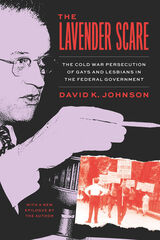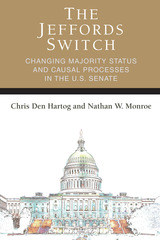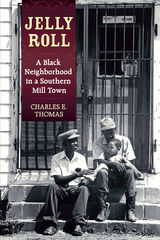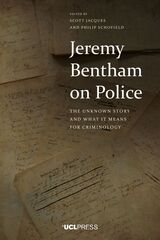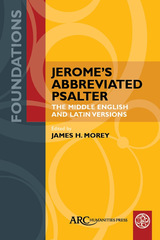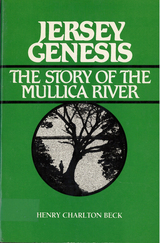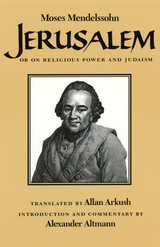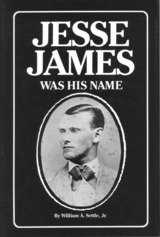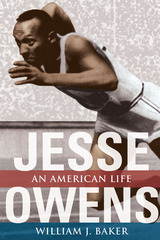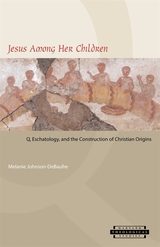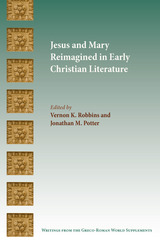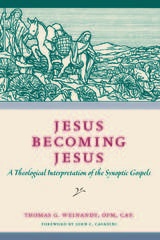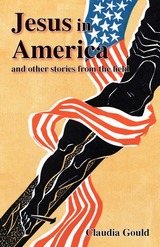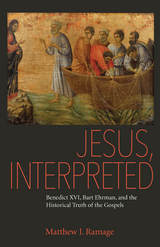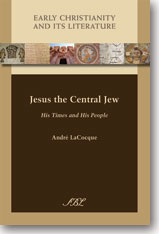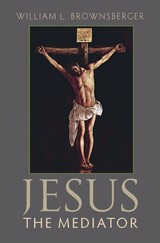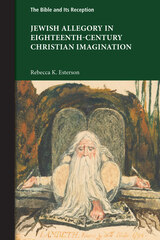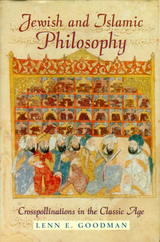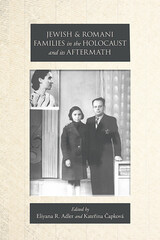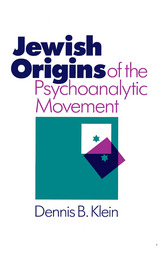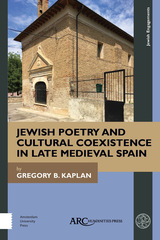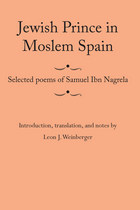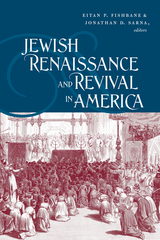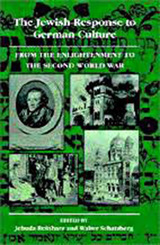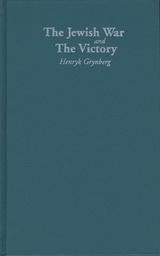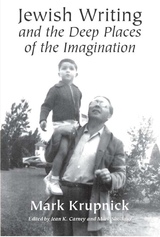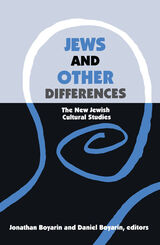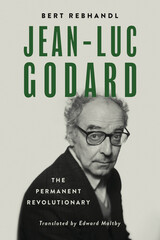 Jean-Luc Godard: The Permanent Revolutionary
Bert Rebhandl, translated by Edward Maltby
University of Wisconsin Press, 2023 In this biography, now translated into English for the first time, Bert Rebhandl provides a balanced evaluation of the work of one of the most original and influential film directors of all time: Jean-Luc Godard (1930–2022). In this sympathetic yet critical overview, he argues that Godard's work captured the revolutionary spirit of Paris in the late 1960s as no other filmmaker has dared, and in fact reinvented the medium.
Rebhandl skillfully weaves together biographical details; information about the cultural, intellectual, and cinematic milieu over the decades; and descriptions of Godard’s most significant films to support his assertion that the director was a permanent revolutionary—always seeking new ways to create, understand, and comment on film within a larger context. He views Godard as an artist consistently true to himself while never ceasing to change and evolve, often in unexpected, radical, and controversial ways.
Rebhandl is known as a journalist with deep insights and lucid prose. Despite the wealth of material to analyze, he neither gets lost in the details nor offers a superficial gloss, even while directly tackling such topics as the long-standing charges of antisemitism against Godard and his oeuvre. This volume will be welcome to both casual fans and dedicated devotees.
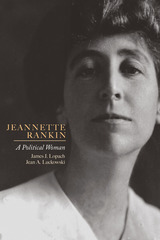 Jeannette Rankin: A Political Woman
James J. Lopach
University Press of Colorado, 2015 "If I had my life to live over, I would do it all again, but this time I would be nastier."
—Jeannette Rankin (1880-1973)
Jeannette Rankin, the first woman elected to Congress, stands tall among American icons. The representative from Montana won her seat at a time when women didn't have the right to vote in most states. Her firm stances inspired both admiration and fury across party lines, and she gained nearly canonical status among feminists and pacifists. In Jeannette Rankin: A Political Woman, James Lopach and Jean Luckowski demythologize Rankin, showing her to be a talented, driven, and deeply divided woman.
Until now, no biography has explored Rankin's inconsistencies. The authors extensively consulted the correspondence of her family members and contemporaries, uncovering ties between her politics and her familial and personal relationships. They reveal how she succeeded through her wealthy brother's influence as well as her own extraordinary efforts; how she drew inspiration not from her rural roots but from the radical hotbed of Greenwich Village; and how she championed an independent, woman-centered life while deferring to family.
Revealing her complexities along with her accomplishments, Jeannette Rankin: A Political Woman will be the definitive biography of this path-breaking politician for years to come.
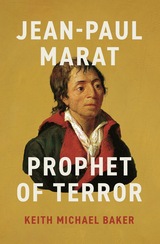 Jean-Paul Marat: Prophet of Terror
Keith Michael Baker
University of Chicago Press, 2025 A landmark biography of one of the most notorious and controversial protagonists of the French Revolution—Jean-Paul Marat.
Who better to pen an authoritative biography of Jean-Paul Marat (1743–93) than preeminent historian of France Keith Michael Baker? Decades in the making, this monumental work takes readers on a journey through the intriguing, sometimes shocking life of this writer and thinker.
Starting with Marat’s Swiss family and upbringing, Baker then sheds light on his early years in England, his career as an aspiring scientist in Paris, his gradual transformation from impassioned pamphleteer to revolutionary newspaperman, and, finally, his murder and martyrdom. Throughout, Baker offers readers the unique opportunity to reconsider the outbreak and development of the French Revolution through Marat’s eyes and in his own words. To help make sense of Marat’s trajectory, he shows how his violent and incendiary public calls to render unseen forces visible, to inject immediacy into an increasingly abstract modern world, would transform classical republicanism into the language of Terror.
Far beyond a standard rendering of Marat’s life and its milestones, this biography offers readers an opportunity to see the French Revolution as never before, through the perspective of one of its major figures. Baker’s book reveals how someone like Marat could go from translating Newton and engaging with Franklin to calling for an ever-growing number of heads to roll—a transformation as chilling as ever.
 Jean-Paul Sartre: Hated Conscience of His Century, Volume 1: Protestant or Protester?
John Gerassi
University of Chicago Press, 1989 Countless biographers have tried to unveil the real Jean-Paul Sartre without his consent or cooperation. Only John Gerassi—the "non-godson" of Sartre, an atheist—was honored with the responsibility of being Sartre's official biographer. After drafting the commission with Sartre on the back of a menu at La Coupole, Gerassi recorded over one hundred hours of interviews with him between 1974 and 1979, and another hundred hours with Sartre's friends, colleagues, and enemies. Gerassi also immersed himself in Sartre's literary, philosophical, and personal writings. Gerassi had access to all of Sartre's files, unpublished manuscripts, and extensive notes for planned but undelivered lectures. Simone de Beauvoir gave many of Sartre's unpublished letters to Gerassi as well. Sartre trusted the integrity of Gerassi so completely that he considered Gerassi's biography to be the continuation of his own autobiography, Les mots. As a personal friend, Gerassi writes with advantages shared by no other biographer of Sartre.
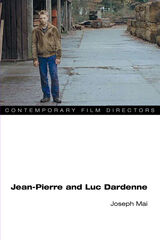 Jean-Pierre and Luc Dardenne
Joseph Mai
University of Illinois Press, 2010 For well over a decade, Jean-Pierre and Luc Dardenne have produced highly original and ethically charged films that immerse their audiences in an intense and embodied viewing experience. Their work has consistently attracted international recognition, including the rare feat of two Palmes d'Or at Cannes. In this first book-length study of the Belgian brothers, Joseph Mai delivers sophisticated close analyses of their directorial style and explores the many philosophical issues dealt with in their films (especially the ethics of Emmanuel Levinas). Mai discusses the Dardennes' varied and searching career from its inception in the late 1970s, starting with the working-class political consciousness and lost utopias of their documentary period; passing through their transition toward fictional narrative, experimental techniques, and familial themes; and finishing with a series of in-depth and philosophically informed interpretations of the brothers' more recent work. In such highly influential films such as La promesse, Rosetta, The Son, and The Child, the brothers have recast filmmaking through what Mai calls a "sensuous realism"--realism capable of touching the audience with the most compelling problems and moral dilemmas of contemporary society. This volume also features an interview in which the Dardennes discuss their approach to film production and the direction of actors.
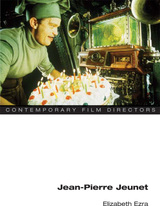 Jean-Pierre Jeunet
Elizabeth Ezra
University of Illinois Press, 2007 This is the first book on Jean-Pierre Jeunet, the popular and critically acclaimed director of films such as Amélie, Delicatessen, A Very Long Engagement, Alien Resurrection, and City of Lost Children. Jeunet's work exemplifies Europe's engagement with Hollywood, while at the same time making him a figurehead of the critically overlooked, specifically French tradition of the cinema of the fantastic. Having garnered both commercial success and critical esteem in genres such as science fiction, fantasy, romantic comedy, and the war epic, Jeunet's work nevertheless engages with key aspects of French history and contemporary French culture. This study analyzes the director's major films, including those he made with Marc Caro, and his early short works. Elizabeth Ezra brings a new perspective to the study of Jeunet's work, uncovering instances of repressed historical trauma involving France's role in Algeria and the Second World War. The book includes a commentary by Jeunet himself on his career and corpus of films.
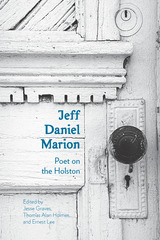 Jeff Daniel Marion: Poet on the Holston
Ernest Lee
University of Tennessee Press, 2015 The author of nine volumes of poetry and numerous other writings, the editor of several literary journals, the recipient of copious awards, including the James Still Award from the Fellowship of Southern Writers, and a longtime teacher and mentor, East Tennessee native Jeff Daniel Marion has come to be known as one of the most significant and beloved voices in Appalachian literature over the past four decades. The twenty-one pieces in this illuminating collection range from examinations of Marion’s poetry to considerations of his teaching career and influence on students, writers, and artists throughout the region and beyond.
Acclaimed poet, novelist, and historian Robert Morgan writes about how Marion affected his development as a writer and the key role Marion has played in bringing Appalachian literature into its own. Scholar Randall Wilhelm’s essay, meanwhile, expands our appreciation for Marion not only as a poet but as a visual artist, tracing the connection between his photography and poetic imagery. Also included are essays by John Lang on the ways in which Marion’s poetry “gives voice to a spiritual vision of nature’s sacramental identity,” Gina Herring on how the poet’s father has served as his muse, and George Ella Lyon on the power of story in Marion’s picture book for children, Hello, Crow. Other features include an autobiographical essay by Marion himself, an interview conducted by coeditor Jesse Graves, and a bibliography and timeline that summarize Marion’s life and career.
In the book’s introduction, Ernest Lee notes that in the poem “Boundaries,” from his first published collection, the young Marion “dedicated himself to his place, to the land and his heritage . . . welcoming whatever may come with a firm faith that ultimately his life as a poetic laborer will bring him to a true, sharp vision.” The eloquent contributions to this volume reveal just how fully that dedication has paid off.
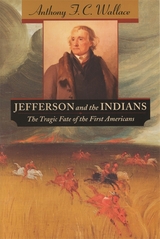 Jefferson and the Indians: The Tragic Fate of the First Americans
Anthony F. C. Wallace
Harvard University Press, 1999 In Thomas Jefferson's time, white Americans were bedeviled by a moral dilemma unyielding to reason and sentiment: what to do about the presence of black slaves and free Indians. That Jefferson himself was caught between his own soaring rhetoric and private behavior toward blacks has long been known. But the tortured duality of his attitude toward Indians is only now being unearthed.
In this landmark history, Anthony Wallace takes us on a tour of discovery to unexplored regions of Jefferson's mind. There, the bookish Enlightenment scholar--collector of Indian vocabularies, excavator of ancient burial mounds, chronicler of the eloquence of America's native peoples, and mourner of their tragic fate--sits uncomfortably close to Jefferson the imperialist and architect of Indian removal. Impelled by the necessity of expanding his agrarian republic, he became adept at putting a philosophical gloss on his policy of encroachment, threats of war, and forced land cessions--a policy that led, eventually, to cultural genocide.
In this compelling narrative, we see how Jefferson's close relationships with frontier fighters and Indian agents, land speculators and intrepid explorers, European travelers, missionary scholars, and the chiefs of many Indian nations all complicated his views of the rights and claims of the first Americans. Lavishly illustrated with scenes and portraits from the period, Jefferson and the Indians adds a troubled dimension to one of the most enigmatic figures of American history, and to one of its most shameful legacies.
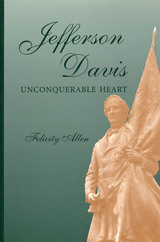 Jefferson Davis, Unconquerable Heart
Felicity Allen
University of Missouri Press, 2000
Preeminent Civil War historian Frank Vandiver always longed to see an interpretive biography of Jefferson Davis. Finally, more than twenty years after Vandiver expressed that wish, publication of Jefferson Davis, Unconquerable Heart makes such an interpretive biography available.
Felicity Allen begins this monumental work with Davis's political imprisonment at the end of the Civil War and masterfully flashes back to his earlier life, interweaving Davis's private life as a schoolboy, a Mississippi planter, a husband, a father, and a political leader. She follows him from West Point through army service on the frontier, his election to the U.S. House of Representatives, his regimental command in the Mexican War, his service as U.S. secretary of war and senator, and his term as president of the Confederate States of America.
Although Davis's family is the nexus of this biography, friends and enemies also play major roles. Among his friends intimately met in this book are such stellar figures as Andrew Jackson, John C. Calhoun, Zachary Taylor, Franklin Pierce, Albert Sidney Johnston, and Robert E. Lee.
With the use of contemporary accounts and Davis's own correspondence, Jefferson Davis, Unconquerable Heart casts new light upon this remarkable man, thawing the icy image of Davis in many previous accounts. Felicity Allen shows a strong, yet gentle man; a stern soldier who loved horses, guns, poetry, and children; a master of the English language, with a dry wit; a man of powerful feelings who held them in such tight control that he was considered cold; and a home-loving Mississippian who was drawn into a vortex of national events and eventual catastrophe. At all times, "duty, honor, country" ruled his mind. Davis's Christian view of life runs like a thread throughout the book, binding together his devotion to God, his family, and the land.
Jefferson Davis, Unconquerable Heart brings Davis to life in a way that has never been done before. The variety of his experience, the breadth of his learning, and the consistency of his beliefs make this historical figure eminently worth knowing.
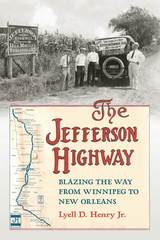 The Jefferson Highway: Blazing the Way from Winnepeg to New Orleans
Lyell D. Henry Jr.
University of Iowa Press, 2016 Today American motorists can count on being able to drive to virtually any town or city in the continental United States on a hard surface. That was far from being true in the early twentieth century, when the automobile was new and railroads still dominated long-distance travel. Then, the roads confronting would-be motorists were not merely bad, they were abysmal, generally accounted to be the worst of those of all the industrialized nations.
The plight of the rapidly rising numbers of early motorists soon spawned a “good roads” movement that included many efforts to build and pave long-distance, colorfully named auto trails across the length and breadth of the nation. Full of a can-do optimism, these early partisans of motoring sought to link together existing roads and then make them fit for automobile driving—blazing, marking, grading, draining, bridging, and paving them. The most famous of these named highways was the Lincoln Highway between New York City and San Francisco. By early 1916, a proposed counterpart coursing north and south from Winnipeg to New Orleans had also been laid out.
Called the Jefferson Highway, it eventually followed several routes through Minnesota, Iowa, Missouri, Kansas, Oklahoma, Texas, Arkansas, and Louisiana. The Jefferson Highway, the first book on this pioneering road, covers its origin, history, and significance, as well as its eventual fading from most memories following the replacement of names by numbers on long-distance highways after 1926. Saluting one of the most important of the early named highways on the occasion of its 100th anniversary, historian Lyell D. Henry Jr. contributes to the growing literature on the earliest days of road-building and long-distance motoring in the United States. For readers who might also want to drive the original route of the Jefferson Highway, three chapters trace that route through Iowa, pointing out many vintage features of the roadside along the way. The perfect book for a summer road trip!
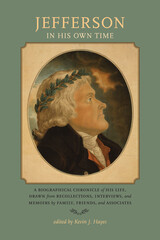 Jefferson in His Own Time: A Biographical Chronicle of His Life, Drawn from Recollections, Interviews, and Memoirs by Family, Friends, and Associates
Kevin J. Hayes
University of Iowa Press, 2012 In this volume, Kevin J. Hayes collects thirty accounts of Thomas Jefferson written by his granddaughters, visiting dignitaries, fellow politicians, and others who knew him as a family man, public servant, intellectual, and institution builder. The letters and reminiscences of those who knew Jefferson personally reveal him to be a warm, funny man, quite unlike the solemn statesman so often limned in biographies. To friends and enemies alike he was the model of a republican gentleman, profoundly knowledgeable in philosophy and natural history, able to converse in several languages, and capable of great wit but contemptuous of ceremony and fancy dress. Through these excerpts, we can see the nation’s third president as his family knew him—a loving husband, father, and grandfather—and as his peers did, as a tireless public servant with a fondness for tall tales.
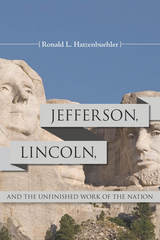 Jefferson, Lincoln, and the Unfinished Work of the Nation
Ronald L. Hatzenbuehler
Southern Illinois University Press, 2016 Although the nation changed substantially between the presidential terms of Thomas Jefferson and Abraham Lincoln, these two leaders shared common interests and held remarkably similar opinions on many important issues. In Jefferson, Lincoln, and the Unfinished Work of the Nation, Ronald L. Hatzenbuehler describes the views of two of our nation’s greatest presidents and explains how these views provide valuable insight into modern debates.
In this groundbreaking new study—the first extended examination of the ideas of Lincoln and Jefferson—Hatzenbuehler provides readers with a succinct guide to their opinions, comparing and contrasting their reasoned judgments on America’s republican form of government. Each chapter is devoted to one key area of common interest: race and slavery, the pros and cons of political parties, state rights versus federal authority, religion and the presidency, presidential powers under the Constitution, or the proper political economy for a republic. Relying on the pair’s own words in their letters, writings, and speeches, Hatzenbuehler explores similarities and differences between the two men on contentious issues. Both, for instance, wrote that they were antislavery, but Jefferson never acted on this belief, while Lincoln moved toward a constitutional amendment banning slavery. The book’s title, taken from the Gettysburg Address, builds on both presidents’ expectations that Americans should dedicate themselves to the unfinished work of returning the nation to its founding principles.
Jefferson and Lincoln wrestled with many of the same issues and ideas that intrigue and divide Americans today. In his thought-provoking work, Hatzenbuehler details how the two presidents addressed these issues and ideas, which are essential to understanding not only America’s history but also the continuing influence of the past on the present.
 The Jefferson National Forest: An Appalachian Environmental History
Will Sarvis
University of Tennessee Press, 2011
The highland forests of southwestern Virginia were a sacred land to Native Americans and one they relied upon for sustenance. After European contact, this beautiful country drew successive waves of settlers and visitors, and for a brief yet intense period, industrialists rapaciously exploited its timber resources, particularly in the higher elevations where the woodlands had survived the nearby valleys’ generations of agricultural use. This is the story of how various peoples have regarded this land over the centuries and how, starting in the early twentieth century, the federal government acquired 700,000 acres of it to create what is now the Jefferson National Forest (JNF).
Will Sarvis’s in-depth history explores the area’s significance to such native tribes as the Cherokee and Shawnee, for whom it functioned as a buffer zone in late prehistory, and its attraction for nineteenth-century romantics who, arriving in stagecoaches, became the area’s first tourists. Aggressive commercial logging gave way to the arrival of the U.S. Forest Service, which patched the JNF together through successive purchases of privately owned land and instituted a more regulated harvesting of various timber resources. Public support for Forest Service policy during the Depression and World War II was followed by controversies, including the use of eminent domain. In presenting this history, Sarvis probes the many complexities of land stewardship and, in analysis that is sure to spark debate, discusses how and why the JNF could abandon clear-cutting and return to traditional selective tree management.
An ongoing experiment in democratic land use, the JNF contains many lessons about our relationship with the natural environment. This book delineates those lessons in a clear and compelling narrative that will be of great interest to policy makers, activists, and indeed anyone drawn to American environmental history and Appalachian studies.
 Jefferson's Wolf: A Founding Father's Troubling Answer to the Problem of Slavery
Christa Dierksheide and Nicholas Guyatt
Harvard University Press A decisive reassessment of Thomas Jefferson’s long-debated views on slavery, showing that his chief antislavery strategy was racial exclusion: the removal of emancipated Black people from the United States.
Toward the end of his life, Thomas Jefferson made his most famous statement about American slavery: “We have the wolf by the ear, and we can neither hold him safely, nor let him go.” Presenting abolition as both necessary and perilous, the phrase has long been relied upon to explain an apparent paradox: despite publicly opposing slavery for four decades, Jefferson had made no progress toward Black freedom in his political career by the time he died in 1826. Nor had he done so in his expansive household, where he enslaved more than 600 people, including Sally Hemings and the four children he fathered with her.
Christa Dierksheide and Nicholas Guyatt argue that the key to understanding Jefferson’s antislavery position is his commitment to racial exclusion. Jefferson believed that the principal reason to abolish slavery was the threat of a massive slave revolt, but he viewed the presence of free Black people in the new nation as no less dangerous. To avert racial violence, Jefferson argued, the gradual abolition of slavery had to be paired with Black exile. Even when challenged by white and Black contemporaries with more expansive views of American belonging, Jefferson held fast to his vision for a white republic.
Neither an egalitarian antiracist nor a proslavery apologist, Jefferson became the most influential advocate for racial separation in the early United States. Charting the evolution of his thought across the nation’s formative decades, Jefferson’s Wolf is a surprising and provocative account of the problem of slavery in the founding era.
The Jeffords Switch: Changing Majority Status and Causal Processes in the U.S. Senate
Chris Den Hartog and Nathan W. Monroe
University of Michigan Press, 2019 Senator Jim Jeffords left the Republican Party in May 2001 and became an independent. Because he agreed to vote with the Democrats on organizational votes, this gave that party a 51–49 majority in the Senate.
Using the “Jeffords switch,” Chris Den Hartog and Nathan W. Monroe examine how power is shared and transferred in the Senate, as well as whether Democratic bills became more successful after the switch. They also use the data after the switch, when the Republican Party still held a majority on many Democratic Party-led committees, to examine the power of the committee chairs to influence decisions. While the authors find that the majority party does influence Senate decisions, Den Hartog and Monroe are more interested in exploring the method and limits of the majority party to achieve its goals.
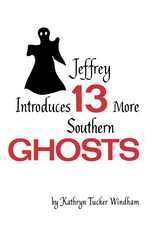 Jeffrey Introduces Thirteen More Southern Ghosts: Commemorative Edition
Kathryn Tucker Windham
University of Alabama Press, 2015 A commemorative edition of the beloved and best-selling second book in famed folklorist Kathryn Tucker Windham’s ’s southern ghosts series.
Jeffrey was the resident apparition in the Selma, Alabama, home of nationally-known folklorist Kathryn Tucker Windham and the inspiration for Windham’s best-selling collection of macabre tales that reveal two hundred years of Alabama’s ghostly secrets, Thirteen Alabama Ghosts and Jeffrey. One of the most popular books ever published in the state, generations of Alabama children and students have been thrilled and chilled by Windham’s spectral legends.
Following the overwhelming success of Thirteen Alabama Ghosts and Jeffrey, Windham and Jeffrey began to journey across the South assembling a second collection of ghastly tales that repeat Windham’s winning combination of traditional folklore, Southern history and culture, and family-friendly story-telling. In Jeffrey Introduces Thirteen More Southern Ghosts, Windham’s disembodied friend roams the states of Kentucky, Tennessee, Georgia, Mississippi, Louisiana, and Florida to recall thirteen more timeless, spine-tingling tales of baneful and melancholy spirits that spook the most stoic heart.
Opening this volume is “The Girl Nobody Knew.” One midsummer night in the genteel Kentucky mineral spring resort of Harrodsburg, a beautiful lady arrived at the town’s grand hotel. The belle danced late into the night with the town’s smitten gallants only to expire suddenly with the notes of the last quadrille. The spooked residents of Harrodsburg guard a grave you can see to this day. Readers then visit the world-famous Bell Witch of Robinson County, Tennessee. Jeffrey also makes his first trip to old New Orleans to reveal a revenant in residence on Royal Street before continuing his ghostly progress across Dixie.
This new edition returns Jeffrey Introduces Thirteen More Southern Ghosts to its original format in jacketed cloth full of original, black-and-white illustrations in a handsome keepsake edition perfect for gift-giving and for families, folklorists of all ages, and libraries.
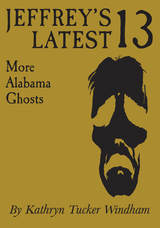 Jeffrey's Latest Thirteen: More Alabama Ghosts, Commemorative Edition
Kathryn Tucker Windham
University of Alabama Press, 2016 A deluxe, commemorative edition of a beloved collection of ghostly stories from famed southern author and folklorist Kathryn Tucker Windham’s home state of Alabama
Accompanied by her faithful companion, Jeffrey, a friendly spirit who resided in her home in Selma, Alabama, Kathryn Tucker Windham traveled the South, visiting the sites of spectral legends in Mississippi, Georgia, and Tennessee, among other places. In Jeffrey’s Latest Thirteen: More Alabama Ghosts, a sequel to her landmark Thirteen Alabama Ghosts and Jeffrey, Windham introduces readers to thirteen more of Jeffrey's ghostly acquaintances, each with the charm and universal appeal that has created hundreds of thousands of Jeffrey fans.
Among the other hair-raising tales in this collection, Windham spotlights the apparitions of academia. From the three Yankee soldiers who haunt the University of Alabama’s Civil War–era Little Round House to the Confederate soldier who resides in the University Chapel at Auburn University, Alabama’s institutions of higher learning seem to have more than a few paranormal pupils.
Photographs of the sites about which Windham writes are one of the best-loved features of her series of “Jeffrey the Ghost” books. Jeffrey’s Latest Thirteen features the image of a beautiful child who, though not photographed in life, reappeared long enough to be photographed with his bereaved father's borrowed camera. Bewitched readers will find the startling photograph of the child in the next-to-last chapter, just pages before he book’s photograph of Windham’s own spectral muse, Jeffrey.
This commemorative edition returns Windham’s thrilling classic to its original 1982 keepsake quality and includes a new afterword by the author’s children.
 Jelliffe: American Psychoanalyst and Physician and His Correspondence with Sigmund Freud and C. G. Jung
John C. Burnham
University of Chicago Press, 1983 Smith Ely Jelliffe (1866-1945) was a distinguished American physician who became one of the first psychoanalysts in the world. This book, an account of his life and times, also includes his unpublished and hiterto unknown correspondence with Sigmund Freud and C. G. Jung, a correspondence of nearly thirty years which continued long after the historic break between Freud and Jung. John Burnham, a well-known historian of medicine and psychoanalysis, and William McGuire, the executive editor of Jung's collected works, have based this book on the recently discovered Jelliffe papers, an important collection once believed to have been lost in a fire.
Jelliffe's colorful and versatile career led him from botany and neurology (he was coauthor of a neurology text that remained standard for some forty years) to psychiatry, psychoanalysis (of which he was a founding father in the United States), and psychosomatic medicine (in which he also pioneered). Jelliffe also made outstanding contributions to medical journalism. With William Alanson White he founded the Psychoanalytic Review, and his work as editor of the Journal of Nervous and Mental Disease from 1902 to 1944 may have set a record for editorial longevity. Jelliffe was a charismatic speaker and teacher who in all his roles induced physicians and other thinkers to explore new ideas and ways of thinking.
Jelliffe's correspondence with Jung and Freud illuminates the personal and professional lives of the three men. The letters help to clarify concepts in both the Jungian and Freudian schools. The shifting emphasis of Jelliffe's relationships with the two masters of psychoanalysis—first when the two were colleagues, then for the greater span of time when they were rivals and adversaries—is revealing of Jenlliffe's own flexible views.
Jelliffe, furthermore, provides insights into the history of medicine and medical institutions and customs through Jelliffe's frank accounts of the developing medical profession in America. Jelliffe describes, for example, what it was like for a young M.D. to set up an economically viable practice in the 1890s. In addition, Burnham explores the problem of measuring the influence of a man like Jelliffe upon the history of ideas and institutions.
Jelly Roll: A Black Neighborhood in a Southern Mill Town
Charles Thomas
University of Arkansas Press, 2012 Jelly Roll, a small community of African Americans living in company housing outside the Calion Lumber Company in Calion, Arkansas, is the subject of this classic Arkansas ethnography written by Charles E. Thomas, an anthropologist whose family owned the mill. Originally published in 1986, Jelly Roll combines Thomas’s unique perspective as both an academician and the grandson of the sawmill’s founder. Thomas conducted extensive interviews covering three generations among the eighty-four households forming this community, illuminating the residents’ lives in an unusually thorough and nuanced fashion. Now back in print and enhanced with later interviews revealing attitudes of growing restlessness over the slow movement toward racial equality and opportunity, Jelly Roll will be a welcome reference for anyone interested in African American studies, the South, or the sawmill industry.
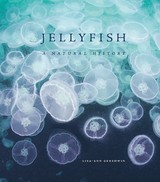 Jellyfish: A Natural History
Lisa-ann Gershwin
University of Chicago Press, 2016 Jellyfish, with their undulating umbrella-shaped bells and sprawling tentacles, are as fascinating and beautiful as they are frightening and dangerous. They are found in every ocean at every depth, and they are the oldest multi-organed life form on the planet, having inhabited the ocean for more than five hundred million years. In many places they are also vastly increasing in number, and these population blooms may be an ominous indicator of the rising temperatures and toxicity of the world’s oceans.
Jellyfish presents these aquarium favorites in all their extraordinary and captivating beauty. Fifty unique species, from stalked jellyfish to black sea nettles, are presented in stunning color photographs along with the most current scientific information on their anatomy, history, distribution, position in the water, and environmental status. Foremost jellyfish expert Lisa-ann Gershwin provides an insightful look at the natural history and biology of each of these spellbinding creatures, while offering a timely take on their place in the rapidly changing and deteriorating condition of the oceans. Readers will learn about immortal jellyfish who live and die and live again as well as those who camouflage themselves amid sea grasses and shells, hiding in plain sight.
Approachably written and based in the latest science and ecology, this colorful book provides an authoritative guide to these ethereal marine wonders.
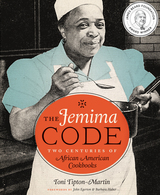 The Jemima Code: Two Centuries of African American Cookbooks
By Toni Tipton-Martin; forewords by John Egerton and Barbara Haber
University of Texas Press, 2015 Winner, James Beard Foundation Book Award, 2016
Art of Eating Prize, 2015
BCALA Outstanding Contribution to Publishing Citation, Black Caucus of the American Library Association, 2016 Women of African descent have contributed to America’s food culture for centuries, but their rich and varied involvement is still overshadowed by the demeaning stereotype of an illiterate “Aunt Jemima” who cooked mostly by natural instinct. To discover the true role of black women in the creation of American, and especially southern, cuisine, Toni Tipton-Martin has spent years amassing one of the world’s largest private collections of cookbooks published by African American authors, looking for evidence of their impact on American food, families, and communities and for ways we might use that knowledge to inspire community wellness of every kind. The Jemima Code presents more than 150 black cookbooks that range from a rare 1827 house servant’s manual, the first book published by an African American in the trade, to modern classics by authors such as Edna Lewis and Vertamae Grosvenor. The books are arranged chronologically and illustrated with photos of their covers; many also display selected interior pages, including recipes. Tipton-Martin provides notes on the authors and their contributions and the significance of each book, while her chapter introductions summarize the cultural history reflected in the books that follow. These cookbooks offer firsthand evidence that African Americans cooked creative masterpieces from meager provisions, educated young chefs, operated food businesses, and nourished the African American community through the long struggle for human rights. The Jemima Code transforms America’s most maligned kitchen servant into an inspirational and powerful model of culinary wisdom and cultural authority.
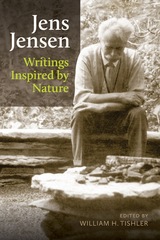 Jens Jensen: Writings Inspired by Nature
William H. Tishler
Wisconsin Historical Society Press, 2012 Jens Jensen (1860-1951) was one of America's most distinguished landscape architects and a pioneering conservationist. During his long and productive career, this Danish-born visionary worked for and with some of the country's most prominent citizens and architects, including Henry Ford, Louis Sullivan, and Frank Lloyd Wright. He became internationally renowned for his design of landscapes throughout the Midwest and beyond, his contributions to the American conservation movement, and his design philosophy that emphasized the significance of nature in people's lives. He found inspiration in the landscape, particularly the plants native to a region, and was an environmentalist long before the term became popular.
Today, Jensen is perhaps best remembered for establishing The Clearing on Wisconsin's Door County Peninsula. But the outspoken views in his writings - many of which were included in ephemeral planning reports, early newspapers, and now out-of-print journals - are virtually forgotten, with the exception of his two small books. "Jens Jensen: Writings Inspired by Nature" is an anthology of Jensen's most significant yet lesser-known articles, including a "Saturday Evening Post" piece that enabled him to reach the largest audience of his publishing career. The scope of Jensen's thoughts represented in this collection will further solidify his legacy and rightful place alongside conservation leaders such as John Muir and Aldo Leopold.
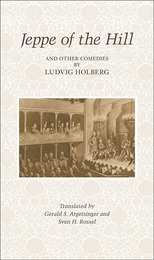 Jeppe of the Hill and Other Comedies by Ludvig Holberg
Translated by Gerald S. Argetsinger and Sven H. Rossel
Southern Illinois University Press, 1990 These eight comedies comprise the most extensive collection of Ludvig Holberg plays ever offered in the English language. The translators’ general introductions establish a cultural context for the comedies and break new ground in understanding the importance of Holberg’s comic aesthetic. Argetsinger’s extensive experience in theatre and Rossel’s preeminence as a Scandinavian Studies scholar assure that the translations are not only accurate but stage-worthy. The collection opens with The Political Tinker, the first Danish play to be produced in the new Danish Theatre, and ends with The Burial of Danish Comedy, literally the funeral service for the bankrupt theatre. Three more of Holberg’s renowned character comedies follow, Jean de France, Jeppe of the Hill, and Erasmus Montanus, along with his literary satire Ulysses von Ithacia. The final two plays demonstrate his ability to write shorter comic works, The Christmas Party, a scathing comedy of manners, and Pernille’s Brief Experience as a Lady, a situation comedy that satirizes the practice of baby-switching.
Jeremy Bentham on Police: The Unknown Story and What It Means for Criminology
Edited by Scott Jacques and Philip Schofield
University College London, 2021 Recovering Bentham’s thoughts on policing and what they mean for criminology today.
Jeremy Bentham theorized the panopticon as modern policing emerged across the British Empire, yet while his theoretical writing became canonical in criminology, his perspective on the police remains obscure. Jeremy Bentham on Police recovers the reformer’s writings on policing alongside a series of essays that demonstrate their significance to the past, present, and future of criminology.
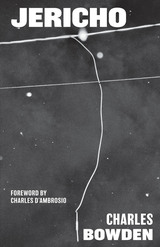 Jericho
By Charles Bowden, Foreword by Charles D'Ambrosio
University of Texas Press, 2020 When Charles Bowden died in 2014, he left behind an archive of unpublished manuscripts. Jericho marks the fifth installment in his venerable “Unnatural History of America” sextet. In it he invokes the cycles of destruction and rebirth that have defined the ancient biblical city over millennia. From the ruins of Jericho’s walls Bowden reflects on the continuum of war and violence—the many conquests of the Americas; the US-Mexican War; the Vietnam War; and the ongoing militarization of our southern border—to argue against the false promise of security that is offered when men “build that wall.” Walls—both real and imagined—will always come tumbling down. Along the way, Bowden tells stories of loss and violence, like that of David Hartley, who mysteriously vanishes on Falcon Lake; of murdered drug runners and their cartel bosses; and of a haunted sicario, or hitman, who is running from his past and compulsively confesses his sins as he searches for an absolution that will never come. Set against these scenes of trauma and violence are Bowden’s gorgeous meditations on nature: dancing cranes, soaring eagles, winding paths that traverse mountains, lakes, and deserts. And threaded throughout are the heroic narratives of men like Martin Luther King Jr., who defied the boundaries that surrounded him and was able to reshape the arc of history. Jericho is a remarkable affirmation of our shared humanity and a timely rejection of violence and nationalism by one of our most prophetic writers working at the height of his powers.
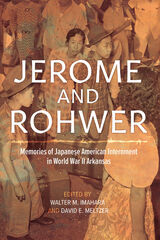 Jerome and Rohwer: Memories of Japanese American Internment in World War II Arkansas
Walter M. Imahara
University of Arkansas Press, 2022 Not long after the attack on Pearl Harbor that drew the United States into World War II, the federal government rounded up more than a hundred thousand people of Japanese descent—both immigrants and native-born citizens—and began one of the most horrific mass-incarceration events in US history. The program tore apart Asian American communities, extracted families from their homes, and destroyed livelihoods as it forced Japanese Americans to various “relocation centers” around the country. Two of these concentration camps—the Jerome and Rohwer War Relocation Centers—operated in Arkansas.
This book is a collection of brief memoirs written by former internees of Jerome and Rohwer and their close family members. Here dozens of individuals, almost all of whom are now in their eighties or nineties, share their personal accounts as well as photographs and other illustrations related to their life-changing experiences. The collection, likely to be one of the last of its kind, is the only work composed solely of autobiographical remembrances of life in Jerome and Rohwer, and one of the very few that gathers in a single volume the experiences of internees in their own words.
What emerges is a vivid portrait of lives lived behind barbed wire, where inalienable rights were flouted and American values suspended to bring a misguided sense of security to a race-obsessed nation at war. However, in the barracks and the fields, the mess halls and the makeshift gathering places, values of perseverance, tolerance, and dignity—the gaman the internees shared—gave significance to a transformative experience that changed forever what it means to call oneself an American.
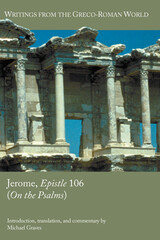 Jerome, Epistle 106 (On the Psalms)
Michael Graves
SBL Press, 2022 A fresh interpretation of the nature, purpose, and date of Jerome’s Epistle 106
In this volume of the Writings from the Greco-Roman World series, Michael Graves offers the first accessible English translation and commentary on Jerome’s Epistle 106, an important work of patristic biblical interpretation. In his treatise Jerome discusses different textual and exegetical options according to various Greek and Latin copies of the Psalms with input from the Hebrew. Epistle 106 provides insightful commentary on the Gallican Psalter, Jerome’s translation of Origen’s hexaplaric edition. Jerome’s work offers a unique window into the complex textual state of the Psalter in the late fourth century and serves as an outstanding example of ancient philological scholarship on the Bible. Graves’s translation and commentary is an essential resource for scholars and students of patristic exegesis, biblical textual criticism, and late antique Christianity.
Jerome’s Abbreviated Psalter: The Middle English and Latin Versions
James H. Morey
Arc Humanities Press, 2019 Jerome’s Abbreviated Psalter was one of the most important collections of psalm verses in the Middle Ages. Commonly found in primers and books of hours, it was the primary medium for lay people to imitate the monastic divine office, even as it offered concessions to harsh personal circumstances. This edition presents the Middle English versions in parallel, followed by the Latin version in the Lincoln Thornton manuscript. An introductory review considers the psalter in general and the origins of abbreviated psalters in particular. Jerome’s Abbreviated Psalter is the most widespread text in the abbreviated psalter tradition and it illustrates an important aspect of lay devotional life from the eighth to the sixteenth century. The English versions contribute both to the history of English prose and to the history of biblical translation in English.
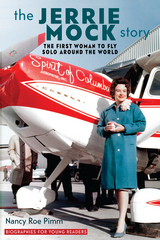 The Jerrie Mock Story: The First Woman to Fly Solo around the World
Nancy Roe Pimm
Ohio University Press, 2016 A Junior Library Guild selection
Society of Children’s Book Writers and Illustrators Official 2016 Summer Reading List In this biography for middle-grade readers, Nancy Roe Pimm tells the story of Geraldine “Jerrie” Mock, the first woman to fly solo around the world. In her trusty Cessna, The Spirit of Columbus—also known as Charlie—she traveled from Columbus, Ohio, on an eastward route that totaled nearly twenty-three thousand miles and took almost a month. Overcoming wind, ice, mechanical problems, and maybe even sabotage, Mock persevered. Mock caught the aviation bug at seven years old, when she rode in a Ford Trimotor plane with her parents. In high school, she displayed a talent for math and science, and she was the only woman in her aeronautical engineering classes at Ohio State University. Although she then settled into domestic life, she never lost her interest in flying. What began as a joking suggestion from her husband to fly around the world prompted her to pursue her childhood dream. But the dream became a race, as another woman, Joan Merriam Smith, also sought to be the first to circle the globe. Even though Mock beat Smith and accomplished what her heroine Amelia Earhart had died trying to do, her feat was overshadowed by the Vietnam War and other world events. Now, Pimm introduces Mock to a new generation of adventurers.
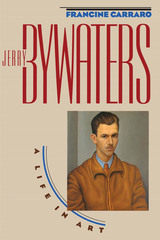 Jerry Bywaters: A Life in Art
By Francine Carraro
University of Texas Press, 1994 As an artist, art critic, museum director, and art educator, Jerry Bywaters reshaped the Texas art world and attracted national recognition for Texas artists. This first full-scale biography explores his life and work in the context of twentieth-century American art, revealing Bywaters' important role in the development of regionalist painting. Francine Carraro delves into all aspects of Bywaters' career. As an artist, Bywaters became a central figure and spokesman for a group of young, energetic painters known as the Dallas Nine (Alexandre Hogue, Everett Spruce, Otis Dozier, William Lester, and others) who broke out of the limitations of provincialism and attained national recognition beginning in the 1930s. As director of the Dallas Museum of Fine Arts, art critic for the Dallas Morning News, and professor of art and art history at Southern Methodist University, Bywaters became a champion of the arts in Texas. Carraro traces his strong supporting role in professionalizing art institutions in Texas and defendlng the right to display art considered "subversive" in the McCarthy era. From these discussions emerges a finely drawn portrait of an artist who used a vocabulary of regional images to explore universal themes. It will be of interest to all students of American studies, national and regional art history, and twentieth-century biography.
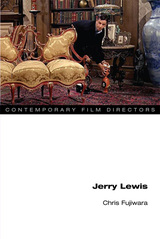 Jerry Lewis
Chris Fujiwara
University of Illinois Press, 2009 Well known for his slapstick comedic style, Jerry Lewis has also delighted worldwide movie audiences with a directing career spanning five decades. One of American cinema's great innovators, Lewis made unmistakably personal films that often focused on an ideal masculine image and an anarchic, manic acting out of the inability to assume this image. Films such as The Bellboy, The Errand Boy, Three on a Couch, and The Big Mouth present a series of thematic variations on this tension, in which such questions as how to be a man, how to be popular, and how to maintain relationships are posed within frameworks that set up a liberating and exhilarating confusion of roles and norms. The Nutty Professor and The Patsy are especially profound and painful examinations of the difficulty experienced by Lewis's character in reconciling loving himself and being loved by others. With sharp, concise observations, Chris Fujiwara examines this visionary director of self-referential comedic masterpieces. The book also includes an enlightening interview with Lewis that offers unique commentary on the creation and study of comedy.
 Jersey Blue: Civil War Politics in New Jersey, 1854–1865
Gillette, William
Rutgers University Press, 1994 This political history of New Jersey during the Civil War and the years immediately before and after invites us to rethink New Jersey's role and in particular its relationship to the border states. William Gillette argues that there is little evidence supporting the idea that New Jersey's residents were pro-southern before the war, or even antiwar during it, although attitudes toward the abolition of slavery were more ambivalent. The perspectives Gillette offers in Jersey Blue, from the recruiting ground, the battlefield, and the home front, cast new light on New Jersey's wartime activities, state identity, and our understanding of the interrelationships between New Jersey's national, regional, and state developments.
Gillette takes a broader view of the politics of the Civil War as he touches on the economy, geography, demography, immigration, nativism, conscription, and law. The result is a pioneering history of New Jersey that deepens our understanding of the Civil War.
 Jersey Diners
Peter Genovese
Rutgers University Press, 2006 New Jersey Monthly named Peter Genovese one of the twenty-five "New Jerseyans We Love."
There is nothing more "Jersey" than a diner. Adorning the highways and byways of fully half of the state's 566 municipalities, no one in New Jersey lives far from one. There are more diners here than in any other state, and on top of that, one of the two remaining diner manufacturers is located in the Garden State.
In a year of roadside research, Peter Genovese talked to owners, employees, and customers, and ate more bacon and egg sandwiches than he cares to remember. The result is a funny, revealing book about a beloved American institution. Whether you want to know where and how diners started, who invented eggs served in a skillet, why these twenty-four-hours-a-day eateries are so popular, or, most important, which one has the best French toast, Jersey Diners has the answers.
Packed with facts, trivia, and stories about the owners, employees, and clientele, the book is also complemented with over three hundred evocative, beautiful photos of the buildings, their distinctive dTcor, the food, and the people who love it from Sussex to Salem counties.
This newly revised edition includes a fully updated directory that details where you can find every diner throughout the state!
Jersey Genesis: The Story of the Mullica River
Beck, Henry
Rutgers University Press, 1983 Long regarded as folklife classics, Henry Charlton Beck's books are vivid re-creations of the back roads, small towns, and legends that give New Jersey its special character. Rutgers university Press is pleased to make these important books available again in newly designed editions.
 Jersey Justice: The Story of the Trenton Six
Cathy D. Knepper
Rutgers University Press, 2011 The case of the Trenton Six attracted international attention in its time (1948–1952) and was once known as the “northern Scottsboro Boys case.” Yet, there is no memory of it. The shame of racism evident in the case has been nearly erased from the public record. Now, historian Cathy D. Knepper takes us back to the courtroom to make us aware of this shocking chapter in American history. Jersey Justice: The Story of the Trenton Six begins in 1948 when William Horner, an elderly junk dealer, was murdered in his downtown Trenton shop. Over a two-week period, six local African American men were arrested and charged with collectively killing Horner. Violating every rule in the book, the Trenton police held the six men in incommunicado detention, without warrants, and threatened them until they confessed. At the end of the trial the all-white jury sentenced the six men to die in the electric chair. That might have been the end of the story were it not for the tireless efforts of Bessie Mitchell, the sister of one of the accused men. Undaunted by the refusal of the NAACP and the ACLU to help appeal the conviction of the Trenton Six, Mitchell enlisted the aid of the Civil Rights Congress, ultimately taking the case as far as the New Jersey Supreme Court. Along the way, the Trenton Six garnered the attention and involvement of many prominent activists, politicians, and artists, including Paul Robeson, Thurgood Marshall, Eleanor Roosevelt, Pete Seeger, Arthur Miller, and Albert Einstein. Jersey Justice brings to light a shameful moment in our nation’s history, but it also tells the story of a personal battle for social justice that changed America.
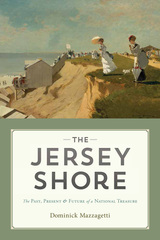 The Jersey Shore: The Past, Present & Future of a National Treasure
Mazzagetti, Dominick
Rutgers University Press, 2018 In The Jersey Shore, Dominick Mazzagetti provides a modern re-telling of the history, culture, and landscapes of this famous region, from the 1600s to the present. The Shore, from Sandy Hook to Cape May, became a national resort in the late 1800s and contributes enormously to New Jersey’s economy today. The devastation of Hurricane Sandy in 2012 underscored the area’s central place in the state’s identity and the rebuilding efforts after the storm restored its economic health.
Divided into chronological and thematic sections, this book will attract general readers interested in the history of the Shore: how it appeared to early European explorers; how the earliest settlers came to the beaches for the whaling trade; the first attractions for tourists in the nineteenth century; and how the coming of railroads, and ultimately automobiles, transformed the Shore into a major vacation destination over a century later. Mazzagetti also explores how the impact of changing national mores on development, race relations, and the environment, impacted the Shore in recent decades and will into the future. Ultimately, this book is an enthusiastic and comprehensive portrait by a native son, whose passion for the region is shared by millions of beachgoers throughout the Northeast.
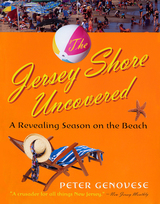 The Jersey Shore Uncovered: A Revealing Season on the Beach
Genovese, Peter
Rutgers University Press, 2003 This is not your typical Jersey Shore book. Yes, you'll find the obvious-beaches and boardwalks, lifeguards and lighthouses, fishing and food. But Peter Genovese will also take you off the beaten track for an insider's look at this famous (and infamous) 127-mile stretch from Sandy Hook to Cape May. Birders, tiki hut builders, beach cleaners, wheel-of-chance operators, she-crab soup makers-they're all here. You'll check out an Airstream-only trailer park and visit a Point Pleasant Beach house where the music of Frank Sinatra plays nearly 24/7. Genovese will introduce you to the owner of the Stone Pony and to participants at the grueling Atlantic City Around-the-Island Swim as they describe their battles with tides, exhaustion, and face-stinging jellyfish. All of that, plus you'll find out why Ocean Grove residents write their names on their flowerpots. Beach reading just doesn't get any better than this. Spend a summer with Peter Genovese as he chronicles a typical wild and wacky, kitschy and classy season along the New Jersey coastline. Lifeguards, surfers, beachgoers, birders, ice cream vendors, seashell sellers, banner pilots-they're all here. You'll be on the scene when Atlantic City's mayor officially begins summer by "unlocking the ocean," get a whiff of the state barbeque championship, watch the nation's longest-running all-women lifeguard competition, and even spend a weekend, Survivor-style, on a Barnegat Bay island. The Ocean City Baby Parade, Clownfest, the state's hottest bikini contest, and the World Series of Surf Fishing are all covered. You'll also meet the folks at the Diamondback Terrapin Conservation Project, the Cape May Migratory Bird Refuge, and the Marine Mammal Stranding Center. Genovese introduces you to Little Miss Chaos and the King of Corn, the Jersey Shore Hot Dog Queen, and Lucky Leo. You'll go on patrol with the New Jersey State Marine Police, meet the man behind Big Mike's E-Z Bail Bonds, and find salvation at the Boardwalk Chapel. The Jersey Shore Uncovered flawlessly depicts the timeless allure of New Jersey beach culture. Along with his stories, Genovese brings readers hundreds of color and black-and-white photos that brilliantly capture exactly what makes this 127-mile stretch of shoreline unique. Whether you've never been to a New Jersey beach or you're a Jersey native who spends your summers "down the Shore," you're certain to learn a thing or two from this book. So get settled in your beach chair, put on some suntan lotion, and enjoy.
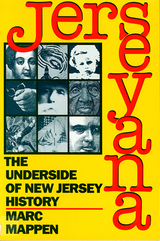 Jerseyana: The Underside of New Jersey History
Mappen, Marc
Rutgers University Press, 1992 Readers of the New Jersey section of the Sunday New York Times eagerly look forward to Marc Mappen's astonishing tales of New Jersey history. Jerseyana is his first collection of these popular monthly columns. Here you will meet villains like Dutch Schultz, the mobster gunned down in a Newark gangland rubout, and heroes like Minerva Miller, a black woman who fought segregation at the turn of the century. There are famous events, like the explosion of Hindenburg, and obscure ones, like the assassination of the king of Italy by an anarchist from Paterson. There are amusing stories, like a buried treasure hoax in Morristown after the Revolutionary War, bizarre stories like the fact that the discoverer of New Jersey was allegedly devoured by cannibals, and dramatic stories, like the Jersey woman who survived Indian captivity. Arranged chronologically, these columns constitute a lively New Jersey perspective on American history. Individual essays deal with major themes in American history and how they affected New Jersey: the colonial era, the Revolution, Civil War and Reconstruction, the Gilded Age, the Progressive Era, World War I, the '20s and '30s, World War II, McCarthyism, women's history, and black history. Each of the fifty-four columns in this book stands as a colorful exploration in history. Together they constitute a sweeping survey of our state's rich heritage.
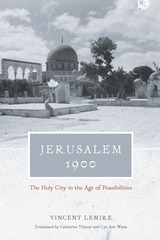 Jerusalem 1900: The Holy City in the Age of Possibilities
Vincent Lemire
University of Chicago Press, 2017 Perhaps the most contested patch of earth in the world, Jerusalem’s Old City experiences consistent violent unrest between Israeli and Palestinian residents, with seemingly no end in sight. Today, Jerusalem’s endless cycle of riots and arrests appears intractable—even unavoidable—and it looks unlikely that harmony will ever be achieved in the city. But with Jerusalem 1900, historian Vincent Lemire shows us that it wasn’t always that way, undoing the familiar notion of Jerusalem as a lost cause and revealing a unique moment in history when a more peaceful future seemed possible.
In this masterly history, Lemire uses newly opened archives to explore how Jerusalem’s elite residents of differing faiths cooperated through an intercommunity municipal council they created in the mid-1860s to administer the affairs of all inhabitants and improve their shared city. These residents embraced a spirit of modern urbanism and cultivated a civic identity that transcended religion and reflected the relatively secular and cosmopolitan way of life of Jerusalem at the time. These few years would turn out to be a tipping point in the city’s history—a pivotal moment when the horizon of possibility was still open, before the council broke up in 1934, under British rule, into separate Jewish and Arab factions. Uncovering this often overlooked diplomatic period, Lemire reveals that the struggle over Jerusalem was not historically inevitable—and therefore is not necessarily intractable. Jerusalem 1900 sheds light on how the Holy City once functioned peacefully and illustrates how it might one day do so again.
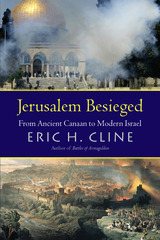 Jerusalem Besieged: From Ancient Canaan to Modern Israel
Eric H. Cline
University of Michigan Press, 2005 "Jerusalem Besieged is a fascinating account of how and why a baffling array of peoples, ideologies, and religions have fought for some four thousand years over a city without either great wealth, size, or strategic importance. Cline guides us through the baffling, but always bloody, array of Jewish, Roman, Moslem, Crusader, Ottoman, Western, Arab, and Israeli fights for possession of such a symbolic prize in a manner that is both scholarly and engaging."
-Victor Davis Hanson, Stanford University; author of The Other Greeks and Carnage and Culture
"A beautifully lucid presentation of four thousand years of history in a single volume. Cline writes primarily as an archaeologist-avoiding polemic and offering evidence for any religious claims-yet he has also incorporated much journalistic material into this study. Jerusalem Besieged will enlighten anyone interested in the history of military conflict in and around Jerusalem."
-Col. Rose Mary Sheldon, Virginia Military Institute
"This groundbreaking study offers a fascinating synthesis of Jerusalem's military history from its first occupation into the modern era. Cline amply deploys primary source material to investigate assaults on Jerusalem of every sort, starting at the dawn of recorded history. Jerusalem Besieged is invaluable for framing the contemporary situation in the Middle East in the context of a very long and pertinent history."
-Baruch Halpern, Pennsylvania State University
A sweeping history of four thousand years of struggle for control of one city
"[An] absorbing account of archaeological history, from the ancient Israelites' first conquest to today's second intifada. Cline clearly lays out the fascinating history behind the conflicts."
-USA Today
"A pleasure to read, this work makes this important but complicated subject fascinating."
-Jewish Book World
"Jerusalem Besieged is a fascinating account of how and why a baffling array of peoples, ideologies, and religions have fought for some four thousand years over a city without either great wealth, size, or strategic importance. Cline guides us through the baffling, but always bloody, array of Jewish, Roman, Moslem, Crusader, Ottoman, Western, Arab, and Israeli fights for possession of such a symbolic prize in a manner that is both scholarly and engaging."
-Victor Davis Hanson, Stanford University; author of The Other Greeks and Carnage and Culture
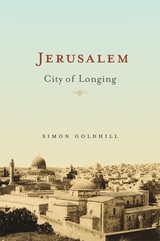 Jerusalem: City of Longing
Simon Goldhill
Harvard University Press, 2010 Jerusalem is the site of some of the most famous religious monuments in the world, from the Dome of the Rock to the Church of the Holy Sepulchre to the Western Wall of the Temple. Since the nineteenth century, the city has been a premier tourist destination, not least because of the countless religious pilgrims from the three Abrahamic faiths.
But Jerusalem is more than a tourist site—it is a city where every square mile is layered with historical significance, religious intensity, and extraordinary stories. It is a city rebuilt by each ruling Empire in its own way: the Jews, the Romans, the Christians, the Muslims, and for the past sixty years, the modern Israelis. What makes Jerusalem so unique is the heady mix, in one place, of centuries of passion and scandal, kingdom-threatening wars and petty squabbles, architectural magnificence and bizarre relics, spiritual longing and political cruelty. It is a history marked by three great forces: religion, war, and monumentality.
In this book, Simon Goldhill takes on this peculiar archaeology of human imagination, hope, and disaster to provide a tour through the history of this most image-filled and ideology-laden city—from the bedrock of the Old City to the towering roofs of the Holy Sepulchre. Along the way, we discover through layers of buried and exposed memories—the long history, the forgotten stories, and the lesser-known aspects of contemporary politics that continue to make Jerusalem one of the most embattled cities in the world.
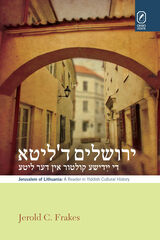 Jerusalem of Lithuania: A Reader in Yiddish Cultural History
Jerold C. Frakes
Ohio State University Press, 2011 Yerusholayim d’lite: di yidishe kultur in der lite (Jerusalem of Lithuania: A Reader in Yiddish Cultural History) by Jerold C. Frakes contains cultural, literary, and historical readings in Yiddish that vividly chronicle the central role Vilnius (Lithuania) played in Jewish culture throughout the past five centuries. It includes many examples of Yiddish literature, historiography, sociology, and linguistics written by and about Litvaks and includes work by prominent Yiddish poets, novelists, raconteurs, journalists, and scholars. In addition, Frakes has supplemented the primary texts with many short essays that contextualize Yiddish cultural figures, movements, and historical events. Designed especially for intermediate and advanced readers of Yiddish (from the second-year of instruction), each text is individually glossed, including not only English definitions, but also basic grammatical information that will enable intermediate readers to progress to an advanced reading ability. Because of its unique content, Yerusholayim d’lite will be of interest not only to university students of Yiddish language, literature, and culture, but it will be an invaluable resource for scholars and Yiddish reading groups and clubs worldwide, as well as for all general readers interested in Yiddish-language culture.
Jerusalem: Or on Religious Power and Judaism
Moses Mendelssohn
Brandeis University Press, 1983 A classic text of enduring significance, Moses Mendelssohn’s Jerusalem (1783) stands as a powerful plea for the separation of church and state and also as the first attempt to present Judaism as a religion eminently compatible with the ideas of the Enlightenment. Allan Arkush’s new translation, drawing upon the great strides made by Mendelssohn research in recent decades, does full justice to contemporary insights into the subject while authentically reflecting a distinguished eighteenth-century text. Alexander Altmann’s learned introduction opens up the complex structure and background of Mendelssohn’s ideas. His detailed commentary, keyed to the text, provides references to literary sources and interpretations of the philosopher’s intent.
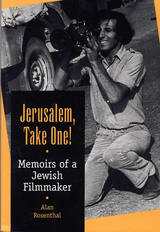 Jerusalem, Take One!: Memoirs of a Jewish Filmmaker
Alan Rosenthal
Southern Illinois University Press, 2000
Jerusalem, Take One! Memoirs of a Jewish Filmmaker is a behind-the-scenes look at the life of documentary filmmaker Alan Rosenthal, the maker of over sixty films including Day of Peace, Out of the Ashes, A Nation Is Born, and On the Brink of Peace. As a witness to so much recent Israeli history through a camera’s viewfinder, Rosenthal himself makes as much of an interesting subject as the events he documents.
Born in London in 1936, Rosenthal studied law at Oxford before beginning his work in television directing in Israel and the United States. By the 1960s he was an established young filmmaker who had participated in the filming of the Eichmann trial in Jerusalem in 1961. He returned in 1968, initially for just one year, as part of a team invited by the Israeli government to set up the first television network; that year turned into the thirty-plus years that inspired this book.
The Eichmann trial, the development of Israel Television, the Oslo agreement, the search for the menorah from the Second Temple, the history of Zionism on the television screen, and the Yom Kippur War and Project Renewal are but a few of the recent moments in Israeli history that Rosenthal and his camera have witnessed. As he recalls these events with humor and wit, Rosenthal’s words recapture the emotions and feel of those times as vividly as his lens recorded their passing.
This is a memoir, not a history textbook, and Rosenthal himself is the true subject of the book’s most intensely personal and introspective moments, stories of growth and learning, of England and family, of love and loss, of ideological disappointment and renewed hope. Rosenthal’s tale is one of progress toward the man he wishes to be, the films he feels he must make, and the cultural identity he seeks to develop for himself and all Jewish people.
 Jerusalem the Center of the Universe: Its Archaeology and History (1800–100 BCE)
Israel Finkelstein
SBL Press, 2024 Jerusalem is the center of the universe, the hub of the three great monotheistic religions, yet how did a city located on the desert fringe, in the semi-arid southern highlands of Israel with little tillable land achieve such dominance? To provide answers to this enduring riddle, Israel Finkelstein has collected twenty-four of his best articles and essays covering the Middle Bronze Age to the late Hellenistic period. With critical and well-informed care, he analyzes archaeological evidence that often stands in tension with the biblical text. Topics of particular interest include the archaeology of the tenth century BCE; Saul, David, and Solomon in the Bible and archaeology; the first expansion of the city in the ninth century; its full growth in the late eighth to seventh centuries; Jerusalem and Judah under the Assyrian Empire; the days of King Josiah; and transformations in the Persian-Hellenistic era. Short addenda update the reader on recent developments.
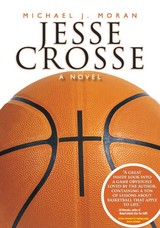 Jesse Crosse: a novel
Michael J. Moran
Parkhurst Brothers, Inc., 2011 Mike Moran first attended Little Rock Catholic High School for Boys-all four years. On the basketball team, he was a point guard. Then, as "Mr. Moran," he taught English for forty years, also at Little Rock Catholic High School for Boys. Recently retired, Moran wrote the boys a novel. The tale revolves around a struggling small-town basketball team with a nerdy manager and a Walter Mittyesque coach. Presented with too few players to scrimmage in practice, the manager takes it upon himself to spread the word throughout the school: "We need you on the team." Three young students appear, diminutive in stature and with scrawny chests, unimpressive at first sight. But with the trio, and their fleet leader Jesse Crosse, the team first experiences shock, then inspiration and constant surprises. The team bonds, leading to stories that will be retold a very long time in a small, out-of-the-way town. It's not a long novel; like one's high school years, it goes by before you know it. Only the message is eternal.
 Jesse James and the Civil War in Missouri
Robert L. Dyer
University of Missouri Press, 1994 The Civil War in Missouri was a time of great confusion, violence, and destruction. Although several major battles were fought in the state between Confederate and Union forces, much of the fighting in Missouri was an ugly form of terrorism carried out by loose bands of Missouri guerrillas, by Kansas "Jayhawkers," or by marauding patrols of Union soldiers. This irregular warfare provided a training ground for people like Jesse and Frank James who, after the war, used their newly learned skills to form an outlaw band that ultimately became known all over the world. Jesse James and the Civil War in Missouri discusses the underlying causes of the Civil War as they relate to Missouri and reveals how the war helped create both the legend and the reality of Jesse James and his gang. Written in an accessible style, this valuable little book will be welcomed by anyone with an interest in the Civil War, the legend of Jesse James, or Missouri history.
Jesse James Was His Name
William A. Settle, Jr.
University of Missouri Press, 1966 William A. Settle, Jr. has, for a number of years, trailed the James brothers through the columns of old newspapers and the records of county courts. In his search for the facts concerning these men--heroes to some, criminals to others--he has critically examined the contemporary accounts of their activities and has interviewed men and women who could give eyewitness or close hearsay evidence of them. Employing the techniques of scholarly research, Professor Settle has winnowed the fact from the fiction to produce this study of these most notorious American bandits.
Jesse Owens: An American Life
William J. Baker
University of Illinois Press, 2006 Born the tenth child of a poor Southern sharecropper and barely able to read or write, Jesse Owens used his astonishing drive and athletic ability to win an unprecedented four gold medals at the 1936 Berlin Olympics. He became an international superstar overnight and exploded Hitler’s myth of Aryan supremacy in the process. This Press edition of the William J. Baker's acclaimed work offers the most complete and probing biography of Owens ever written, vividly detailing the successes and failures of this complex and troubled but ultimately indomitable figure.
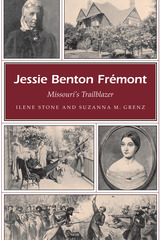 Jessie Benton Frémont: Missouri's Trailblazer
Ilene Stone & Suzanna M. Grenz
University of Missouri Press, 2005 When Sen. Thomas Hart Benton, one of Missouri’s first two senators and the great-uncle of the famous regionalist painter of the same name, was expecting his second child in 1824, he hoped it would be a boy. Although he was graced instead with a second girl, he named her Jessie (in honor of his father, Jesse) and raised her more like a son than a nineteenth-century daughter, introducing her to the leading politicians of the day and making sure she received an education that emphasized history, literature, and languages. Jessie and her father were close; Senator Benton was the main influence in her life until 1841, when, at the age of seventeen, she married army explorer John Charles Frémont against her parents’ wishes. Some degree of reconciliation occurred when Benton promoted Frémont’s famous explorations of the Great West. Jessie remained in Missouri with the couple’s young daughter, Lily, but she later helped to write and edit reports of her husband’s adventures, and these narratives spread the lure of the West to nineteenth-century America. In 1849 Jessie and Lily made a harrowing and treacherous journey across the Isthmus of Panama to rendezvous with Frémont in San Francisco. With income from their gold mines, the Frémonts established a home in California. In 1856, with the country on the brink of civil war, Frémont’s antislavery position was instrumental in his being chosen as the Republican Party’s first presidential nominee. Jessie was a staunch campaigner for her husband’s unsuccessful presidential bid, which her father, a lifelong Democrat, refused to endorse. When President Lincoln appointed Frémont as the commander of the Department of the West in 1861, Jessie served as his unofficial aide and closest adviser. In a particularly dramatic incident, she rushed to Washington, D.C., for a meeting with Lincoln in which she argued passionately for her husband’s proposal to emancipate the slaves in Missouri. After the Civil War, the Frémonts’ financial situation took a downturn. Undaunted, Jessie supported the family by writing about her adventures in the American West in such works as A Year of American Travel and Souvenirs of My Time. Like many women of her era, Jessie lived her ambitions largely through her husband’s career, but she also made a name for herself as a writer and a firm opponent of slavery.
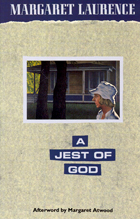 A Jest of God
Margaret Laurence
University of Chicago Press, 1993 A thirty-four-year-old school teacher living with her mother, Rachel Cameron feels trapped in an environment of small-town deceit and pettiness—her own and that of others. She longs for contact with another human being who shares her rebellious spirit. Finally, by confronting both love and death, Rachel earns the freedom she desperately needs.
Winner of the Governor General's Literary Award, A Jest of God was also the basis of the movie Rachel, Rachel.
"Mrs. Laurence tells [her story] unsparingly, with absolute authority, using her thorough understanding of Rachel to draw us into her anguish. We know Rachel, sympathize with her, and in a sense, become Rachel, so authentic is her voice. . . . A Jest of God has extraordinary clarity, beautiful detail, as well as the emotional impact of honest confession."—Joan J. Hall, Saturday Review
"Laurence's rendition is close to faultless . . . reaffirming her ability to draw, without pathos, life-sized women. . . . Skillfully wrought and eloquently told."—Marilyn Gardner, Christian Science Monitor
One of Canada's most accomplished writers, Margaret Laurence(1926-1987) was the recipient of many awards, including the prestigious Governer General's Litarary Award for The Diviners and A Jest of God.
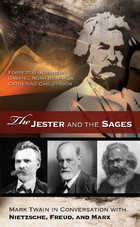 The Jester and the Sages: Mark Twain in Conversation with Nietzsche, Freud, and Marx
Forrest G. Robinson, Gabriel Noah Brahm, Jr., and Catherine Carlstroem
University of Missouri Press, 2011 The Jester and the Sages approaches the life and work of Mark Twain by placing him in conversation with three eminent philosophers of his time—Friedrich Nietzsche, Sigmund Freud, and Karl Marx. Unprecedented in Twain scholarship, this interdisciplinary analysis by Forrest G. Robinson, Gabriel Noah Brahm Jr., and Catherine Carlstroem rescues the American genius from his role as funny-man by exploring how his reflections on religion, politics, philosophy, morality, and social issues overlap the philosophers’ developed thoughts on these subjects. Remarkably, they had much in common.
During their lifetimes, Twain, Nietzsche, Freud, and Marx witnessed massive upheavals in Western constructions of religion, morality, history, political economy, and human nature. The foundations of reality had been shaken, and one did not need to be a philosopher—nor did one even need to read philosophy—to weigh in on what this all might mean. Drawing on a wide range of primary and secondary materials, the authors show that Twain was well attuned to debates of the time. Unlike his Continental contemporaries, however, he was not as systematic in developing his views.
Brahm and Robinson’s chapter on Nietzsche and Twain reveals their subjects’ common defiance of the moral and religious truisms of their time. Both desired freedom, resented the constraints of Christian civilization, and saw punishing guilt as the disease of modern man. Pervasive moral evasion and bland conformity were the principal end result, they believed.
In addition to a continuing focus on guilt, Robinson discovers in his chapter on Freud and Twain that the two men shared a lifelong fascination with the mysteries of the human mind. From the formative influence of childhood and repression, to dreams and the unconscious, the mind could free people or keep them in perpetual chains. The realm of the unconscious was of special interest to both men as it pertained to the creation of art.
In the final chapter, Carlstroem and Robinson explain that, despite significant differences in their views of human nature, history, and progress, Twain and Marx were both profoundly disturbed by economic and social injustice in the world. Of particular concern was the gulf that industrial capitalism opened between the privileged elite property owners and the vast class of property-less workers. Moralists impatient with conventional morality, Twain and Marx wanted to free ordinary people from the illusions that enslaved them.
Twain did not know the work's of Nietzsche, Freud, and Marx well, yet many of his thoughts cross those of his philosophical contemporaries. By focusing on the deeper aspects of Twain’s intellectual makeup, Robinson, Brahm, and Carlstroem supplement the traditional appreciation of the forces that drove Twain’s creativity and the dynamics of his humor.
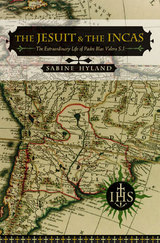 The Jesuit and the Incas: The Extraordinary Life of Padre Blas Valera, S.J.
Sabine Hyland
University of Michigan Press, 2004 In the spirit of justice Blas Valera broke all the rules-and paid with his life. Hundreds of years later, his ghost has returned to haunt the official story. But is it the truth, and will it set the record straight?
This is the tale of Father Blas Valera, the child of a native Incan woman and Spanish father, caught between the ancient world of the Incas and the conquistadors of Spain. Valera, a Jesuit in sixteenth-century Peru, believed in what to his superiors was pure heresy: that the Incan culture, religion, and language were equal to their Christian counterparts.
As punishment for his beliefs he was imprisoned, beaten, and, finally, exiled to Spain, where he died at the hands of English pirates in 1597.
Four centuries later, this Incan chronicler had been all but forgotten, until an Italian anthropologist discovered some startling documents in a private Neapolitan collection. The documents claimed, among other things, that Valera's death had been faked by the Jesuits; that he had returned to Peru; and, intriguingly, while there had taught his followers that the Incas used a secret phonetic quipu-a record-keeping device of the Inca empire-to record history.
Far from settling anything, the documents created an international sensation among scholars and led to bitter disputes over how they should be assessed. Are they forgeries, authentic documents, or something in between? If genuine, they will radically reform our view of Inca culture and Valera. The author insightfully examines the evidence, showing how fact and fiction intertwine, and brings the dimly understood history of this author-priest to light.
Sabine Hyland is Co-director of a multidisciplinary project studying the Chanka people of Peru. She holds a doctoral degree in anthropology from Yale, and is Assistant Professor of Anthropology at St. Norbert College.
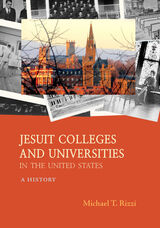 Jesuit Colleges and Universities in the United States: A History
Michael T. Rizzi
Catholic University of America Press, 2022 Jesuit Colleges and Universities in the United States provides a comprehensive history of Jesuit higher education in the United States, weaving together the stories of the fifty-four colleges and universities that the Jesuits have operated (successfully and unsuccessfully) since 1789. It emphasizes the connections among the institutions, exploring how certain Jesuit schools like Georgetown University gave birth to others like Boston College by sharing faculty, financial resources, accreditation, and even presidents throughout their history. The book also explores how the colleges responded to common challenges – including anti-Catholic prejudice in the United States, the push from government authorities to modernize their shared curriculum, and the pull from Roman authorities to remain loyal to Catholic tradition.
The story is comprehensive, covering the colonial era to the present, and takes a fresh look at themes like the rise of the research university in the 1880s and the administrative reforms of the 1960s. It also provides a modern and timely perspective on the role of Jesuit colleges in racial justice, women’s education, and other civil rights issues, drawing attention to underappreciated Jesuit contributions in these areas. It draws from both published and archival sources on the history of each institution to construct a single narrative, identifying common themes, challenges, and trends. Through the eyes of Jesuit colleges, it traces the evolution of American higher education and the role of Catholics in the United States over more than two centuries.
 Jesuit Higher Education in a Secular Age: A Response to Charles Taylor and the Crisis of Fullness
Daniel S. Hendrickson, SJ
Georgetown University Press, 2023 How Jesuit education can help students create meaningful connections in an age of secularism In A Secular Age, the philosopher Charles Taylor challenges us to appreciate the significance of genuine spiritual experience in human life, an occurrence he refers to as “fullness.” Western societies, however, are increasingly becoming more secular, and personal occasions of fullness are becoming less possible. In Jesuit Higher Education in a Secular Age, Daniel S. Hendrickson, SJ, shows how Jesuit education can respond to the crisis of modernity by offering three pedagogies of fullness: study, solidarity, and grace. A pedagogy of study encourages students to explore their full range of thoughts and emotions to help amplify their self-awareness, while a pedagogy of solidarity helps them relate to the lives of others, including disparate cultural and socioeconomic realities. Together, these two pedagogies cultivate an openness in students that can help them achieve a pedagogy of grace, which validates their awareness of and receptivity to the extraordinary spiritual Other that impacts our lives. Hendrickson demonstrates how this Jesuit imaginary—inspired by the Renaissance humanistic origins of Jesuit pedagogy—educates students toward a better self-awareness, a stronger sense of global solidarity, and a greater aptitude for inspiration, awe, and gratitude.
 Jesuit Letters From China, 1583-84
M. Howard Rienstra, EditorTranslated by M. Howard Rienstra
University of Minnesota Press, 1986 Jesuit Letters From China, 1583–84 was first published in 1986. Minnesota Archive Editions uses digital technology to make long-unavailable books once again accessible, and are published unaltered from the original University of Minnesota Press editions. The first eight letters from Jesuit missionaries on mainland China were written in 1583–84 and published in Europe in 1586. M Howard Rienstra's translated marks their first appearance in English. The letters chronicle the patient efforts of Michele Ruggieri and the famed Matteo Ricci to learn Chinese, to gain acceptance in Chinese society, and to explain Christianity to a highly sophisticated non-Christian culture. They also described the China of the late Ming dynasty (1368–1644), a country whose immense size and population had excited the imagination of Europeans for generations. It was Francis Xavier's dream that this mighty kingdom and civilization be opened to the Christian gospel. His dream was at least tentatively fulfilled when Michele Ruggieri was granted residence first in Canton and then in Chao-ch'ing in 1583. Accompanied first by Francesco Pasio and later by Matteo Ricci, Ruggieri initiated the Christian mission in China. Their letters, published initially as an appendix to a volume of Jesuit letters from Japan, were abbreviated and censored by their European editor. In edited form, the letters appeared in 1586 in one French, on German, and three Italian editions. The China of Ruggieri and Matteo Ricci had remained, however, both suspicious of, and closed to, foreigners - a fact which the original letters do not gloss over. Rienstra was carefully compared the abbreviated and censored versions of these letters in their originals, still preserved in the Jesuit archives in Rome. The letters in general indicate how tenuous the Jesuits' situation was and note candidly that only two baptisms had been performed on the mainland during their stay. These results stand in marked contracts to the reports from Japan of tens of thousands of baptisms and to the reports from Portuguese Macao, where Chinese converts were compelled to wear European cloths and to take European names. Such Europeanization was thought to be inappropriate to a successful Christian mission in China. Though criticized at the time by their colleagues in Macao, Ruggieri, Pasio, and Ricci committed themselves to a program of cultural respect and accommodation. They learned both written and spoken Chinese, ingratiated themselves with the ruling classes by exhibiting their learning and courtesy, and appeared to have become Chinese themselves. When Matteo Ricci became Ruggieri's successor and his name became synonymous with the success of the Jesuit mission in China, it was to these methods that its success was owed. Unfortunately, the prevailing European ethnocentrism could not accept the concept of cultural accommodation. The editors thus censored the letters to convey the impression of a triumphant and culturally superior Christian mission in China. Jesuit Letters From China is a publication of the James Ford Bell Library at the University of Minnesota.
Jesuit Missionary Cartography of the Upper Amazon, 1689 to 1789
Irina Saladin
Amsterdam University Press, 2024 In the early modern period, members of the Society of Jesus working as missionaries in the so-called mission of Maynas explored vast areas of the upper Amazon. These missionaries belonged to the very small group of Europeans who lived in the forests of the Amazon Basin for longer periods, in close contact with local people. Their daily experiences in the mission, their high level of education, and their connection with the institutional structures of the Jesuit order made them key figures in the production of knowledge about the Amazon. Irina Saladin investigates the complex relationships between mission and knowledge in the context of seventeenth- and eighteenth-century Jesuit maps. She analyzes how Jesuit missionary practices shaped the cartographic representation of the Amazon in the early modern era.
 Jesuit Relations and Other Americana in the Library of James F. Bell
Frank Walter
University of Minnesota Press, 1950
Jesuit Relations and Other Americana in the Library of James F. Bell was first published in 1950. Minnesota Archive Editions uses digital technology to make long-unavailable books once again accessible, and are published unaltered from the original University of Minnesota Press editions.Librarians, scholars, and collectors of rare books will delight in this meticulously prepared catalogue of the James F. Bell collection of Americana. This collection of approximately 325 items was built around the early accounts of basic discoveries of America and particularly the French explorations into Canada and the Great Lakes and Mississippi Valley regions, the search for a Northwest Passage, the activities of the Hudson’s Bay Company, the ill-fated Selkirk colony, and Minnesota history.Part I of the Catalogue is devoted to the Jesuit Relations collections, which includes 77 variants. This section was prepared by the late Mr. Walter, librarian emeritus of the University of Minnesota. Part II of the Catalogue, completed by Miss Doneghy, former cataloguer at the University of Minnesota library, after Mr. Walter’s death, describes the remainder of the collection. Extensive bibliographical and historical notes are given in both sections.The book is beautifully illustrated with plates showing title pages and other examples of typography and illustrations from the books described. There is a foreword by Mr. Walter and a brief preface in which Mr. Bell expresses his philosophy on the collecting of rare editions.The arrangement of items in both sections of the catalogue is chronological by date of publication.
Jesuit World Philology & the Birth of Comparative Grammar: The "Ianua Indica" of Ignazio Arcamone SJ
Stuart McManus
Harvard University Press The Ianua Indica (Indian Gateway) of Ignazio Arcamone S.J. (ca. 1615–1683) is the first comparative grammar of two South Asian vernaculars, Konkani and Marathi. This volume offers a critical edition of the Latin original based on the two surviving manuscripts, a translation into English, and a selection of extracts from sources that shed light on its genesis and significance, including part of an unpublished text by the British orientalist John Leyden (1775–1811) entitled “Plan for Investigating the Languages, Literatures, Antiquities and History of the Deccan.” It also features an extended introduction to this forgotten milestone in the history of Indology that outlines Arcamone’s reliance on the techniques of “Jesuit world philology” and the intellectual formation of the author in Italy and India.
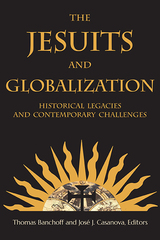 The Jesuits and Globalization: Historical Legacies and Contemporary Challenges
Thomas Banchoff and José Casanova, Editors
Georgetown University Press, 2018 The Society of Jesus, commonly known as the Jesuits, is the most successful and enduring global missionary enterprise in history. Founded by Ignatius Loyola in 1540, the Jesuit order has preached the Gospel, managed a vast educational network, and shaped the Catholic Church, society, and politics in all corners of the earth. Rather than offering a global history of the Jesuits or a linear narrative of globalization, Thomas Banchoff and José Casanova have assembled a multidisciplinary group of leading experts to explore what we can learn from the historical and contemporary experience of the Society of Jesus—what do the Jesuits tell us about globalization and what can globalization tell us about the Jesuits?
Contributors include comparative theologian Francis X. Clooney, SJ, historian John W. O'Malley, SJ, Brazilian theologian Maria Clara Lucchetti Bingemer, and ethicist David Hollenbach, SJ. They focus on three critical themes—global mission, education, and justice—to examine the historical legacies and contemporary challenges. Their insights contribute to a more critical and reflexive understanding of both the Jesuits’ history and of our contemporary human global condition.
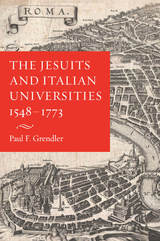 The Jesuits and Italian Universities, 1548-1773
Paul F. Grendler
Catholic University of America Press, 2017 The Society of Jesus arrived in Italy in 1540 brimming with enthusiasm to found new universities. These would be better than Italian universities, which the Jesuits believed were full of professors teaching philosophical atheism to debauched students. The Jesuits also wanted to become professors in existing Italian universities. They would teach Christian philosophy, true theology, sound logic, eloquent humanities, and practical mathematics. They would exert a positive moral influence on students.
The Jesuits were rejected. Italy already had fourteen universities famous for their research and teaching. They were ruled by princes and cities who refused to share their universities with a religious order led by Spaniards. Between 1548 and 1773 the Jesuits made sixteen attempts, from Turin in the north to Messina in Sicily, to found new universities or to become professors in existing universities. They had some successes, as they helped found four new universities and became professors of mathematics in three more universities. But they suffered nine total failures. The battles between universities, civil governments, and the Jesuits were memorable. Lay professors accused the Jesuits of teaching philosophy badly. The Jesuits charged that Italian professors delivered few lectures and skipped most of Aristotle. Behind the denunciations were profound differences about what universities should be.
Italian universities were dominated by law and the Jesuits emphasized the humanities and theology. Nevertheless, the Society of Jesus had an impact. They added cases of conscience to the training of clergymen. They made four years of study the norm for a degree in theology. They offered a student-centered alternative to Italian universities that focused on research and ignored student misbehavior.
Paul Grendler tells a new story based on years of research in a dozen archives. Anyone interested in the volatile mix of universities, religion, and politics will find this book fascinating and instructive, as will anyone who contemplates what it means to be a Catholic university.
Jesus among Her Children: Q, Eschatology, and the Construction of Christian Origins
Melanie Johnson-DeBaufre
Harvard University Press, 2005 Was Jesus a wisdom sage or an apocalyptic prophet? Did later followers view him as the Danielic "Son of Man" or did he use this expression for himself? These are familiar questions among historical Jesus scholars, and there has been much debate over Jesus' eschatological outlook since the controversial work of the Jesus Seminar. This book asks what is at stake in these debates and explores how scholarly constructions of Christian origins participate in contemporary efforts to confirm or challenge particular understandings of the essence of Christianity. Proposing that a Jesus-centered perspective has overly shaped our interpretation of the sayings source Q, Johnson-DeBaufre offers alternative readings to key Q texts, readings that place an interest in the community that shaped Jesus at the center of inquiry.
Jesus and Mary Reimagined in Early Christian Literature
Vernon K. Robbins
SBL Press, 2015 Explore the diverse character of emerging Christian narratives
This book presents essays that show how prophetic and priestly emphases in Luke and Acts, and emphasis on Jesus’s existence prior to creation in the Gospel of John, are reworked in some second- and third-century Christian literature. Early Christians interpreted and expressed the storylines of Jesus, Mary, and other important figures in ways that created new images and stories. Contributors show the effect of including rhetography, the rhetoric of a text that prompts images and pictures in the mind of a hearer or reader, in interpretation of texts.
Features:
- Readings that attempt to account for the development of richly creative and complicated early Christian traditions
- Essays bridging New Testament studies and interpretation of Early Christian literature
- Interpretations that integrate social and rhetorical interpretations
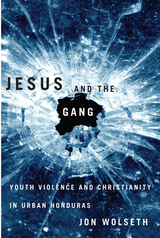 Jesus and the Gang: Youth Violence and Christianity in Urban Honduras
Jon Wolseth
University of Arizona Press, 2011 In urban Honduras, gun violence and assault form the pulsing backdrop of everyday life. This book examines the ways that young men and women in working-class neighborhoods of El Progreso, Honduras, understand and respond to gang and gun violence in their communities. Because residents rely on gangs and Catholic and Evangelical Protestant churches to mediate violence in their neighborhoods, these institutions form the fabric of society.
While only a small fraction of youths in a neighborhood are active members of a gang, most young men must learn the styles, ways of communicating, and local geography of gangs in order to survive. Due to the absence of gang prevention programs sponsored by the government or outside non-governmental organizations, Catholic and Pentecostal churches have developed their own ways to confront gang violence in their communities. Youths who participate in church organizations do so not only to alter and improve their communities but also to gain emotional and institutional support.
Offering firsthand accounts of these youths and how they make use of religious discourse, narrative practices, or the inscription of tattooed images and words on the body to navigate dangerous social settings, Jesus and the Gang is an unflinching look at how these young men turn away from perpetuating the cycle of violence and how Christianity serves a society where belonging is surviving.
This book will appeal to readers with an interest in Latin American studies, urban anthropology, and youth studies. With its focus on the lives of young men and women, it’s also a compelling read for anyone interested in the plight of urban youth trying to escape the gang life.
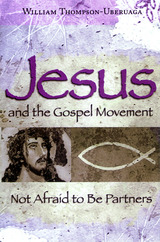 Jesus and the Gospel Movement: Not Afraid to Be Partners
William Thompson-Uberuaga
University of Missouri Press, 2006
The disciples. Mary Magdalene. Lazarus. The New Testament tells of Jesus, to be sure, but it is a Jesus depicted in interaction with many other people. Far too often, Jesus has been studied in isolation rather than as a person sharing relationships. This book seeks to rediscover Jesus in relation to the movement beginning to form around him.
One of the few books to explore fully the political dimensions of the emerging church, Jesus and the Gospel Movement brings studies of Jesus and Christology into dialogue with today’s social and political sciences. William Thompson-Uberuaga seeks to penetrate the mist surrounding the historical Jesus by inviting readers to imagine him through the perspective of his relationships and to consider how those relationships helped shape his personality and commitments—not just the intellectual aspects but also his feelings, his affectionate bonds, and the reciprocal bonds he stimulated in others.
This extended meditation represents the first book-length engagement with Voegelin scholarship on these issues, and scholars in Voegelin studies will find a challenging appropriation of that thinker’s political philosophy. It also draws on insights of other philosophers ranging from Nietzsche to Derrida, with a particular emphasis on Gadamer’s hermeneutical thought. Useful for courses in Jesus studies, Christology, and Christianity and politics, the text also features an Internet link to supplements accompanying each chapter, which have been written by the author especially for this book to enable students and readers to delve deeper into the thicket of scholarly debates concerning these issues.
Thompson-Uberuaga asks readers to imagine the various beliefs about Jesus as the result of forms of participation, helping us make sense of how they emerged and offering a way of evaluating their validity—and arguing that we will form only a narrow, even lopsided view of Jesus if we consider him apart from his relationships. By daring a personal interpretation of Jesus and the Gospel movement that he and his companions originated, this book boldly challenges readers to risk their own interpretations and arrive at their own understanding of the Messiah.
Jesus Becoming Jesus: A Theological Interpretation of the Synoptic Gospels
Thomas Weinandy
Catholic University of America Press, 2018 Jesus Becoming Jesus presents a theological interpretation of the Gospels of Matthew, Mark and Luke. Unlike many conventional biblical commentaries, Weinandy concentrates on the theological content contained within the Synoptic Gospels. He does thi
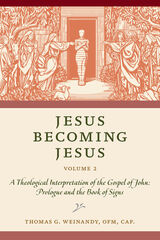 Jesus Becoming Jesus, Volume 2: A Theological Interpretation of the Gospel of John: Prologue and the Book of Signs
Thomas G. Weinandy
Catholic University of America Press, 2021 Jesus Becoming Jesus, Volume 2: A Theological Interpretation of the Gospel of John: Prologue and the Book of Signs follows upon the first volume of this series entitled Jesus Becoming Jesus. The first volume was a theological interpretation of the Gospels of Matthew, Mark and Luke. Unlike many conventional biblical commentaries, Weinandy concentrates on the theological content contained within John’s Gospel. He does this in the light of the Church’s doctrinal and theological tradition, particularly in keeping with the Second Vatican Council’s Dogmatic Constitution, Dei Verbum. This is accomplished through a close reading of John’s Gospel, theologically interpreting each chapter of the Gospel sequentially. In so doing he also takes into account the Johannine corpus as a whole. He also relates John’s Gospel to relevant material found within the Synoptic Gospels, the Pauline Corpus and other New Testament writings.
This original theological interpretation focuses primarily on the intertwining theological themes contained within John’s Gospel, specifically within the Prologue and the Book of Signs – light and darkness, the seven miracle-signs, the sacraments of baptism and the Eucharist, the seven “I Am” sayings, the contentious dialogues with the Jews, Jesus’ relationship to his Father as the Father’s incarnate Word and Son, etc. Within all of these interlocking themes one finds the importance of Jesus’ saving actions – the salvific works of his Father. The overarching theme of this book, as the title suggests, is that Jesus, being named Jesus, throughout his public ministry is enacting his name and so becoming who he is – YHWH-Saves.
Weinandy offers a singular, vibrant, and luminous reading of John’s Gospel; one that reveals the Evangelist’s theological depth and doctrinal sophistication. In so doing, Weinandy makes manifest the particular beauty of the Gospel According to John.
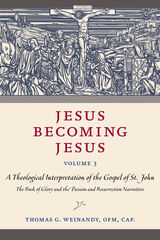 Jesus Becoming Jesus, Volume 3: A Theological Interpretation of the Gospel of John: The Book of Glory and the Passion and Resurrection
Thomas G. Weinandy
Catholic University of America Press, 2022 Jesus Becoming Jesus, Volume 3 follows upon the previous two volumes of this series entitled Jesus Becoming Jesus. Volume 1 was a theological interpretation of the Gospels of Matthew, Mark and Luke, and volume 2 was a theological interpretation of the Prologue and Book of Signs of John’s Gospel (chapters 1-12). Unlike many conventional biblical commentaries, Weinandy concentrates on the theological content contained within John’s Gospel. This is accomplished through a close reading of John’s Gospel, theologically interpreting each chapter of the Gospel sequentially. In so doing he also takes into account the Johannine corpus as a whole. He also relates John’s Gospel to relevant material found within the Synoptic Gospels, the Pauline Corpus and other New Testament writings.
In this present volume, Weinandy’s original theological interpretation focuses first on the Evangelist’s narrative of the Last Supper, which includes Jesus’ washing of his disciples’ feet, followed upon his lengthy farewell address and his ensuing High Priestly Prayer (chapter 13-17). Although Jesus speaks of his leaving his disciples, yet their hearts should not be troubled, for he is going to prepare a place for them in his Father’s house, and he will also send them another Counselor, the Holy Spirit. The Holy Spirit will not only convict the world sin, but he will also empower the disciples to profess their faith in Jesus as the Father’s Son, even in the midst of persecution. All that Jesus tells his disciple in his final discourse, he then prays that his Father will accomplish through his forthcoming death and resurrection – above all that his disciples will share in the same oneness of love that he and his Father possess.
Weinandy masterfully treats John’s Passion and Resurrection Narratives. He not only theologically interprets the uniqueness of the Evangelist’s narratives, but also how his narratives insect with the Synoptic accounts. Moreover, Weinandy’s theological reading of Jesus’ crucifixion and resurrection weaves together John’s soteriology, ecclesiology, and sacramentality – all of which are founded upon the Incarnation, that Jesus is the Father’s Spirit-filled incarnate Son. As the title suggests, Jesus, being named Jesus, in his death and resurrection, definitively enacts his name and so becoming who he is – YHWH-Saves.
 Jesus Being Jesus: A Theological Interpretation of the Acts of the Apostles: Volume 1: Chapters 1-14
Thomas G. Weinandy
Catholic University of America Press, 2026 Luke was a Gentile and physician. Though not one of Jesus’ initial Jewish disciples, Luke was a traveling companion of Paul. As with the Old Testament and the Gospels, Luke provides the theological and ecclesial significance of the historical events he is narrating. In so doing, he accentuates what the risen and ascended Jesus is doing through the Holy Spirit by means of the nascent church, primarily through Peter and Paul. Although the book is entitled the Acts of the Apostles, the Holy Spirit is the primary actor throughout its entirety.
Luke is traditionally believed to be the author of both the third Gospel as well as the Acts of the Apostles. As Luke, in his Gospel, first wrote “an orderly account for you, most excellent Theophilus, concerning the truth of the gospel,” so he now writes what has taken place after Jesus’ departure. Thus, the Acts of the Apostles is a continuation of a historical narrative. The Gospel contains what Jesus historically said and did until his Ascension into Heaven. Acts is the historical narrative of what followed upon Jesus’ ascension and the pouring out of the Holy Spirit at Pentecost that gave birth to the Church, and the first preaching of the Good News.
If in Luke’s gospel account one finds Jesus becoming Jesus through his saving actions which culminate in his death and resurrection, in the Acts of the Apostles, one finds the risen Jesus being Jesus through the preaching and actions of the apostolic church. Jesus continues to enact his name, YHWH-Saves. Such saving words and actions are particularly within the evangelistic ministry of Peter and Paul.
Jesus in America and Other Stories from the Field
Claudia Gould
Utah State University Press, 2009 Drawing on ethnographic field work she conducted among Christians in her home state of North Carolina, Claudia Gould crafts stories that lay open the human heart and social complications of fundamentalist belief. These stories and the compelling characters who inhabit them draw us into the complex essence of religious experience among southern American Christians.
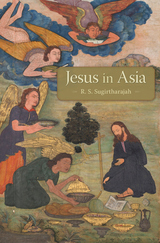 Jesus in Asia
R. S. Sugirtharajah
Harvard University Press, 2018 Reconstructions of Jesus occurred in Asia long before the Western search for the historical Jesus began in earnest. This enterprise sprang up in seventh-century China and seventeenth-century India, encouraged by the patronage and openness of the Chinese and Indian imperial courts. While the Western quest was largely a Protestant preoccupation, in Asia the search was marked by its diversity: participants included Hindus, Jains, Muslims, Catholics, and members of the Church of the East.
During the age of European colonialism, Jesus was first seen by many Asians as a tribal god of the farangis, or white Europeans. But as his story circulated, Asians remade Jesus, at times appreciatively and at other times critically. R. S. Sugirtharajah demonstrates how Buddhist and Taoist thought, combined with Christian insights, led to the creation of the Chinese Jesus Sutras of late antiquity, and explains the importance of a biography of Jesus composed in the sixteenth-century court of the Mughal emperor Akbar. He also brings to the fore the reconstructions of Jesus during the Chinese Taiping revolution, the Korean Minjung uprising, and the Indian and Sri Lankan anti-colonial movements.
In Jesus in Asia, Sugirtharajah situates the historical Jesus beyond the narrow confines of the West and offers an eye-opening new chapter in the story of global Christianity.
Jesus, Interpreted
Matthew J. Ramage
Catholic University of America Press, 2017 In this sequel volume to his Dark Passages of the Bible (CUA Press, 2013), author Matthew Ramage turns his attention from the Old to the New Testament, now tackling truth claims bearing directly on the heart of the Christian faith cast into doubt by contemporary New Testament scholarship: Did God become man in Jesus, or did the first Christians make Jesus into God? Was Jesus' resurrection a historical event, or rather a myth fabricated by the early Church? Will Jesus indeed return to earth on the last day, or was this merely the naïve expectation of ancient believers that reasonable people today ought to abandon?
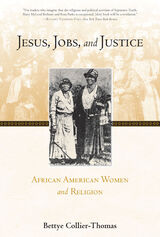 Jesus, Jobs, and Justice: African American Women and Religion
Bettye Collier-Thomas
Temple University Press, 2013 Bettye Collier-Thomas’s groundbreaking book, Jesus, Jobs, and Justice—now available for the first time in paperback—provides a remarkable account of the religious faith, social and political activism, and extraordinary resilience of black women during the centuries of American growth and change. As co-creators of churches, women were a central factor in their development. However, women often had to cope with sexism in black churches, as well as racism in mostly white denominations. Collier-Thomas skillfully shows how black church women created national organizations such as the National Association of Colored Women, the National League of Colored Republican Women, and the National Council of Negro Women to fight for civil rights and combat discrimination. She also examines how black women missionaries sacrificed their lives in service to their African sisters whose destiny they believed was tied to theirs. While religion has been a guiding force in the lives of most African Americans, for black women it has been essential. Jesus, Jobs, and Justice restores black women to their rightful place in American and black history and demonstrates their faith in themselves, their race, and their God.
Jesus the Central Jew: His Times and His People
André LaCocque
SBL Press, 2015 Not a Jew marginally, but centrally
In this book, LaCocque presents the case that Jesus was totally and unquestionably a Jew. He lived as a Jew, thought as a Jew, debated as a Jew, acted as a Jew and died as a Jew. He had no intention of creating a new religion; rather, he was a reformer of the Judaism of his day. True, his critique went far beyond an intellectual subversion. In fact, Jesus progressively thought of himself as the “Son of Man” inaugurating the advent of the Kingdom of God on earth.
Features:
- Focused attention given to the historical Jesus and not Christianity or Christology
- Addresses restricted sources, namely, the Synoptic Gospels
- Close examination of Jesus’s way of thinking, teaching, and behaving
Jesus the Mediator
William Brownsberger
Catholic University of America Press, 2013 In Jesus the Mediator, William L. Brownsberger offers an account of the human psychology assumed by the Second Person of the Trinity in light of its salvific significance
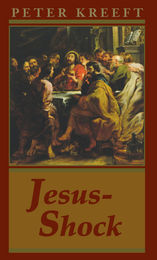 Jesus-Shock
Peter Kreeft
St. Augustine's Press, 2008 Jesus Shock is the second in a series of short works on seminal concerns of the impact that Jesus Christ made in the world. The first work, The Philosophy of Jesus (St. Augustine’s Press, 2007), explored philosophy in light of Jesus, rather than the other way around. The present work investigates the reception Jesus received both in His lifetime and continuously to the present time, not only from His enemies, but from His friends, a reception of shock, astonishment, even disgust.
Perhaps a few remarks from the book best explains it: The point of the book:
The point of the title: Imagine a storm has downed a telephone wire so that everyone who touches it is shocked in every cell of his body. Well, the storm of God’s crazy love has “downed” (incarnated) Jesus, and everyone who touches this “live wire” is shocked in every cell of his soul.
The question of the book: Why is “Jesus” the most non-neutral, the most controversial, the most embarrassing name in the world? Why is talking about Jesus like talking about sex?
This whole book is really about a single movie line, the greatest line in the greatest movie in history. Bet you know what it is.
Jesus-Shock is about the Real Presence of Christ in the Gospels and in the Eucharist. It
is not about the theology of the Real Presence, but about the experience of Him there, and about the experience of everyone in the Gospels who met Him. What was the bitterest controversy of the Protestant Reformation, both between Protestants and Catholics and between different Protestant denominations, the one that had both sides calling the other not just heretics but devils?
Answer: It was not Justification by Faith, the hallmark of the Reformation, even though that question is about nothing less momentous than how to be saved, how to get to Heaven. It was not the relation between religion and politics, even though that was a matter of life or death (literally, on battlefields and at guillotines and hangings) and not just a matter of truth or falsity, or of good or evil. It was not about the sufficiency of the Bible, or the corruption in the Church, or the relation between the Bible and the Church. It was not about the Pope, and the governance of the Church. It was not about Mary or saints or angels or Purgatory. It was not about the Incarnation or the Trinity or the Atonement.
It was about the Real Presence of Christ in the Eucharist. Jesus-Shock, in addressing this controversy forcefully and faithfully, shows the reasons why to this day the name of “Jesus” stirs up controversy, even revulsion, in polite society. In the true spirit of ecumenism, it also points the way toward a true rapprochement among His modern-day disciples.
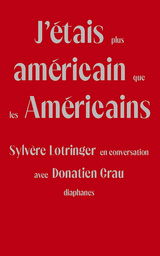 J'étais plus américain que les Américains: Sylvère Lotringer en conversation avec Donatien Grau
Sylvère Lotringer and Donatien Grau
Diaphanes, 2021 Au milieu des années 1970, Sylvère Lotringer a créé Semiotext(e), un groupe philosophique devenu magazine puis maison d'édition. Depuis sa création, Semiotext(e) est le lieu de rencontres libres: John Cage lisant Nietzsche, à travers Deleuze; punk et philosophie; la possibilité de sexualités et de politiques alternatives; le dialogue immédiat entre artistes et philosophes. La vie artistique et intellectuelle américaine des cinquante dernières années en est largement tributaire. Le modèle de la revue et de la maison d'édition tourne essentiellement autour de la notion de collectif, et leur créateur Sylvère Lotringer s'est rarement livré à la continuité de son parcours personnel: son existence d'enfant caché pendant la Seconde Guerre mondiale; l'expérience libératrice puis traumatisante du collectif dans le kibboutz; son activisme parisien dans les années 1960; son temps d'errance, qui le mena, par Istanbul, aux États-Unis; et puis, bien sûr, ses années américaines, la façon dont il mêlait sa vie nocturne à l'expérimentation formelle qu'il a inventée avec Semiotext(e) et avec ses cours. Depuis le début des années 2010, Donatien Grau a pris l'habitude de rendre visite à Sylvère Lotringer lors de ses voyages à Los Angeles; certains de leurs dialogues ont été publiés ou tenus en public. Ceux-ci nous donnent accès à la vie de Sylvère Lotringer, ses amitiés, ses choix, son admiration pour certains des plus grands penseurs de notre temps. Les conversations montrent des éclats de vie, des traces d'un voyage, à travers les textes et l'existence elle-même, avec une intensité rare.
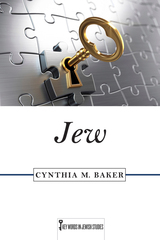 Jew
Baker, Cynthia M
Rutgers University Press, 2017 Jew. The word possesses an uncanny power to provoke and unsettle. For millennia, Jew has signified the consummate Other, a persistent fly in the ointment of Western civilization’s grand narratives and cultural projects. Only very recently, however, has Jew been reclaimed as a term of self-identification and pride. With these insights as a point of departure, this book offers a wide-ranging exploration of the key word Jew—a term that lies not only at the heart of Jewish experience, but indeed at the core of Western civilization. Examining scholarly debates about the origins and early meanings of Jew, Cynthia M. Baker interrogates categories like “ethnicity,” “race,” and “religion” that inevitably feature in attempts to define the word. Tracing the term’s evolution, she also illuminates its many contradictions, revealing how Jew has served as a marker of materialism and intellectualism, socialism and capitalism, worldly cosmopolitanism and clannish parochialism, chosen status, and accursed stigma. Baker proceeds to explore the complex challenges that attend the modern appropriation of Jew as a term of self-identification, with forays into Yiddish language and culture, as well as meditations on Jew-as-identity by contemporary public intellectuals. Finally, by tracing the phrase new Jews through a range of contexts—including the early Zionist movement, current debates about Muslim immigration to Europe, and recent sociological studies in the United States—the book provides a glimpse of what the word Jew is coming to mean in an era of Internet cultures, genetic sequencing, precarious nationalisms, and proliferating identities.
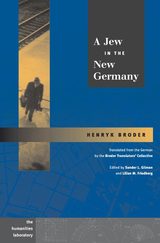 A Jew in the New Germany
Henryk Broder
University of Illinois Press, 2003 Henryk Broder, one of the most controversial and engaging writers in Germany today, has been a thorn in the side of the Establishment for thirty years. The son of two Polish Holocaust survivors, Broder is not only a trenchant political critic and observant social essayist but an invaluable chronicler of the Jewish experience in late twentieth-century Germany.
This volume collects eighteen of Broder's essays, translated for the first time into English. The first was written in 1979 and the most recent deals with the post-9/11 realities of the war on terrorism, and its effects on the countries of Europe. Other essays address the debate over the construction of a Holocaust memorial in Berlin, the German response to the 1991 Gulf War, the politics of German reunification, and the rise of the new German nationalism.
Broder charts the recent evolution of German Jewish relations, using his own outsider status to hold up a mirror to the German people and point out that things have not changed for German Jews as much as non-Jews might think.
 The Jew, the Beauty, and the Beast: Gender and Animality in Modernist Hebrew Fiction
Naama Harel
Rutgers University Press, 2026 Jews, women, and animals have been notoriously considered in Western thought as antithetical to the “civilized,” and therefore parallel. The trope of the womanized Jewish man has been widely recognized as a staple in otherizing portrayals of European Jews, as well as their self-perception. Similarly, ecofeminist critique has addressed the ubiquitous depiction of the animalized woman throughout history. Yet, the interconnection between the effeminization of Jews and the animalization of women has been overlooked.
The Jew, the Beauty, and the Beast critically explores the tangled interplay between Jewishness, gender, and animality and its manifestation in modernist Hebrew fiction. Through interdiscursive analysis and close readings, the effeminate Jew is examined vis-à-vis the animalized woman. Intertwining cutting-edge theoretical frameworks of posthumanism and animal studies with established scholarship of Hebrew literature, Jewish studies, and gender studies, Naama Harel offers new Hebrew literary historiography and innovative perspectives on canonical works by Shmuel Yosef Agnon, Devorah Baron, Micha Yosef Berdichevsky, Yosef Haim Brenner, Uri Nissan Gnessin, and David Vogel.
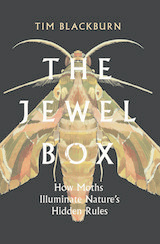 The Jewel Box: How Moths Illuminate Nature’s Hidden Rules
Tim Blackburn
Island Press, 2023 A plastic box with a lightbulb attached may seem like an odd birthday present. But for ecologist Tim Blackburn, a moth trap is a captivating window into the world beyond the roof terrace of his London flat. Whether gaudy or drab, rare or common, each moth ensnared by the trap is a treasure with a story to tell. In The Jewel Box, Blackburn introduces these mysterious visitors, revealing how the moths he catches reflect hidden patterns governing the world around us.
With names like the Dingy Footman, Jersey Tiger, Pale Mottled Willow, and Uncertain, and at least 140,000 identified species, moths are fascinating in their own right. But no moth is an island—they are vital links in the web of life. Through the lives of these overlooked insects, Blackburn introduces a landscape of unseen ecological connections. The flapping of a moth’s wing may not cause a hurricane, but it is closely tied to the wider world, from the park down the street to climatic shifts across the globe.
Through his luminous prose and infectious sense of curiosity, Blackburn teaches us to see—and respect—the intricate web of nature in which we’re all caught. The Jewel Box shows us how the contents of one small box can illuminate the workings of all nature.
Jewel in the Ashes: Buddha Relics and Power in Early Medieval Japan
Brian D. Ruppert
Harvard University Press, 2000 This study addresses the relationship between the veneration of Buddha relics and the appropriation of power in early medieval Japan. Focusing on the ninth to the fourteenth centuries, it analyzes the ways in which relics functioned as material media for the interactions of Buddhist clerics, the imperial family, lay aristocrats, and warrior society and explores the multivocality of relics by dealing with specific historical examples. Brian Ruppert argues that relics offered means for reinforcing or subverting hierarchical relations. The author's critical literary and anthropological analyses attest to the prominence of relic veneration in government, in lay practice associated with the maintenance of the imperial line and warrior houses, and in the promotion of specific Buddhist sects in Japan.
 Jewel of the Soul
Honorius Augustodunensis
Harvard University Press, 2023 The first complete translation into a modern language of a major authority on the medieval Christian liturgy.
Honorius Augustodunensis’s Jewel of the Soul (the Gemma animae) gleams as one of the most attractive liturgical commentaries from the twelfth century. A lively and effective teacher, Honorius strives to unveil the meaning behind the sacred texts, objects, music, and ritual of the Roman Mass and Divine Office for young initiates. Building on the allegorical approach pioneered in the Carolingian era by Amalar of Metz, he shows readers how their souls are beautified by the liturgy as gold is by a jewel. His flowing and comprehensive commentary gained widespread influence in Western Christendom and was an important source for later liturgical treatises. For the modern scholar this work remains key to understanding the medieval allegorical approach to worship and provides valuable documentation about how these offices were celebrated in the twelfth century. These volumes offer the first complete translation into a modern language of this foundational Latin text on Christian liturgy.
 Jewel of the Soul
Honorius Augustodunensis
Harvard University Press, 2023 The first complete translation into a modern language of a major authority on the medieval Christian liturgy.
Honorius Augustodunensis’s Jewel of the Soul (the Gemma animae) gleams as one of the most attractive liturgical commentaries from the twelfth century. A lively and effective teacher, Honorius strives to unveil the meaning behind the sacred texts, objects, music, and ritual of the Roman Mass and Divine Office for young initiates. Building on the allegorical approach pioneered in the Carolingian era by Amalar of Metz, he shows readers how their souls are beautified by the liturgy as gold is by a jewel. His flowing and comprehensive commentary gained widespread influence in Western Christendom and was an important source for later liturgical treatises. For the modern scholar this work remains key to understanding the medieval allegorical approach to worship and provides valuable documentation about how these offices were celebrated in the twelfth century. These volumes offer the first complete translation into a modern language of this foundational Latin text on Christian liturgy.
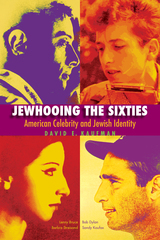 Jewhooing the Sixties: American Celebrity and Jewish Identity—Sandy Koufax, Lenny Bruce, Bob Dylan, and Barbra Streisand
David E. Kaufman
Brandeis University Press, 2012 Sandy Koufax, Lenny Bruce, Bob Dylan, and Barbra Streisand first came to public attention in the early 1960s, a period Kaufman identifies as historically ripe for American Jews to reexamine their (Jewish) identities. All four achieved extraordinary success in their respective fields and became celebrities within an American context, while at the same time they were clearly identifiable as Jews—although they were perceived to be Jewish in very different ways. Kaufman investigates these celebrities’ rise to fame, the specific brand of Jewishness each one represented, and how their fans and the public at large perceived their ethnic identity as Jews. Situating Koufax, Bruce, Dylan, and Streisand within the larger history of American Jewish celebrity, Kaufman argues that the four early 1960s figures represent a turning point between celebrity Jews of the past—such as Hank Greenberg, Groucho Marx, Irving Berlin, and Fanny Brice—and those of the present, such as Jon Stewart, Matisyahu, and Natalie Portman. Providing an entry into Jewish celebrity studies, this lively narrative explores the intersection between popular celebrity and Jewish identity and thereby examines the cultural construction of Jewishness in the latter half of the twentieth century.
Jewish Allegory in Eighteenth-Century Christian Imagination
Rebecca K. Esterson
SBL Press, 2023 Rebecca K. Esterson explores how Christian methods of biblical interpretation shifted during the eighteenth century, producing a rhetorical rejection of allegory while embracing literalism. Under the influence of Enlightenment concepts of human reason and advances in the experimental sciences, Christian interpreters began casting Jewish biblical interpretation as allegorical, while presenting Christian interpretation as literal. This shift in self-understanding allowed Christians to portray their own interpretations as scientifically, philosophically, and historically superior, resulting in a new way of othering the Jewish people. This study of biblical exegesis, theology, philosophy, and the arts in English, Swedish, and German contexts is an essential resource for scholars interested in biblical reception history and the history of Jewish-Christian relations.
 Jewish and Catholic Bioethics: An Ecumenical Dialogue
Edmund D. Pellegrino and Alan I. Faden, Editors
Georgetown University Press Drawing on multiple interconnected scriptural and spiritual sources, the Jewish tradition of ethical reflection is intricate and nuanced. This book presents scholarly Jewish perspectives on suffering, healing, life, and death, and it compares them with contemporary Christian and secular views. The Jewish perspectives presented in this book are mainly those of orthodox scholars, with the responses representing primarily Christian-Catholic points of view. Readers unfamiliar with the Jewish tradition will find here a practical introduction to its major voices, from Spinoza to Jewish religious law. The contributors explore such issues as active and passive euthanasia, abortion, assisted reproduction, genetic screening, and health care delivery. Offering a thoughtful and thought-provoking dialogue between Jewish and Christian scholars, Jewish and Catholic Bioethics is an important contribution to ecumenical understanding in the realm of health care.
 Jewish and Islamic Law: A Comparative Study of Custom during the Geonic Period
Gideon Libson
Harvard University Press, 2003 Gideon Libson's highly original work on custom is the first attempt to present a comprehensive comparative study of Jewish-Islamic law on a particular topic during the early Middle Ages. His in-depth study of Islamic law—its sources, legal schools, and extensive legal literature—together with his expertise in the wide range of geonic and rabbinic literature enable him to determine the influence of Muslim practice on geonic custom.
In both systems of law the growth of custom was a reaction to the general culture. He shows conclusively how custom in both systems of law served as a conduit for the absorption of changes, thus helping to bridge the gap between the authoritative legal systems and the practical realities of the environment. Libson's contribution to the study of comparative Jewish and Islamic law during the geonic period will be of value to scholars engaged in the study of comparative law.
Jewish and Romani Families in the Holocaust and its Aftermath
Eliyana R. Adler
Rutgers University Press, 2021 Diaries, testimonies and memoirs of the Holocaust often include at least as much on the family as on the individual. Victims of the Nazi regime experienced oppression and made decisions embedded within families. Even after the war, sole survivors often described their losses and rebuilt their lives with a distinct focus on family. Yet this perspective is lacking in academic analyses.
In this work, scholars from the United States, Israel, and across Europe bring a variety of backgrounds and disciplines to their study of the Holocaust and its aftermath from the family perspective. Drawing on research from Belarus to Great Britain, and examining both Jewish and Romani families, they demonstrate the importance of recognizing how people continued to function within family units—broadly defined—throughout the war and afterward.
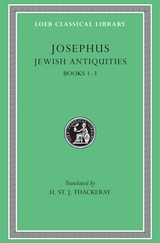 Jewish Antiquities, Volume I: Books 1–3
Josephus
Harvard University Press Greco-Roman antiquity’s premier Jewish historian.
Josephus, soldier, statesman, historian, was a Jew born at Jerusalem about AD 37. A man of high descent, he early became learned in Jewish law and Greek literature and was a Pharisee. After pleading in Rome the cause of some Jewish priests he returned to Jerusalem and in 66 tried to prevent revolt against Rome, managing for the Jews the affairs of Galilee. In the troubles that followed he made his peace with Vespasian. Present at the siege of Jerusalem by Titus, he received favors from these two as emperors and from Domitian, and assumed their family name Flavius. He died after 97.
As a historical source Josephus is invaluable. His major works are: History of the Jewish War, in seven books, from 170 BC to his own time, first written in Aramaic but translated by himself into the Greek we now have; and Jewish Antiquities, in twenty books, from the creation of the world to AD 66. The Loeb Classical Library edition of the works of Josephus, which is in thirteen volumes, also includes the autobiographical Life and his treatise Against Apion.
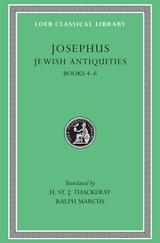 Jewish Antiquities, Volume II: Books 4–6
Josephus
Harvard University Press Greco-Roman antiquity’s premier Jewish historian.
Josephus, soldier, statesman, historian, was a Jew born at Jerusalem about AD 37. A man of high descent, he early became learned in Jewish law and Greek literature and was a Pharisee. After pleading in Rome the cause of some Jewish priests he returned to Jerusalem and in 66 tried to prevent revolt against Rome, managing for the Jews the affairs of Galilee. In the troubles that followed he made his peace with Vespasian. Present at the siege of Jerusalem by Titus, he received favors from these two as emperors and from Domitian, and assumed their family name Flavius. He died after 97.
As a historical source Josephus is invaluable. His major works are: History of the Jewish War, in seven books, from 170 BC to his own time, first written in Aramaic but translated by himself into the Greek we now have; and Jewish Antiquities, in twenty books, from the creation of the world to AD 66. The Loeb Classical Library edition of the works of Josephus, which is in thirteen volumes, also includes the autobiographical Life and his treatise Against Apion.
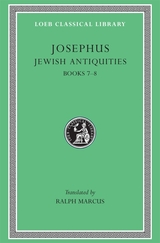 Jewish Antiquities, Volume III: Books 7–8
Josephus
Harvard University Press Greco-Roman antiquity’s premier Jewish historian.
Josephus, soldier, statesman, historian, was a Jew born at Jerusalem about AD 37. A man of high descent, he early became learned in Jewish law and Greek literature and was a Pharisee. After pleading in Rome the cause of some Jewish priests he returned to Jerusalem and in 66 tried to prevent revolt against Rome, managing for the Jews the affairs of Galilee. In the troubles that followed he made his peace with Vespasian. Present at the siege of Jerusalem by Titus, he received favors from these two as emperors and from Domitian, and assumed their family name Flavius. He died after 97.
As a historical source Josephus is invaluable. His major works are: History of the Jewish War, in seven books, from 170 BC to his own time, first written in Aramaic but translated by himself into the Greek we now have; and Jewish Antiquities, in twenty books, from the creation of the world to AD 66. The Loeb Classical Library edition of the works of Josephus, which is in thirteen volumes, also includes the autobiographical Life and his treatise Against Apion.
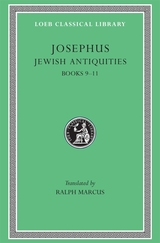 Jewish Antiquities, Volume IV: Books 9–11
Josephus
Harvard University Press Greco-Roman antiquity’s premier Jewish historian.
Josephus, soldier, statesman, historian, was a Jew born at Jerusalem about AD 37. A man of high descent, he early became learned in Jewish law and Greek literature and was a Pharisee. After pleading in Rome the cause of some Jewish priests he returned to Jerusalem and in 66 tried to prevent revolt against Rome, managing for the Jews the affairs of Galilee. In the troubles that followed he made his peace with Vespasian. Present at the siege of Jerusalem by Titus, he received favors from these two as emperors and from Domitian, and assumed their family name Flavius. He died after 97.
As a historical source Josephus is invaluable. His major works are: History of the Jewish War, in seven books, from 170 BC to his own time, first written in Aramaic but translated by himself into the Greek we now have; and Jewish Antiquities, in twenty books, from the creation of the world to AD 66. The Loeb Classical Library edition of the works of Josephus, which is in thirteen volumes, also includes the autobiographical Life and his treatise Against Apion.
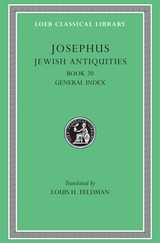 Jewish Antiquities, Volume IX: Book 20. General Index
Josephus
Harvard University Press, 2004 Greco-Roman antiquity’s premier Jewish historian.
Josephus, soldier, statesman, historian, was a Jew born at Jerusalem about AD 37. A man of high descent, he early became learned in Jewish law and Greek literature and was a Pharisee. After pleading in Rome the cause of some Jewish priests he returned to Jerusalem and in 66 tried to prevent revolt against Rome, managing for the Jews the affairs of Galilee. In the troubles that followed he made his peace with Vespasian. Present at the siege of Jerusalem by Titus, he received favors from these two as emperors and from Domitian, and assumed their family name Flavius. He died after 97.
As a historical source Josephus is invaluable. His major works are: History of the Jewish War, in seven books, from 170 BC to his own time, first written in Aramaic but translated by himself into the Greek we now have; and Jewish Antiquities, in twenty books, from the creation of the world to AD 66. The Loeb Classical Library edition of the works of Josephus, which is in thirteen volumes, also includes the autobiographical Life and his treatise Against Apion.
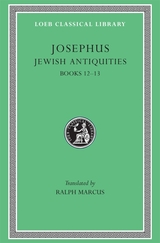 Jewish Antiquities, Volume V: Books 12–13
Josephus
Harvard University Press Greco-Roman antiquity’s premier Jewish historian.
Josephus, soldier, statesman, historian, was a Jew born at Jerusalem about AD 37. A man of high descent, he early became learned in Jewish law and Greek literature and was a Pharisee. After pleading in Rome the cause of some Jewish priests he returned to Jerusalem and in 66 tried to prevent revolt against Rome, managing for the Jews the affairs of Galilee. In the troubles that followed he made his peace with Vespasian. Present at the siege of Jerusalem by Titus, he received favors from these two as emperors and from Domitian, and assumed their family name Flavius. He died after 97.
As a historical source Josephus is invaluable. His major works are: History of the Jewish War, in seven books, from 170 BC to his own time, first written in Aramaic but translated by himself into the Greek we now have; and Jewish Antiquities, in twenty books, from the creation of the world to AD 66. The Loeb Classical Library edition of the works of Josephus, which is in thirteen volumes, also includes the autobiographical Life and his treatise Against Apion.
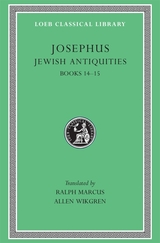 Jewish Antiquities, Volume VI: Books 14–15
Josephus
Harvard University Press Greco-Roman antiquity’s premier Jewish historian.
Josephus, soldier, statesman, historian, was a Jew born at Jerusalem about AD 37. A man of high descent, he early became learned in Jewish law and Greek literature and was a Pharisee. After pleading in Rome the cause of some Jewish priests he returned to Jerusalem and in 66 tried to prevent revolt against Rome, managing for the Jews the affairs of Galilee. In the troubles that followed he made his peace with Vespasian. Present at the siege of Jerusalem by Titus, he received favors from these two as emperors and from Domitian, and assumed their family name Flavius. He died after 97.
As a historical source Josephus is invaluable. His major works are: History of the Jewish War, in seven books, from 170 BC to his own time, first written in Aramaic but translated by himself into the Greek we now have; and Jewish Antiquities, in twenty books, from the creation of the world to AD 66. The Loeb Classical Library edition of the works of Josephus, which is in thirteen volumes, also includes the autobiographical Life and his treatise Against Apion.
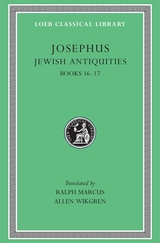 Jewish Antiquities, Volume VII: Books 16–17
Josephus
Harvard University Press Greco-Roman antiquity’s premier Jewish historian.
Josephus, soldier, statesman, historian, was a Jew born at Jerusalem about AD 37. A man of high descent, he early became learned in Jewish law and Greek literature and was a Pharisee. After pleading in Rome the cause of some Jewish priests he returned to Jerusalem and in 66 tried to prevent revolt against Rome, managing for the Jews the affairs of Galilee. In the troubles that followed he made his peace with Vespasian. Present at the siege of Jerusalem by Titus, he received favors from these two as emperors and from Domitian, and assumed their family name Flavius. He died after 97.
As a historical source Josephus is invaluable. His major works are: History of the Jewish War, in seven books, from 170 BC to his own time, first written in Aramaic but translated by himself into the Greek we now have; and Jewish Antiquities, in twenty books, from the creation of the world to AD 66. The Loeb Classical Library edition of the works of Josephus, which is in thirteen volumes, also includes the autobiographical Life and his treatise Against Apion.
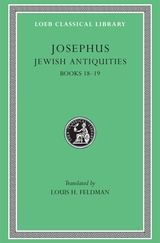 Jewish Antiquities, Volume VIII: Books 18–19
Josephus
Harvard University Press Greco-Roman antiquity’s premier Jewish historian.
Josephus, soldier, statesman, historian, was a Jew born at Jerusalem about AD 37. A man of high descent, he early became learned in Jewish law and Greek literature and was a Pharisee. After pleading in Rome the cause of some Jewish priests he returned to Jerusalem and in 66 tried to prevent revolt against Rome, managing for the Jews the affairs of Galilee. In the troubles that followed he made his peace with Vespasian. Present at the siege of Jerusalem by Titus, he received favors from these two as emperors and from Domitian, and assumed their family name Flavius. He died after 97.
As a historical source Josephus is invaluable. His major works are: History of the Jewish War, in seven books, from 170 BC to his own time, first written in Aramaic but translated by himself into the Greek we now have; and Jewish Antiquities, in twenty books, from the creation of the world to AD 66. The Loeb Classical Library edition of the works of Josephus, which is in thirteen volumes, also includes the autobiographical Life and his treatise Against Apion.
 Jewish Artists in New York: The Holocaust Years
Baigell, Matthew
Rutgers University Press, 2002 Calling attention to the local cultural scene as well as to events taking place in Europe, Matthew Baigell considers the art produced by Jewish artists who were inspired to respond to the murders of their fellow Jews during World War II. Although there were only a few instances of visual documentation of events until the war’s later stages, responses to news reports and the very few authentic images received of the atrocities of the Holocaust varied from avoidance and denial to scattered attempts to create direct visual representations. Those artists who chose the latter alternative did so with little support from the Jewish intelligentsia of New York City. Art critics such as the influential Clement Greenberg purposely avoided addressing this issue at all. Jewish artists were left to cope with the events of the war in isolation, without a collective visual memory to deal with the traumas presented by news reports. Baigell discusses how the limited access to images, information, and support during the war led to a unique artistic response created not only by the conflict itself, but also by the anti-Semitic social climate of the United States. Surveys taken in the U.S. between 1940 and 1946 demonstrate that the general population considered Jews a greater menace to the welfare of the country than the Germans or the Japanese. Artists featured include Marc Chagall, Jacques Lipchitz, Barnett Newman, Abraham Rattner, Mark Rothko, and Max Weber.
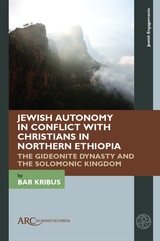 Jewish Autonomy in Conflict with Christians in Northern Ethiopia: The Gideonite Dynasty and the Solomonic Kingdom
Bar Kribus
Arc Humanities Press, 2025 Medieval and early modern Jews usually lived as a minority under non-Jewish rule, but there are a few known cases of independent or autonomous Jewish polities. One of the most intriguing is the autonomous Betä Ǝsraʾel (Ethiopian Jews) in the Sǝmen Mountains of Ethiopia. Betä Ǝsraʾel oral tradition refers to this polity as the “Kingdom of the Gideonites.” From the fifteenth to the seventeenth century, the Betä Ǝsraʾel of the Sǝmen and its surroundings were involved in a series of wars against the Christian Solomonic kingdom, until finally being subdued in the late 1620s. Based, in part, on the archaeological survey of Betä Ǝsra’el monastic sites, this book examines not only textual and oral accounts, but also the historical geography of the Betä Ǝsraʾel polity and its strongholds. It also discusses the commemoration of these wars in later times and their impact on the development of religious sites.
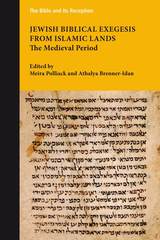 Jewish Biblical Exegesis from Islamic Lands: The Medieval Period
Meira Polliack
SBL Press, 2019 An accessible point of entry into the rich medieval religious landscape of Jewish biblical exegesis s
Medieval Judeo-Arabic translations of the Hebrew Bible and their commentaries provide a rich source for understanding a formative period in the intellectual, literary, and cultural history and heritage of Jews in Islamic lands. The carefully selected texts in this volume offer intriguing insight into Arabic translations and commentaries by Rabbanite and Karaite Jewish exegetes from the tenth to the twelfth centuries CE, arranged according to the three divisions of the Torah, the Former and Latter Prophets, and the Writings. Each text is embedded within an essay discussing its exegetical context, reception, and contribution.
Features:
- Focus on underrepresented medieval Jewish commentators of the Eastern world
- A list of additional resources, including major Judeo-Arabic commentators in the medieval period
- Previously unpublished texts from the Cairo Geniza
 Jewish Budapest: Monuments, Rites, History
Géza Komoróczy
Central European University Press, 1999 As a painting by Chagall unfolds layer upon layer when viewed carefully, so does the city in Jewish Budapest. Neither a guidebook or a history in the traditional sense, this book is about the Jewish face of Budapest from medieval times to the present. To get the broadest possible perspective, this book is not only about the Hungarian capital as a Jewish city but, as befits a cosmopolitan metropolis, delves into its myriad elements. There was and is, as Jewish Budapest strikingly reveals, a Roman and a Greek – Catholic Budapest, a Lutheran and a Calvinist Budapest, a German, a Serbian and a Gypsy Budapest. All these are brought into play as backdrop to the main narrative about the history of Jews in Buda, Obuda, and Pest. Past and present Jewish life as an organic part of the life of the Hungarian capital Budapest – be it memory or living reality. Richly illustrated with wonderfully evocative literary line drawings and photos, the book includes a lavish, full-colour section of artwork that enhances the text. Here is a book at once personal and universal. It is about everyday Jewish life, the humor, the pathos, the human condition, which is the same or very similar anywhere in the Diaspora. Every image and incident, every happening is filtered through the strong sensibilities of the key citizens of the city throughout the past few centuries. Remarkable citizens personified by the likes of Theodor Herzl and Joseph Pulitzer. The city is itself the central character of this book. The authors write only about those parts where there is a story to tell. They talk about places where history is still visible, where it can be located, where its traces still exist, where it can be tasted, savoured, and where it surrounds us as part of life in Budapest today. Jewish Budapest amasses huge amounts of lore about the city, its monuments and relics, its language and scholarship, its cultural heart, and its intellectual core. Jewish Budapest proceeds according to the chronological sequence of the birth of the Jewish quarters in the city, focusing on patterns of settlement and occupation, and demography, and unfolds finally into a vision of the future of Jewish life in this remarkably vibrant, venerable city. The book includes a section of detailed comments on the illustrations with an explanation of the abbreviations throughout as well as a bibliography, an index of personal names, an index of cities and towns, and an index of Budapest street addresses.
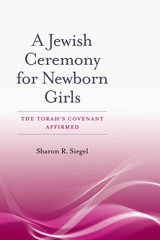 A Jewish Ceremony for Newborn Girls: The Torah’s Covenant Affirmed
Sharon R. Siegel
Brandeis University Press, 2014 This engaging book offers the first in-depth analysis of the history, philosophy, and social trends that underpin modern welcoming ceremonies for newborn girls in the Jewish community. Sharon R. Siegel traces the arc of these ceremonies from their emergence in the 1970s until today. She also delves into the history of how Jewish girls have been named over the centuries and explores how this history can shape contemporary welcoming practices. Siegel builds on the notion that modern ceremonies should focus on a newborn girl’s entry into the covenant between God and Israel and examines classic Jewish texts that speak to the critical question of women’s inclusion in the covenant. A bold new perspective on the relation between the covenant and male circumcision reveals why the covenantal status of Jewish women stands independent of this male rite. Siegel formulates a vision for the next phase in the development of Jewish rituals for newborn girls by placing these new rituals within the context of Jewish law (halacha) and synthesizing a vast array of pertinent customs, imagery, and texts. Bridging traditional Jewish beliefs and modern feminist ideals, Siegel’s powerful insights draw on her experiences and personal feminist philosophy. A Jewish Ceremony for Newborn Girls is an erudite and thought-provoking narrative that will inspire wide-ranging discussions about how and why to commemorate the birth of Jewish girls.
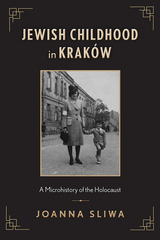 Jewish Childhood in Kraków: A Microhistory of the Holocaust
Joanna Sliwa
Rutgers University Press, 2021 Winner of the 2020 Ernst Fraenkel Prize from the Wiener Holocaust Library
Jewish Childhood in Kraków is the first book to tell the history of Kraków in the second World War through the lens of Jewish children’s experiences. Here, children assume center stage as historical actors whose recollections and experiences deserve to be told, analyzed, and treated seriously.
Sliwa scours archives to tell their story, gleaning evidence from the records of the German authorities, Polish neighbors, Jewish community and family, and the children themselves to explore the Holocaust in German-occupied Poland and in Kraków in particular. A microhistory of a place, a people, and daily life, this book plumbs the decisions and behaviors of ordinary people in extraordinary times.
Offering a window onto human relations and ethnic tensions in times of rampant violence, Jewish Childhood in Kraków is an effort both to understand the past and to reflect on the position of young people during humanitarian crises.
 Jewish Claims Against East Germany
Angelika Timm
Central European University Press, 1998 This is the first comprehensive history of Jewish negotiations with East Germany regarding restitution and reparations for Nazi war crimes. Angelika Timm analyzes the politics of old and new anti-Semitism and the context in which they grew under the officially propagated ideology of antifascism.
Investigating the mass of unpublished, newly available archival data from the United States, Israel, and the former German Democratic Republic, and more than forty personal interviews, Timm fills a critical gap in the scholarship on postwar Germany. She analyzes the role of the Holocaust and the image of Jews in the historical consciousness and political culture of East Germany and chronicles the efforts of Jewish organizations, especially the Conference on Jewish Material Claims Against Germany, to negotiate reparations with the East German state. The unique relationship between ideology and Realpolitik defined the manner in which East Germany confronted the crimes of its past and allowed anti-Semitism to reemerge.
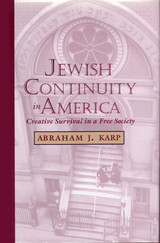 Jewish Continuity in America: Creative Survival in a Free Society
Abraham J. Karp
University of Alabama Press, 1998 Presents an overview of a life's work by a preeminent scholar and brings new insight to the challenge of American Jewish continuity Jews have historically lived within a paradox of faith and fear: faith that they are an eternal people and fear that their generation may be the last. In the United States, the Jewish community has faced to a heightened degree the enduring question of identity and assimilation: How does the Jewish community in this free, open, pluralistic society discover or create factors-both ideological and existential-that make group survival beneficial to the larger society and rewarding to the individual Jew? Abraham J. Karp's Jewish Continuity in America focuses on the three major sources of American Judaism's continuing vitality: the synagogue, the rabbinate, and Jewish religious pluralism. Particularly illuminating is Karp's examination of the coexistence and unity-in-diversity of American religious Jewry's three divisions-Orthodox, Reform, and Conservative-and of how this Jewish religious pluralism fits into the larger picture of American religious pluralism. Informing the larger enterprise through sharp and full delineation of discrete endeavors, the essays collected in Jewish Continuity in America-some already acknowledged as classics, some appearing here for the first time-describe creative individual and communal responses to the challenge of Jewish survival. As the title suggests, this book argues that continuity in a free and open society demands a high order of creativity, a creativity that, to be viable, must be anchored in institutions wholly pledged to continuity.
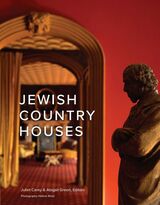 Jewish Country Houses
Edited by Juliet Carey and Abigail Green
Brandeis University Press, 2024 An exploration of the world of Jewish country houses, their architecture and collections, and the lives of the extraordinary men and women who created, transformed, and shaped them.
Country houses are powerful symbols of national identity, evoking the glamorous world of the landowning aristocracy. Jewish country houses—properties that were owned, built, or renewed by Jews—tell a more complex story of prejudice and integration, difference and connection. Many had spectacular art collections and gardens. Some were stages for lavish entertaining, while others inspired the European avant-garde. A few are now museums of international importance, many more are hidden treasures, and all were beloved homes that bear witness to the remarkable achievements of newly emancipated Jews across Europe—and to a dream of belonging that mostly came to a brutal end with the Holocaust.
Lavishly illustrated with historical images and a new body of work by the celebrated photographer Hélène Binet, this book is the first to tell the story of Jewish country houses, from the playful historicism of the National Trust’s Waddesdon Manor in Buckinghamshire to the modernist masterpiece that is the Villa Tugendhat in the Czech city of Brno—and across the pond to the United States, where American Jews infused the European country house tradition with their own distinctive concerns and experiences. This book emerges from a four-year research project funded by the UK Arts and Humanities Research Council that aims to establish Jewish country houses as a focus for research, a site of European memory, and a significant aspect of European Jewish heritage and material culture.
 Jewish Cuisine in Hungary: A Cultural History with 83 Authentic Recipes
András Koerner
Central European University Press, 2020 Winner of the 2019 National Jewish Book Award in the category of Food Writing & Cookbooks. The author refuses to accept that the world of pre-Shoah Hungarian Jewry and its cuisine should disappear almost without a trace and feels compelled to reconstruct its culinary culture. His book―with a preface by Barbara Kirshenblatt-Gimblett―presents eating habits not as isolated acts, divorced from their social and religious contexts, but as an organic part of a way of life. According to Kirshenblatt-Gimblett: “While cookbooks abound, there is no other study that can compare with this book. It is simply the most comprehensive account of a Jewish food culture to date.” Indeed, no comparable study exists about the Jewish cuisine of any country, or―for that matter―about Hungarian cuisine. It describes the extraordinary diversity that characterized the world of Hungarian Jews, in which what could or could not be eaten was determined not only by absolute rules, but also by dietary traditions of particular religious movements or particular communities. Ten chapters cover the culinary culture and eating habits of Hungarian Jewry up to the 1940s, ranging from kashrut (the system of keeping the kitchen kosher) through the history of cookbooks, the food traditions of weekdays and holidays, the diversity of households, and descriptions of food and hospitality industries to the history of some typical dishes. Although this book is primarily a cultural history and not a cookbook, it includes 83 recipes, as well as nearly 200 fascinating pictures of daily life and documents.i
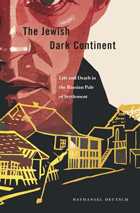 The Jewish Dark Continent: Life and Death in the Russian Pale of Settlement
Nathaniel Deutsch
Harvard University Press, 2011 At the turn of the twentieth century, over forty percent of the world’s Jews lived within the Russian Empire, almost all in the Pale of Settlement. From the Baltic to the Black Sea, the Jews of the Pale created a distinctive way of life little known beyond its borders. This led the historian Simon Dubnow to label the territory a Jewish “Dark Continent.”
Just before World War I, a socialist revolutionary and aspiring ethnographer named An-sky pledged to explore the Pale. He dreamed of leading an ethnographic expedition that would produce an archive—what he called an Oral Torah of the common people rather than the rabbinic elite—which would preserve Jewish traditions and transform them into the seeds of a modern Jewish culture. Between 1912 and 1914, An-sky and his team collected jokes, recorded songs, took thousands of photographs, and created a massive ethnographic questionnaire. Consisting of 2,087 questions in Yiddish—exploring the gamut of Jewish folk beliefs and traditions, from everyday activities to spiritual exercises to marital intimacies—the Jewish Ethnographic Program constitutes an invaluable portrait of Eastern European Jewish life on the brink of destruction.
Nathaniel Deutsch offers the first complete translation of the questionnaire, as well as the riveting story of An-sky’s almost messianic efforts to create a Jewish ethnography in an era of revolutionary change. An-sky’s project was halted by World War I, and within a few years the Pale of Settlement would no longer exist. These survey questions revive and reveal shtetl life in all its wonder and complexity.
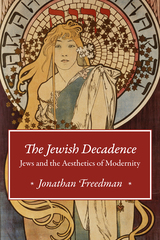 The Jewish Decadence: Jews and the Aesthetics of Modernity
Jonathan Freedman
University of Chicago Press, 2021 As Jewish writers, artists, and intellectuals made their way into Western European and Anglo-American cultural centers, they encountered a society obsessed with decadence. An avant-garde movement characterized by self-consciously artificial art and literature, philosophic pessimism, and an interest in nonnormative sexualities, decadence was also a smear, whereby Jews were viewed as the source of social and cultural decline. In The Jewish Decadence, Jonathan Freedman argues that Jewish engagement with decadence played a major role in the emergence of modernism and the making of Jewish culture from the 1870s to the present.
The first to tell this sweeping story, Freedman demonstrates the centrality of decadence to the aesthetics of modernity and its inextricability from Jewishness. Freedman recounts a series of diverse and surprising episodes that he insists do not belong solely to the past, but instead reveal that the identification of Jewishness with decadence persists today.
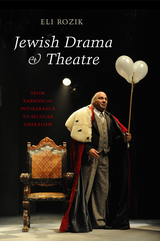 Jewish Drama & Theatre: From Rabbinical Intolerance to Secular Liberalism
Eli Rozik
Sussex Academic Press, 2022 Jewish drama and theatre has followed a tortuous path from extreme rabbinical intolerance to eventual secular liberalism, with its openness to the heritages of both Judaism as a culture and prominent foreign cultures, to the extent of multicultural integration. No wonder, therefore, that since biblical times until the seventeenth century there are only examples of tangential theatre practices. This initial intolerance, shared by the Church, was rooted in pagan connotations of theatre rather than in the neutral nature of the theatre medium, capable of formulating and communicating contrasting thoughts. Whereas by the tenth century the Church understood that theatre could be harnessed to its own ends, Jewish theatre was only created seven centuries later through spontaneous and amateurish theatrical practices, such as the Yiddish purim-shpil and the purim-rabbi. Due to their carnivalesque and cathartic nature these practices were tolerated by the rabbinical establishment, albeit only during the Purim holiday. But as a result, Jewish drama and theatre were created and emerged despite rabbinical antagonism. Under the influence of the Jewish Enlightenment, Yiddish-speaking theatres were increasingly established, a trend that became central in the cultural enterprise of the Jews in Israel. This process involved a renewed use of Hebrew as a spoken language, and the transition from a profound religious identity to a secular Jewish one, characterised by a basic liberalism to the extent of openness to cultures traditionally perceived as archetypal enemies of Judaism. This book sets out to analyse play-scripts and performance-texts produced in the Israeli theatre in order to illustrate these trends, and concludes that only a liberal society can bring about the full realisation of theatre's potentialities.
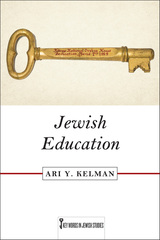 Jewish Education
Ari Y Kelman
Rutgers University Press, 2024 Most writing about Jewish education has been preoccupied with two questions: What ought to be taught? And what is the best way to teach it? Ari Y Kelman upends these conventional approaches by asking a different question: How do people learn to engage in Jewish life? This book, by centering learning, provides an innovative way of approaching the questions that are central to Jewish education specifically and to religious education more generally.
At the heart of Jewish Education is an innovative alphabetical primer of Jewish educational values, qualities, frameworks, catalysts, and technologies which explore the historical ways in which Jewish communities have produced and transmitted knowledge. The book examines the tension between Jewish education and Jewish Studies to argue that shifting the locus of inquiry from “what people ought to know” to “how do people learn” can provide an understanding of Jewish education that both draws on historical precedent and points to the future of Jewish knowledge.
 The Jewish Enemy: Nazi Propaganda during World War II and the Holocaust
Jeffrey Herf
Harvard University Press, 2008 The sheer magnitude of the Holocaust has commanded our attention for the past sixty years. The extent of atrocities, however, has overshadowed the calculus Nazis used to justify their deeds.
According to German wartime media, it was German citizens who were targeted for extinction by a vast international conspiracy. Leading the assault was an insidious, belligerent Jewish clique, so crafty and powerful that it managed to manipulate the actions of Roosevelt, Churchill, and Stalin. Hitler portrayed the Holocaust as a defensive act, a necessary move to destroy the Jews before they destroyed Germany.
Joseph Goebbels, Minister of Propaganda, and Otto Dietrich’s Press Office translated this fanatical vision into a coherent cautionary narrative, which the Nazi propaganda machine disseminated into the recesses of everyday life. Calling on impressive archival research, Jeffrey Herf recreates the wall posters that Germans saw while waiting for the streetcar, the radio speeches they heard at home or on the street, the headlines that blared from newsstands. The Jewish Enemy is the first extensive study of how anti-Semitism pervaded and shaped Nazi propaganda during World War II and the Holocaust, and how it pulled together the diverse elements of a delusionary Nazi worldview. Here we find an original and haunting exposition of the ways in which Hitler legitimized war and genocide to his own people, as necessary to destroy an allegedly omnipotent Jewish foe. In an era when both anti-Semitism and conspiracy theories continue to influence world politics, Herf offers a timely reminder of their dangers along with a fresh interpretation of the paranoia underlying the ideology of the Third Reich.
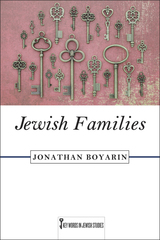 Jewish Families
Boyarin, Jonathan
Rutgers University Press, 2013 From stories of biblical patriarchs and matriarchs and their children, through the Gospel’s Holy Family of Jesus, Mary, and Joseph, and to modern Jewish families in fiction, film, and everyday life, the family has been considered key to transmitting Jewish identity. Current discussions about the Jewish family’s supposed traditional character and its alleged contemporary crisis tend to assume that the dynamics of Jewish family life have remained constant from the days of Abraham and Sarah to those of Tevye and Golde in Fiddler on the Roof and on to Philip Roth’s Portnoy’s Complaint.
Jonathan Boyarin explores a wide range of scholarship in Jewish studies to argue instead that Jewish family forms and ideologies have varied greatly throughout the times and places where Jewish families have found themselves. He considers a range of family configurations from biblical times to the twenty-first century, including strictly Orthodox communities and new forms of family, including same-sex parents. The book shows the vast canvas of history and culture as well as the social pressures and strategies that have helped shape Jewish families, and suggests productive ways to think about possible futures for Jewish family forms.
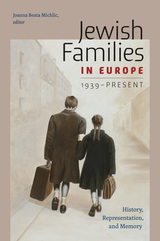 Jewish Families in Europe, 1939-Present: History, Representation, and Memory
Edited by Joanna Beata Michlic
Brandeis University Press, 2017 This book offers an extensive introduction and 13 diverse essays on how World War II, the Holocaust, and their aftermath affected Jewish families and Jewish communities, with an especially close look at the roles played by women, youth, and children. Focusing on Eastern and Central Europe, themes explored include: how Jewish parents handled the Nazi threat; rescue and resistance within the Jewish family unit; the transformation of gender roles under duress; youth’s wartime and early postwar experiences; postwar reconstruction of the Jewish family; rehabilitation of Jewish children and youth; and the role of Zionism in shaping the present and future of young survivors. Relying on newly available archival material and novel research in the areas of families, youth, rescue, resistance, gender, and memory, this volume will be an indispensable guide to current work on the familial and social history of the Holocaust.
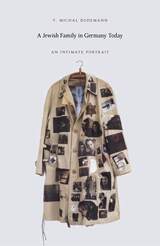 A Jewish Family in Germany Today: An Intimate Portrait
Y. Michal Bodemann
Duke University Press, 2005 Immediately after the Holocaust, it seemed inconceivable that a Jewish community would rebuild in Germany. What was once unimaginable has now come to pass: Germany is home to one of Europe’s most vibrant Jewish communities, and it has the fastest growing Jewish immigrant population of any country in the world outside Israel. By sharing the life stories of members of one Jewish family—the Kalmans—Y. Michal Bodemann provides an intimate look at what it is like to live as a Jew in Germany today. Having survived concentration camps in Poland, four Kalman siblings—three brothers and a sister—were left stranded in Germany after the war. They built new lives and a major enterprise; they each married and had children. Over the past fifteen years Bodemann conducted extensive interviews with the Kalmans, mostly with the survivors’ ten children, who were born between 1948 and 1964. In these oral histories, he shares their thoughts on Judaism, work, family, and community. Staying in Germany is not a given; four of the ten cousins live in Israel and the United States. Among the Kalman cousins are an art gallery owner, a body builder, a radio personality, a former chief financial officer of a prominent U.S. bank, and a sculptor. They discuss Zionism, anti-Semitism, what it means to root for the German soccer team, Schindler’s List, money, success, marriage and intermarriage, and family history. They reveal their different levels of engagement with Judaism and involvement with local Jewish communities. Kalman is a pseudonym, and their anonymity allows the family members to talk with passion and candor about their relationships and their lives as Jews.
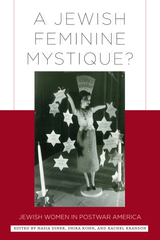 A Jewish Feminine Mystique?: Jewish Women in Postwar America
Edited by Hasia R. Diner, Shira Kohn, and Rachel Kranson
Rutgers University Press, 2010 In The Feminine Mystique, Jewish-raised Betty Friedan struck out against a postwar American culture that pressured women to play the role of subservient housewives. However, Friedan never acknowledged that many American women refused to retreat from public life during these years. Now, A Jewish Feminine Mystique? examines how Jewish women sought opportunities and created images that defied the stereotypes and prescriptive ideology of the "feminine mystique."
As workers with or without pay, social justice activists, community builders, entertainers, and businesswomen, most Jewish women championed responsibilities outside their homes. Jewishness played a role in shaping their choices, shattering Friedan's assumptions about how middle-class women lived in the postwar years. Focusing on ordinary Jewish women as well as prominent figures such as Judy Holliday, Jennie Grossinger, and Herman Wouk's fictional Marjorie Morningstar, leading scholars explore the wide canvas upon which American Jewish women made their mark after the Second World War.
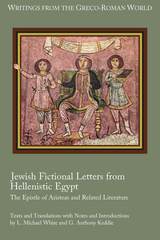 Jewish Fictional Letters from Hellenistic Egypt: The Epistle of Aristeas and Related Literature
L. Michael White
SBL Press, 2017 The first Greek text of the Epistle of Aristeas published in more than a century
The Greek text Epistle of Aristeas is a Jewish work of the late Hellenistic period that recounts the origins of the Septuagint. Long recognized as a literary fiction, the Epistle of Aristeas has been variously dated from the third century BCE to the first century CE. As a result, its epistolary features, and especially those in which the putative author, Aristeas, addresses his brother and correspondent, Philocrates, have largely been ignored. In light of more recent scholarship on epistolary literature in the Greco-Roman world, however, this volume presents for the first time a complete Greek text and English Translation with introduction, notes, and commentary of the Epistle of Aristeas with key testimonia from Philo, Josephus, and Eusebius, as well as other related examples of Jewish fictional letters from the Apocrypha and Pseudepigrapha.
Features
- Relevant excerpts from Eupolemus, 2 Maccabees, 3 Maccabees, and the Greek Additions to Esther with translations and introductions
- A critical introduction to ancient Greek letter-writing
- An outline of epistolary features in the text
 Jewish Fundamentalism in Israel
Israel Shahak
Pluto Press, 2004 This is a new edition of a classic and highly controversial book that examines the history and consequences of Jewish Fundamentalism in Israel. Fully updated, with new chapters and a new introduction by Norton Mezvinsky, it is essential reading for anyone who wants a full understanding of the way religious extremism has affected the political development of the modern Israeli state.
Acclaimed writer and human rights campaigner Israel Shahak was, up util his death in 2001, one of the most respected of Israel’s peace activists – he was, in the words of Gore Vidal, ‘the latest – if not the last – of the great prophets.’ Written by Shahak together with American scholar Norton Mezvinsky, this books shows how Jewish fundamentalism in Israel, as shown in the activities of religious settlers, is of great political importance.
The authors trace the history and development of Jewish fundamentalism. They place the assassination of Prime Minister Rabin in the context of what they see as a tradition of punishments and killings of those Jews perceived to be heretics. They conclude that Jewish fundamentalism is essentially hostile to democracy.
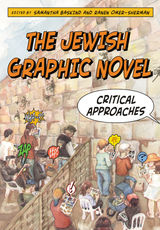 The Jewish Graphic Novel: Critical Approaches
Edited by Samantha Baskind and Ranen Omer-Sherman
Rutgers University Press, 2008 In the 1970s and 1980s Jewish cartoonists such as Will Eisner were some of the first artists to use the graphic novel as a way to explore their ethnicity. Although similar to their pop culture counterpart, the comic book, graphic novels presented weightier subject matter in more expensive packaging, which appealed to an adult audience and gained them credibility as a genre. The Jewish Graphic Novel is a lively, interdisciplinary collection of essays that addresses critically acclaimed works in this subgenre of Jewish literary and artistic culture. Featuring insightful discussions of notable figures in the industryùsuch as Will Eisner, Art Spiegelman, and Joann Sfarùthe essays focus on the how graphic novels are increasingly being used in Holocaust memoir and fiction, and to portray Jewish identity in America and abroad Featuring more than 85 illustrations, this collection is a compelling representation of a major postmodern ethnic and artistic achievement.
Jewish History, Jewish Religion: The Weight of Three Thousand Years
Israel Shahak
Pluto Press, 2008 Israel Shahak was a remarkable man. Born in the Warsaw ghetto and a survivor of Belsen, Shahak arrived in Israel in 1945. Brought up under Jewish Orthodoxy and Hebrew culture, he consistently opposed the expansion of the borders of Israel from 1967.
In this extraordinary and highly acclaimed book, Shahak embarks on a provocative study of the extent to which the secular state of Israel has been shaped by religious orthodoxies of an invidious and potentially lethal nature. Drawing on the Talmud and rabbinical laws, Shahak argues that the roots of Jewish chauvinism and religious fanaticism must be understood before it is too late.
Written from a humanitarian viewpoint by a Jewish scholar, this is a rare and highly controversial criticism of Israel that will both excite and disturb readers worldwide.
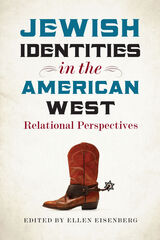 Jewish Identities in the American West: Relational Perspectives
Edited by Ellen Eisenberg
Brandeis University Press, 2022 Jewish Identities in the American West fills a significant gap in racial identity scholarship.
Since the onset of New Western History in the 1980s, the complexity of race and ethnicity as it developed in the American West has increasingly been recognized by scholars and the wider public alike. Ethnic studies scholars have developed new perspectives on racial formation in the West that complicate older notions that often relied on binary descriptions, such as Black/white racialization. In the past few decades, these studies have relied on relational approaches that focus on how race is constructed, by both examining interactions with the white dominant group, and by exploring the multiple connections with other racial/ethnic groups in society. Historians are discovering new stories of racial construction, and revising older accounts, to integrate these new perspectives into the formation of racial and ethnic identities. This collection of essays on Jews in the American West advances this field in multiple ways. With essays that cover the period from the mid-nineteenth century to the present, these authors present a collective portrait of change over time that allows us to view the shifting nature of Jewish identity in the West, as well as the evolving frameworks for racial construction. Thorough and thought-provoking, Jewish Identities in the American West takes readers on a journey of racial and ethnic identity in the American West.
 Jewish Immigrant Associations and American Identity in New York, 1880-1939
Daniel Soyer
Harvard University Press, 1997 How did the vast number of Jewish immigrants from different regions of Eastern Europe form their American ethnic identity?
In his answer to this question, Daniel Soyer examines how Jewish immigrant hometown associations (landsmanshaftn) transformed old-world communal ties into vehicles for integration into American society. Focusing on New York--where some 3,000 associations enrolled nearly half a million members--this study is one of the first to explore the organizations' full range of activities, and to show how the newcomers exercised a high degree of agency in their growing identification with American society.
The wide variety of landsmanshaftn--from politically radical and secular to Orthodox and from fraternal order to congregation--illustrates the diversity of influences on immigrant culture. But nearly all of these societies adopted the democratic benefits and practices that were seen as the most positive aspects of American civic culture. In contrast to the old-country hierarchical dispensers of charity, the newcomers' associations relied on mutual aid for medical care, income support, burial, and other traditional forms of self-help. During World War I, the landsmanshaftn sent aid to their war-ravaged hometowns; by the 1930s, the common identity centered increasingly upon collective reminiscing and hometown nostalgia.
The example of the Jewish landsmanshaftn suggests that many immigrants cultivated their own identification with American society to a far greater extent than is usually recognized. It also suggests that they selectively identified with those aspects of American culture that allowed them to retain emotional attachments to old-country landscapes and a sense of kinship with those who shared their heritage.
 Jewish in America
Sara Blair and Jonathan Freedman, Editors
University of Michigan Press, 2004 "Jewish culture in America is creating a genuinely new archive---a powerful admixture of texts old and new, Jewish and gentile, sacred and secular, on which our writers and critics offer creative commentary and to which they make compelling response. Shaped in the American crucible of race and ethnicity, pushed and pulled by the American traditions of ahistorical and individualist thinking, empowered by a powerful sacramental and hermeneutic tradition yet challenged by that tradition's stunning variety of inflections, impelled to furious response by world crisis, these writers testify not only to the anguishing and joyous complexity of being Jewish in America, but the creative energies such multiplicity generates."
-From the Introduction
This rare and original work of cultural studies offers uncommon and engaging perspectives-as well as provocative and humorous insights-on what it means to be Jewish in America.
Jewish in America features poetry, art, essays, and stories from an impressive and respected list of contributors, including among others Stephen Greenblatt, Richard Kostelanetz, Jacqueline Osherow, Robert Pinsky, Sharon Pomerantz, Nancy Reisman, Grace Schulman, Louis Simpson, Alisa Solomon, and Stephen J. Whitfield.
In addition to pieces by some of the country's leading writers, the book features a stunning gallery of original photographs that transport the viewer from the crowded Coney Island beaches of the 1940s to the landscapes of Oaxaca, Mexico in the 1990s.
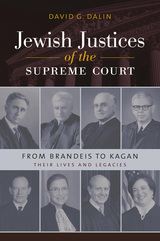 Jewish Justices of the Supreme Court: From Brandeis to Kagan
David G. Dalin
Brandeis University Press, 2017 Jewish Justices of the Supreme Court examines the lives, legal careers, and legacies of the eight Jews who have served or who currently serve as justices of the U.S. Supreme Court: Louis D. Brandeis, Benjamin Cardozo, Felix Frankfurter, Arthur Goldberg, Abe Fortas, Ruth Bader Ginsburg, Stephen G. Breyer, and Elena Kagan. David Dalin discusses the relationship that these Jewish justices have had with the presidents who appointed them, and given the judges’ Jewish background, investigates the antisemitism some of the justices encountered in their ascent within the legal profession before their appointment, as well as the role that antisemitism played in the attendant political debates and Senate confirmation battles. Other topics and themes include the changing role of Jews within the American legal profession and the views and judicial opinions of each of the justices on freedom of speech, freedom of religion, the death penalty, the right to privacy, gender equality, and the rights of criminal defendants, among other issues.
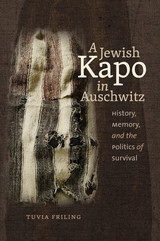 A Jewish Kapo in Auschwitz: History, Memory, and the Politics of Survival
Tuvia Friling
Brandeis University Press, 2014 Eliezer Gruenbaum (1908–1948) was a Polish Jew denounced for serving as a Kapo while interned at Auschwitz. He was the communist son of Itzhak Gruenbaum, the most prominent secular leader of interwar Polish Jewry who later became the chairman of the Jewish Agency’s Rescue Committee during the Holocaust and Israel’s first minister of the interior. In light of the father’s high placement in both Polish and Israeli politics, the denunciation of the younger Gruenbaum and his suspicious death during the 1948 Arab-Israeli war add intrigue to a controversy that really centers on the question of what constitutes—and how do we evaluate—moral behavior in Auschwitz. Gruenbaum—a Jewish Kapo, a communist, an anti-Zionist, a secularist, and the son of a polarizing Zionist leader—became a symbol exploited by opponents of the movements to which he was linked. Sorting through this Rashomon-like story within the cultural and political contexts in which Gruenbaum operated, Friling illuminates key debates that rent the Jewish community in Europe and Israel from the 1930s to the 1960s.
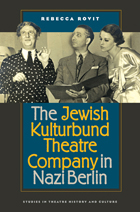 The Jewish Kulturbund Theatre Company in Nazi Berlin
Rebecca Rovit
University of Iowa Press, 2012 New laws enacted in the wake of Hitler’s ascent to power removed all Jews from their professional workplaces and banned Jewish artists from any collaboration with their fellow citizens. In the summer of 1933, Goebbels’s Prussian Theatre Commission approved an all-Jewish theatre as part of the Kulturbund Deutscher Juden, the Cultural Association of German Jewry. This network of Jewish cultural leagues and theatre ensembles across Germany coexisted with Nazi policies against Jews until the Gestapo dissolved the theatre in 1941. Revealing the complex interplay between history and human lives under conditions of duress, Rebecca Rovit focuses on the eight-year odyssey of the Berlin Kulturbund and its theatre. Rovit draws upon a wealth of primary documents—correspondence between the theatre and the Reich Ministry of Propaganda and Enlightenment, actual playscripts and rolebooks, production reviews and photographs, letters and memoirs, and interviews with artists who survived the war—to show how the increasingly restrictive German reality forced Jewish artists to define and redefine their identity and culture under wrenching conditions of censorship, compromise, danger, and deception. Integrating play analysis with cultural history, she considers first the playscript itself, then the playscript adapted by the Kulturbund, then the best reconstruction possible of the actual performance against its backdrop of the Third Reich. Proceeding chronologically through the playing seasons, she focuses on the actual repertoire performed (and forbidden) over the life of the Berlin Kulturbund theatre, covering the theatre’s beginnings and its first two playing seasons, then on the playing seasons that led to the Reichskristallnacht, and finally on the ways that emigration and increased censorship affected the wartime theatre’s final days. The Kulturbund’s directors were repeatedly caught between escalating demands from their Nazi overseers and from their own Jewish constituents. By examining why and how an all-Jewish repertory theatre could coexist with the Nazi regime, Rovit raises broader questions about the nature of art in an environment of coercion and isolation, artistic integrity and adaptability, and community and identity.
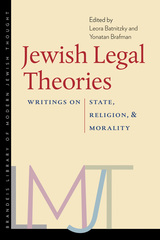 Jewish Legal Theories: Writings on State, Religion, and Morality
Edited by Leora Batnitzky and Yonatan Brafman
Brandeis University Press, 2018 Contemporary arguments about Jewish law uniquely reflect both the story of Jewish modernity and a crucial premise of modern conceptions of law generally: the claim of autonomy for the intellectual subject and practical sphere of the law. Jewish Legal Theories collects representative modern Jewish writings on law and provides short commentaries and annotations on these writings that situate them within Jewish thought and history, as well as within modern legal theory. The topics addressed by these documents include Jewish legal theory from the modern nation-state to its adumbration in the forms of Orthodox, Conservative, and Reform Judaism in the German-Jewish context; the development of Jewish legal philosophy in Eastern Europe beginning in the eighteenth century; Ultra-Orthodox views of Jewish law premised on the rejection of the modern nation-state; the role of Jewish law in Israel; and contemporary feminist legal theory.
 Jewish Life in Austria and Germany Since 1945: Identity and Communal Reconstruction
Susanne Cohen-Weisz
Central European University Press, 2016 Based on published primary and secondary materials and oral interviews with some eighty communal and organizational leaders, experts and scholars, this book provides a comparative account of the reconstruction of Jewish communal life in both Germany and in Austria (where 98% live in the capital, Vienna) after 1945. The author explains the process of reconstruction over the next six decades, and its results in each country. The monograph focuses on the variety of prevailing perceptions about topics such as: the state of Israel, one’s relationship to the country of residence, the Jewish religion, the aftermath of the Holocaust, and the influx of post-soviet immigrants. Cohen-Weisz examines the changes in Jewish group identity and its impact on the development of communities. The study analyzes the similarities and differences in regard to the political, social, institutional and identity developments within the two countries, and their changing attitudes and relationships with surrounding societies; it seeks to show the evolution of these two country’s Jewish communities in diverse national political circumstances and varying post-war governmental policies.
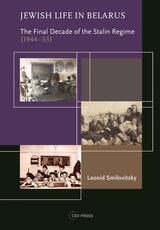 Jewish Life in Belarus: The Final Decade of the Stalin Regime, 1944-1953
Leonid Smilovitsky
Central European University Press, 2014 Jewish life in Belarus in the years after World War II was long an enigma. Officially it was held to be as being non-existent, and in the ideological atmosphere of the time research on the matter was impossible. Jewish community life had been wiped out by the Nazis, and information on its revival was suppressed by the communists. For more than half a century the truth about Jewish life during this period was sealed in inaccessible archives. The Jews of Belarus preferred to keep silent rather than expose themselves to the animosity of the authorities. Although the fate of Belarusian Jews before and during the war has now been amply studied, this book is one of the first attempts to study Jewish life in Belarus during the last decade of Stalin's rule. In addition to archival materials, the present research is based on a questionnaire submitted to former residents of Belarus in Israel, as well as information from periodicals, collections of documents, statistical reports and monographs.
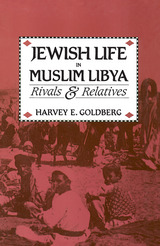 Jewish Life in Muslim Libya: Rivals and Relatives
Harvey E. Goldberg
University of Chicago Press, 1990 In 1949 more than 35,000 Jews lived in Libya, but close to ninety percent had left before Libya attained its independence in 1952. Jewish Life in Muslim Libya combines historical and anthropological perspectives in depicting the changing relations between Muslims and Jews in Libya from the early nineteenth century up to the middle of the twentieth century.
Harvey E. Goldberg shows that the cultural and religious worlds of the Jewish and Muslim communities in Libya were deeply intertwined in daily life and largely remained so despite political and social changes under successive Ottoman and Italian rule. He documents the intricate symbolic linkages of Jews and Muslims in different periods and in a variety of settings. His accounts of traditional Jewish weddings, of mock fights between Jewish teams that took place in early nineteenth-century Tripoli, and of the profession of street peddling demonstrate that, despite age-old images of Jews as outsiders or infidels, Jews were also an essential and familiar part of the local Islamic society.
Goldberg's narrative continues through the British Military Administration in Libya, a period which saw growing Libyan nationalism and, in 1945, three days of riots in which more than 130 Jews were killed. Goldberg reflects on how these events both expressed and exacerbated a rupture in the social fabric linking Muslims and Jews, setting the scene for the mass emigration of Libyan Jews from their homeland.
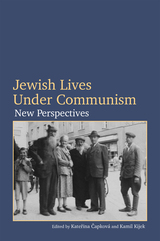 Jewish Lives under Communism: New Perspectives
Katerina Capková
Rutgers University Press, 2022 This volume provides new, groundbreaking views of Jewish life in various countries of the pro-Soviet bloc from the end of the Second World War until the collapse of Communism in late 1989. The authors, twelve leading historians and anthropologists from Europe, Israel and the United States, look at the experience of Jews under Communism by digging beyond formal state policy and instead examining the ways in which Jews creatively seized opportunities to develop and express their identities, religious and secular, even under great duress. The volume shifts the focus from Jews being objects of Communist state policy (and from anti-Jewish prejudices in Communist societies) to the agency of Jews and their creativity in Communist Europe after the Holocaust. The examination of Jewish history from a transnational vantage point challenges a dominant strand in history writing today, by showing instead the wide variety of Jewish experiences in law, traditions and institutional frameworks as conceived from one Communist country to another and even within a single country, such as Poland, Czechoslovakia, Hungary, East Germany, and the Soviet Union. By focusing on networks across east-central Europe and beyond and on the forms of identity open to Jews in this important period, the volume begins a crucial rethinking of social and cultural life under Communist regimes.
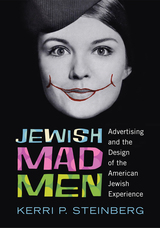 Jewish Mad Men: Advertising and the Design of the American Jewish Experience
Steinberg, Kerri P
Rutgers University Press, 2015 It is easy to dismiss advertising as simply the background chatter of modern life, often annoying, sometimes hilarious, and ultimately meaningless. But Kerri P. Steinberg argues that a careful study of the history of advertising can reveal a wealth of insight into a culture. In Jewish Mad Men, Steinberg looks specifically at how advertising helped shape the evolution of American Jewish life and culture over the past one hundred years.
Drawing on case studies of famous advertising campaigns—from Levy’s Rye Bread (“You don’t have to be Jewish to love Levy’s”) to Hebrew National hot dogs (“We answer to a higher authority”)—Steinberg examines advertisements from the late nineteenth-century in New York, the center of advertising in the United States, to trace changes in Jewish life there and across the entire country. She looks at ads aimed at the immigrant population, at suburbanites in midcentury, and at hipster and post-denominational Jews today.
In addition to discussing campaigns for everything from Manischewitz wine to matzoh, Jewish Mad Men also portrays the legendary Jewish figures in advertising—like Albert Lasker and Bill Bernbach—and lesser known “Mad Men” like Joseph Jacobs, whose pioneering agency created the brilliantly successful Maxwell House Coffee Haggadah. Throughout, Steinberg uses the lens of advertising to illuminate the Jewish trajectory from outsider to insider, and the related arc of immigration, acculturation, upward mobility, and suburbanization.
Anchored in the illustrations, photographs, jingles, and taglines of advertising, Jewish Mad Men features a dozen color advertisements and many black-and-white images. Lively and insightful, this book offers a unique look at both advertising and Jewish life in the United States.
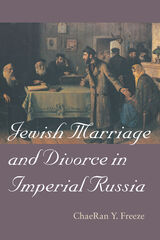 Jewish Marriage and Divorce in Imperial Russia
ChaeRan Y. Freeze
Brandeis University Press, 2001 ChaeRan Freeze explores the impact of various forces on marriage and divorce among Jews in 19th-century Russia. Challenging romantic views of the Jewish family in the shtetl, she shows that divorce rates among Russian Jews in the first half of the century were astronomical compared to the non-Jewish population. Even more surprising is her conclusion that these divorce rates tended to drop later in the century, in contrast to the rising pattern among populations undergoing modernization. Freeze also studies the growing involvement of the Tsarist state. This occurred partly at the behest of Jewish women contesting patriarchy and parental power and partly because the government felt that Jewish families were in complete anarchy and in need of order and regulation. Extensive research in newly-declassified collections from twelve archives in Russia, Ukraine, and Lithuania enables Freeze to reconstruct Jewish patterns of marriage and divorce and to analyze the often conflicting interests of Jewish husbands and wives, rabbinic authorities, and the Russian state. Balancing archival resources with memoirs and printed sources in Hebrew, Yiddish, and Russian, she offers a tantalizing glimpse of the desires and travails of Jewish spouses, showing how individual life histories reflect the impact of modernization on Jewish matchmaking, gender relations, the "emancipation" of Jewish women, and the incursion of the Tsarist state into the lives of ordinary Jews.
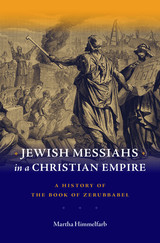 Jewish Messiahs in a Christian Empire: A History of the Book of Zerubbabel
Martha Himmelfarb
Harvard University Press, 2017 The seventh-century CE Hebrew work Sefer Zerubbabel (Book of Zerubbabel), composed during the period of conflict between Persia and the Byzantine Empire for control over Palestine, is the first full-fledged messianic narrative in Jewish literature. Martha Himmelfarb offers a comprehensive analysis of this rich but understudied text, illuminating its distinctive literary features and the complex milieu from which it arose.
Sefer Zerubbabel presents itself as an angelic revelation of the end of times to Zerubbabel, a biblical leader of the sixth century BCE, and relates a tale of two messiahs who, as Himmelfarb shows, play a major role in later Jewish narratives. The first messiah, a descendant of Joseph, dies in battle at the hands of Armilos, the son of Satan who embodies the Byzantine Empire. He is followed by a messiah descended from David modeled on the suffering servant of Isaiah, who brings him back to life and triumphs over Armilos. The mother of the Davidic messiah also figures in the work as a warrior.
Himmelfarb places Sefer Zerubbabel in the dual context of earlier Jewish eschatology and Byzantine Christianity. The role of the messiah’s mother, for example, reflects the Byzantine notion of the Virgin Mary as the protector of Constantinople. On the other hand, Sefer Zerubbabel shares traditions about the messiahs with rabbinic literature. But while the rabbis are ambivalent about these traditions, Sefer Zerubbabel embraces them with enthusiasm.
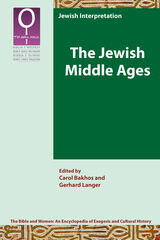 The Jewish Middle Ages
Carol Bakhos
SBL Press, 2023 For many, the Middle Ages in general evokes a sense of the sinister and brings to mind a world of fear, superstition, and religious fanaticism. For Jews it was a period marked by persecutions, pogroms, and expulsions. Yet at the same time, the Middle Ages was also a time of lively cultural exchange and heightened creativity for Jews. In The Jewish Middle Ages, contributors explore the ways in which the stories of biblical women, including, Eve, Sarah, Hagar, Rebekah, Zipporah, Ruth, Esther, and Judith, make their way into the rich tapestry of medieval Jewish literature, mystical texts, and art, particularly in works emanating from Ashkenazic circles. Contributors include Carol Bakhos, Judith R. Baskin, Elisheva Baumgarten, Dagmar Börner-Klein, Constanza Cordoni, Rachel Elior, Meret Gutmann-Grün, Robert A. Harris, Yuval Katz-Wilfing, Sheila Tuller Keiter, Katrin Kogman-Appel, Gerhard Langer, Aurora Salvatierra Ossorio, and Felicia Waldman. These essays give us a glimpse into the role women played and the authority they assumed in medieval Jewish culture beyond the rabbinic centers of Palestine and Babylonia.
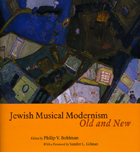 Jewish Musical Modernism, Old and New
Edited by Philip V. Bohlman
University of Chicago Press, 2009 Tackling the myriad issues raised by Sander Gilman’s provocative opening salvo—”Are Jews Musical?”—this volume’s distinguished contributors present a series of essays that trace the intersections of Jewish history and music from the late nineteenth century to the present.
Covering the sacred and the secular, the European and the non-European, and all the arenas where these realms converge, these essays recast the established history of Jewish culture and its influences on modernity. Mitchell Ash explores the relationship of Jewish scientists to modernist artists and musicians, while Edwin Seroussi looks at the creation of Jewish sacred music in nineteenth-century Vienna. Discussing Jewish musicologists in Austria and Germany, Pamela Potter details their contributions to the “science of music” as a modern phenomenon. Kay Kaufman Shelemay investigates European influence in the music of an Ethiopian Jewish community, and Michael P. Steinberg traces the life and works of Charlotte Salomon, whose paintings staged the destruction of the Holocaust. Bolstered by Philip V. Bohlman’s wide-ranging introduction and epilogue, and featuring lush color illustrations and a complementary CD of the period’s music, this volume is a lavish tribute to Jewish contributions to modernity.
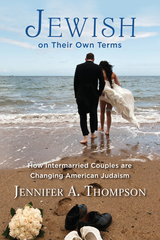 Jewish on Their Own Terms: How Intermarried Couples are Changing American Judaism
Thompson, Jennifer A
Rutgers University Press Over half of all American Jewish children are being raised by intermarried parents. This demographic group will have a tremendous impact on American Judaism as it is lived and practiced in the coming decades. To date, however, in both academic studies about Judaism and in the popular imagination, such children and their parents remain marginal. Jennifer A. Thompson takes a different approach. In Jewish on Their Own Terms, she tells the stories of intermarried couples, the rabbis and other Jewish educators who work with them, and the conflicting public conversations about intermarriage among American Jews. Thompson notes that in the dominant Jewish cultural narrative, intermarriage symbolizes individualism and assimilation. Talking about intermarriage allows American Jews to discuss their anxieties about remaining distinctively Jewish despite their success in assimilating into American culture. In contrast, Thompson uses ethnography to describe the compelling concerns of all of these parties and places their anxieties firmly within the context of American religious culture and morality. She explains how American and traditional Jewish gender roles converge to put non-Jewish women in charge of raising Jewish children. Interfaith couples are like other Americans in often harboring contradictory notions of individual autonomy, universal religious truths, and obligations to family and history. Focusing on the lived experiences of these families, Jewish on Their OwnTerms provides a complex and insightful portrait of intermarried couples and the new forms of American Judaism that they are constructing.
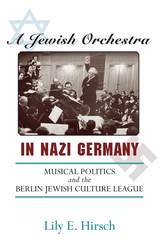 A Jewish Orchestra in Nazi Germany: Musical Politics and the Berlin Jewish Culture League
Lily E. Hirsch
University of Michigan Press, 2011 "Offers a clear introduction to a fascinating, yet little known, phenomenon in Nazi Germany, whose very existence will be a surprise to the general public and to historians. Easily blending general history with musicology, the book provides provocative yet compelling analysis of complex issues."
---Michael Meyer, author of The Politics of Music in the Third Reich "Hirsch poses complex questions about Jewish identity and Jewish music, and she situates these against a political background vexed by the impossibility of truly viable responses to such questions. Her thorough archival research is complemented by her extensive use of interviews, which gives voice to those swept up in the Holocaust. A Jewish Orchestra in Nazi Germany is a book filled with the stories of real lives, a collective biography in modern music history that must no longer remain in silence."
---Philip V. Bohlman, author of Jewish Music and Modernity "An engaging and downright gripping history. The project is original, the research is outstanding, and the presentation lucid."
---Karen Painter, author of Symphonic Aspirations: German Music and Politics, 1900-1945 The Jewish Culture League was created in Berlin in June 1933, the only organization in Nazi Germany in which Jews were not only allowed but encouraged to participate in music, both as performers and as audience members. Lily E. Hirsch's A Jewish Orchestra in Nazi Germany is the first book to seriously investigate and parse the complicated questions the existence of this unique organization raised, such as why the Nazis would promote Jewish music when, in the rest of Germany, it was banned. The government's insistence that the League perform only Jewish music also presented the organization's leaders and membership with perplexing conundrums: what exactly is Jewish music? Who qualifies as a Jewish composer? And, if it is true that the Nazis conceived of the League as a propaganda tool, did Jewish participation in its activities amount to collaboration? Lily E. Hirsch is Assistant Professor of Music at Cleveland State University.
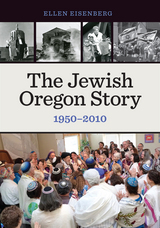 The Jewish Oregon Story, 1950-2010
Ellen Eisenberg
Oregon State University Press, 2016 The Jewish Oregon Story traces the history of diverse Jewish Oregonians and their communities during a period of dramatic change. Drawing on archival sources, including a collection of over 500 oral histories, the book explores how Jewish Oregonians both contributed to and were shaped by the “Oregon Story,” a political shift that fueled Oregon’s—and particularly Portland’s—emerging reputation for progressivism and sustainability.
Six chapters examine a community grappling with, and increasingly embracing, change, from the dramatic national shifts in women’s roles and inter-group relations, to local issues such as the razing of the historic South Portland Jewish neighborhood. An original community musical frames the creation of a new Portland Jewish identity, emerging out of the ashes of South Portland and tapping ethnic expression as an antidote to suburbanization and assimilation. A peek behind the scenes exposes the crucial role of women’s voluntarism, and traces the impact of women entering the workforce and winning acceptance as equals in organizational and ritual life. Chapters on involvement in liberal politics and advocacy for Israel explore communal engagement that reflected national trends, but, beginning in the 1980s, were increasingly shaped by emerging local progressivism. A final chapter charts recent shifts in Oregon Jewish geography, demographics, and organizational life, exploring the rebirth of smaller communities and the embrace of post-denominational Jewry, spirituality, and an ethos of environmentalism and inclusion.
The Jewish Oregon Story will appeal to readers of American Jewish history and Oregon/western history, particularly those interested in questions of ethnicity and identity. Drawing on extensive archival sources and recent scholarship, the book aims to engage both academic audiences and general readers.
Jewish Origins of the Psychoanalytic Movement
Dennis B. Klein
University of Chicago Press, 1985 Dennis B. Klein explores the Jewish consciousness of Freud and his followers and the impact of their Jewish self-conceptions on the early psychoanalytic movement. Using little-known sources such as the diaries and papers of Freud's protégé Otto Rank and records of the Vienna B'nai B'rith that document Freud's active participation in that Jewish fraternal society, Klein argues that the feeling of Jewish ethical responsibility, aimed at renewing ties with Germans and with all humanity, stimulated the work of Freud, Rank, and other analysts and constituted the driving force of the psychoanalytic movement.
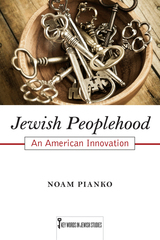 Jewish Peoplehood: An American Innovation
Pianko, Noam
Rutgers University Press, 2015 Winner of the 2017 Saul Viener Book Prize from the American Jewish Historical Society
Although fewer American Jews today describe themselves as religious, they overwhelmingly report a strong sense of belonging to the Jewish people. Indeed, Jewish peoplehood has eclipsed religion—as well as ethnicity and nationality—as the essence of what binds Jews around the globe to one another. In Jewish Peoplehood, Noam Pianko highlights the current significance and future relevance of “peoplehood” by tracing the rise, transformation, and return of this novel term. The book tells the surprising story of peoplehood. Though it evokes a sense of timelessness, the term actually emerged in the United States in the 1930s, where it was introduced by American Jewish leaders, most notably Rabbi Stephen Wise and Rabbi Mordecai Kaplan, with close ties to the Zionist movement. It engendered a sense of unity that transcended religious differences, cultural practices, geographic distance, economic disparity, and political divides, fostering solidarity with other Jews facing common existential threats, including the Holocaust, and establishing a closer connection to the Jewish homeland. But today, Pianko points out, as globalization erodes the dominance of nationalism in shaping collective identity, Jewish peoplehood risks becoming an outdated paradigm. He explains why popular models of peoplehood fail to address emerging conceptions of ethnicity, nationalism, and race, and he concludes with a much-needed roadmap for a radical reconfiguration of Jewish collectivity in an increasingly global era. Innovative and provocative, Jewish Peoplehood provides fascinating insight into a term that assumes an increasingly important position at the heart of American Jewish and Israeli life.
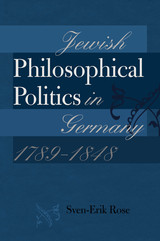 Jewish Philosophical Politics in Germany, 1789–1848
Sven-Erik Rose
Brandeis University Press, 2014 In this book Rose illuminates the extraordinary creativity of Jewish intellectuals as they reevaluated Judaism with the tools of a German philosophical tradition fast emerging as central to modern intellectual life. While previous work emphasizes the “subversive” dimensions of German-Jewish thought or the “inner antisemitism” of the German philosophical tradition, Rose shows convincingly the tremendous resources German philosophy offered contemporary Jews for thinking about the place of Jews in the wider polity. Offering a fundamental reevaluation of seminal figures and key texts, Rose emphasizes the productive encounter between Jewish intellectuals and German philosophy. He brings to light both the complexity and the ambivalence of reflecting on Jewish identity and politics from within a German tradition that invested tremendous faith in the political efficacy of philosophical thought itself.
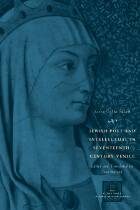 Jewish Poet and Intellectual in Seventeenth-Century Venice: The Works of Sarra Copia Sulam in Verse and Prose Along with Writings of Her Contemporaries in Her Praise, Condemnation, or Defense
Sarra Copia Sulam
University of Chicago Press, 2009 The first Jewish woman to leave her mark as a writer and intellectual, Sarra Copia Sulam (1600?–41) was doubly tainted in the eyes of early modern society by her religion and her gender. This remarkable woman, who until now has been relatively neglected by modern scholarship, was a unique figure in Italian cultural life, opening her home, in the Venetian ghetto, to Jews and Christians alike as a literary salon. For this bilingual edition, Don Harrán has collected all of Sulam’s previously scattered writings—letters, sonnets, a Manifesto—into a single volume. Harrán has also assembled all extant correspondence and poetry that was addressed to Sulam, as well as all known contemporary references to her, making them available to Anglophone readers for the first time. Featuring rich biographical and historical notes that place Sulam in her cultural context, this volume will provide readers with insight into the thought and creativity of a woman who dared to express herself in the male-dominated, overwhelmingly Catholic Venice of her time.
Jewish Poetry and Cultural Coexistence in Late Medieval Spain
Gregory B. Kaplan
Arc Humanities Press, 2019 <div>This book offers a groundbreaking perspective on Judeo-Christian coexistence in medieval Spain, in particular on the Camino de Santiago (Way of St. James), one of the most important pilgrimage routes in Europe. The author uncovers new evidence of Judeo-Christian cooperation in Castilian monasteries on the Camino. It reveals that a collaborative climate endured in these monasteries as demonstrated by the transmission of <I>cuaderna vía</I> poetry from Christians to Jews.</div>
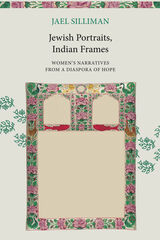 Jewish Portraits, Indian Frames: Women's Narratives from a Diaspora of Hope
Jael Silliman
Seagull Books, 2001 Jewish Portraits, Indian Frames offers a personal and social history of the author's foremothers -- Baghdadi Jews who lived most of their lives in the Jewish community in Calcutta. Jael Silliman begins with a portrait of Farha, her maternal great-greandmother, who dwelled almost entirely within the Baghdadi Jewish community no matter where she and her husband traveled on business (Calcutta, Rangoon, Singapore). Next is her maternal grandmother, Miriam (Mary), who was much more Anglicized than Farha and deeply influenced by British colonial practices. The third portrait, of Silliman's mother, Flower, reveals a woman in a double transition: her own and India's. Flower grew up in colonial India, witnessed India's struggle for independence, and lived her middle years in an independent India. The final sketch is of Silliman herself. Born in Calcutta in 1955 in the waning Jewish community, Silliman grew up in a cosmopolitan and Indian world, rather than a Baghdadi Jewish one. Silliman's own travels have taken her to the US, where, as a teacher and scholar, her primary identification is with the "South Asian intellectual and professional diaspora." These rich family portraits convey a sense of the singular roles women played in building and sustaining a complex diaspora in what Silliman calls "Jewish Asia" over the past 150 years. Her sketches of the everyday lives of her foremothers -- from the food they ate and the clothes they wore to the social and political relationships they forged -- bring to life a community and a culture, even as they disclose the unexpected and subtle complexities of the colonial encounter as experienced by Jewish women.
Jewish Prince in Moslem Spain: Selected Poems of Samuel Ibn Nagrela
Samuel Ibn Nagrela
University of Alabama Press, 2005 Translated by Leon J. Weinberger Of all the Hebrew poets of the 'Golden Age' in Spain, Samuel Ibn Nagrela (993-1056 A.D.) remains perhaps the most fascinating personality. A leading statesman in the kingdom of Granada, he was as successful in court as on the battlefield, maintaining a position of power for several decades while walking a political tightrope. Endowed with great literary talents, he opened up new paths in Hebrew poetry, and his mastery of its metrical intricacies was as consummate as his political and military skill.
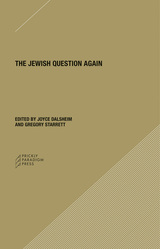 The Jewish Question Again
Edited by Joyce Dalsheim and Gregory Starrett
Prickly Paradigm Press, 2020 Anti-Semitism is on the rise. How is this still possible? Once again, we are witness to a surge in right-wing authoritarianism, ethnonationalism, and white supremacism, and the racist, xenophobic, and misogynist violence they spread. Like historic newsreels brought back to life, renewed waves of refugees are turned away at borders, placed in cages, or washed up lifeless on the shore.
Such striking similarities between present and past suggest that we are not done with the issues raised by the historical Jewish Question: that is, what is the place of “the Jew”—the minority, the relic, the rootless stranger, the racialized other, the exiled, the displaced, the immigrant, the diasporic? In The Jewish Question Again, leading scholars grapple with our inability to keep these struggles in the past and why we continue to repeat these atrocities. This book explores the haunting recurrence of the Jewish Question today and begs why we find ourselves here yet again.
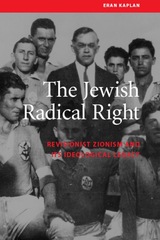 The Jewish Radical Right: Revisionist Zionism and Its Ideological Legacy
Eran Kaplan
University of Wisconsin Press, 2005 The Jewish Radical Right is the first comprehensive analysis of Zionist Revisionist thought in the 1920s and 1930s, and of its ideological legacy in modern-day Israel. The Revisionists, under the leadership of Ze'ev Jabotinsky, offered a radical view of Jewish history and a revolutionary vision for its future. Using new archival material, Eran Kaplan examines the intellectual and cultural origins of the Zionist and Israeli Right, when Revisionism evolved into one of the most important movements in the Zionist camp. He presents revisionism as a form of integral nationalism, rooted in an ontological monism and intellectually related to the radical right-wing ideologies that flourished in the early twentieth century. Kaplan provocatively suggests that revisionism's legacies can be found both in the right-wing policies of Likud and in the heart of Post Zionism and its critique of mainstream (Labor) Zionism.
Published with support from the Koret Jewish Studies Program
Jewish Renaissance and Revival in America
Edited by Eitan P. Fishbane and Jonathan D. Sarna
Brandeis University Press, 2011 In the late 1870s, shaken by rapid socioeconomic change, internal crises, and the rise of antisemitism, young Jews assumed leadership, created dozens of organizations, and inspired masses of followers. These organizations helped define the nineteenth-century Jewish awakening: cultural and religious renewal, and the promotion of Jewish education. Expanding upon the unfinished work of Leah Levitz Fishbane, this volume seeks to broaden our understanding of this period, which paved the way for new developments in American Jewish communal, cultural, and religious life.
 Jewish Renaissance in the Russian Revolution
Kenneth B. Moss
Harvard University Press, 2009 Between 1917 and 1921, as revolution convulsed Russia, Jewish intellectuals and writers across the crumbling empire threw themselves into the pursuit of a “Jewish renaissance.” At the heart of their program lay a radically new vision of Jewish culture predicated not on religion but on art and secular individuality, national in scope yet cosmopolitan in content, framed by a fierce devotion to Hebrew or Yiddish yet obsessed with importing and participating in the shared culture of Europe and the world. These cultural warriors sought to recast themselves and other Jews not only as a modern nation but as a nation of moderns.
Kenneth Moss offers the first comprehensive look at this fascinating moment in Jewish and Russian history. He examines what these numerous would-be cultural revolutionaries, such as El Lissitzky and Haim Nahman Bialik, meant by a new Jewish culture, and details their fierce disagreements but also their shared assumptions about what culture was and why it was so important. In close readings of Hebrew, Yiddish, and Russian texts, he traces how they sought to realize their ideals in practice as writers, artists, and thinkers in the burgeoning cultural centers of Moscow, Kiev, and Odessa. And he reveals what happened to them and their ideals as the Bolsheviks consolidated their hold over cultural life.
Here is a brilliant, revisionist argument about the nature of cultural nationalism, the relationship between nationalism and socialism as ideological systems, and culture itself, the axis around which the encounter between Jews and European modernity has pivoted over the past century.
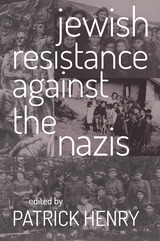 Jewish Resistance Against the Nazis
Patrick Henry
Catholic University of America Press, 2014 This volume puts to rest the myth that the Jews went passively to the slaughter like sheep. Indeed Jews resisted in every Nazi-occupied country - in the forests, the ghettos, and the concentration camps.The essays presented here consider Jewish resistance to be resistance by Jewish persons in specifically Jewish groups, or by Jewish persons working within non-Jewish organizations. Resistance could be armed revolt; flight; the rescue of targeted individuals by concealment in non-Jewish homes, farms, and institutions; or by the smuggling of Jews into countries where Jews were not objects of Nazi persecution. Other forms of resistance include every act that Jewish people carried out to fight against the dehumanizing agenda of the Nazis - acts such as smuggling food, clothing, and medicine into the ghettos, putting on plays, reading poetry, organizing orchestras and art exhibits, forming schools, leaving diaries, and praying. These attempts to remain physically, intellectually, culturally, morally, and theologically alive constituted resistance to Nazi oppression, which was designed to demolish individuals, destroy their soul, and obliterate their desire to live.
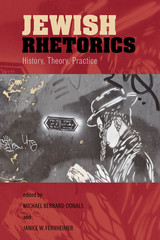 Jewish Rhetorics: History, Theory, Practice
Edited by Michael Bernard-Donals and Janice W. Fernheimer
Brandeis University Press, 2014 This volume, the first of its kind, establishes and clarifies the significance of Jewish rhetorics as its own field and as a field within rhetoric studies. Diverse essays illuminate and complicate the editors’ definition of a Jewish rhetorical stance as allowing speakers to maintain a “resolute sense of engagement” with their fellows and their community, while also remaining aware of the dislocation from the members of those communities. Topics include the historical and theoretical foundations of Jewish rhetorics; cultural variants and modes of cultural expression; and intersections with Greco-Roman, Christian, Islamic, and contemporary rhetorical theory and practice. In addition, the contributors examine gender and Yiddish, and evaluate the actual and potential effect of Jewish rhetorics on contemporary scholarship and on the ways we understand and teach language and writing. The contributors include some of the world’s leading scholars of rhetoric, writing, and Jewish studies.
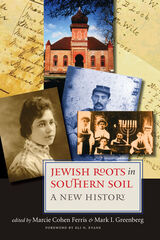 Jewish Roots in Southern Soil: A New History
Edited by Marcie Ferris and Mark I. Greenberg
Brandeis University Press, 2006 Jews have long been a presence in the American South, first arriving in the late seventeenth century as part of exploratory voyages from Europe to the New World. Two of the nation’s earliest Jewish communities were founded in Savannah in 1733 and Charleston in 1749. By 1800, more Jews lived in Charleston than in New York City. Today, Jews comprise less than one half of one percent of the southern population but provide critical sustenance and support for their communities. Nonetheless, southern Jews have perplexed scholars. For more than a century, historians have wrestled with various questions. Why study southern Jewish history? What is the southern Jewish experience? Is southern Jewish culture distinctive from that of other regions of the country, and if so, why? Jewish Roots in Southern Soil: A New History addresses these questions through the voices of a new generation of scholars of the Jewish South. Each of this book’s thirteen chapters reflects a response with particular attention paid to new studies on women and gender; black/Jewish relations and the role of race, politics, and economic life; popular and material culture; and the changes wrought by industrialization and urbanization in the twentieth century. Essays address historical issues from the colonial era to the present and in every region of the South. Topics include assimilation and American Jewish identity, southern Jewish women writers, the Jewish Confederacy, Jewish peddlers, southern Jewish racial identity, black/Jewish relations, demographic change, the rise of American Reform Judaism, and Jews in southern literature.
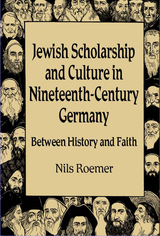 Jewish Scholarship and Culture in Nineteenth-Century Germany: Between History and Faith
Nils Roemer
University of Wisconsin Press, 2005 German Jews were fully assimilated and secularized in the nineteenth century—or so it is commonly assumed. In Jewish Scholarship and Culture in the Nineteenth Century, Nils Roemer challenges this assumption, finding that religious sentiments, concepts, and rhetoric found expression through a newly emerging theological historicism at the center of modern German Jewish culture.
Modern German Jewish identity developed during the struggle for emancipation, debates about religious and cultural renewal, and battles against anti-Semitism. A key component of this identity was historical memory, which Jewish scholars had begun to infuse with theological perspectives beginning in the 1850s. After German reunification in the early 1870s, Jewish intellectuals reevaluated their enthusiastic embrace of liberalism and secularism. Without abandoning the ideal of tolerance, they asserted a right to cultural religious difference for themselves--an ideal they held to even more tightly in the face of growing anti-Semitism. This newly re-theologized Jewish history, Roemer argues, helped German Jews fend off anti-Semitic attacks by strengthening their own sense of their culture and tradition.
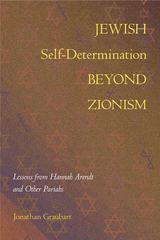 Jewish Self-Determination beyond Zionism: Lessons from Hannah Arendt and Other Pariahs
Jonathan Graubart
Temple University Press, 2023 Jewish Self-Determination beyond Zionism examines the liberal Zionist and Jewish anti-Zionist perspectives that developed in the decades following Israeli statehood. In his timely book, Jonathan Graubart. advances a non-statist vision of Jewish self-determination to be realized in a binational political arrangement that rejects Apartheid practices and features a just and collaborative coexistence of Israeli Jews and Palestinian Arabs. The book’s vision advances a distinct Jewish self-determination committed to cultural enrichment and emancipation, internationalism, and the fostering of new political, social, and economic channels for attaining genuine reconciliation between Israelis and Palestinians.
Jewish Self-Determination beyond Zionism also engages a Humanist Zionist vision to confront the Zionist movement’s foundational sins and demands a full reckoning with the Palestinians. Graubart focuses on two of Humanist Zionism’s most insightful thinkers, Martin Buber and Hannah Arendt, putting them “in conversation” with each other, and synthesizing their collective insights and critical Jewish perspectives alongside the ideas of Noam Chomsky, Judith Butler, Ella Shohat, Edward Said, and other philosophers and academics. Jewish Self-Determination beyond Zionism concludes that an updated, binational program is the best path forward.
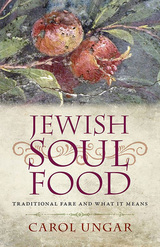 Jewish Soul Food: Traditional Fare and What It Means
Carol Ungar
Brandeis University Press, 2015 Jewish traditional foods often have symbolic meanings. A Passover matzo is a taste of Egyptian slavery. The Hanukkah latke reminds us of the little jug of oil that burned, miraculously, for eight nights. Noshing hamentaschen at Purim, we remember the villain Haman, and his thwarted plan to destroy the Jews. Even more than in the synagogue, Jewish life takes place around the dining table. Jewish sages compare the dining table to an altar, and that isn’t an exaggeration. Jewish meals are ceremonies and celebrations that forge a pathway between body and soul. In this unique cookbook, Carol Ungar links the cultural and religious symbolism of Jewish foods to more than one hundred recipes drawn from international Jewish cultures and traditions. She offers easy-to-follow recipes for Shabbat meals and all the Jewish holidays, from Rosh Hashana to the nine days before Tisha b’Av, along with fascinating briefs on how many Jewish foods—challah, kreplach, farfel, and more—express core Jewish beliefs. With ingredients that can be found in any supermarket, and recipes adapted for the time- and health-conscious cook, this volume is for anyone who wishes to flavor Shabbat and holiday meals with Jewish soul.
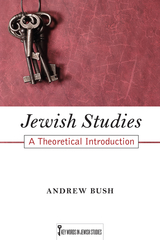 Jewish Studies: A Theoretical Introduction
Bush, Andrew
Rutgers University Press, 2011 Jewish Studies, the first volume in a groundbreaking new series, Key Words in Jewish Studies, introduces the basic approach of the series by organizing discussion around key concepts in the field that have emerged over the last two centuries: history and science, race and religion, self and community, identity and memory. The book is oriented by contemporary critical theory, especially feminist and postcolonial studies, and the multidisciplinary approaches of cultural studies. By looking backward and forward—and across continents and disciplines—to unearth the evolution of the scholarly study of Jews, Andrew Bush provides a comprehensive introduction to the development of Jewish studies from the turn of the nineteenth century to the present. In the course of engaging scholarship on periods from the classical to the contemporary and from the disciplines of history, philosophy, sociology, anthropology, psychology, and literary studies, Bush questions male-dominated and Ashkenazi-centric visions of the field. He concludes with an experimental exposition of a new Jewish studies for a time where attention to difference has overtaken the security of canons and commonalities.
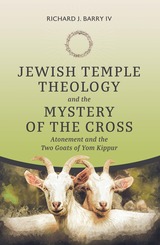 Jewish Temple Theology and the Mystery of the Cross: Atonement and the Two Goats of Yom Kippur
Richard J. Barry IV
Catholic University of America Press, 2023 On the Day of Atonement, two goats were brought before the high priest at the temple. One was chosen as the goat for the Lord, a spotless sacrifice, and the other was set aside for Azazel, doomed to bear sins into the wilderness. Jewish Temple Theology and the Mystery of the Cross shows how a theological appreciation for the two movements of Yom Kippur makes it possible to identify the paradox at the heart of Christian soteriology: in his single atoning act, Jesus Christ fulfills the work of both goats, without confusion, without division. Appreciation for this paradox helps illuminate many of the doctrinal debates in the history of Christian soteriology and offers a compelling way forward.
Jewish Temple Theology and the Mystery of the Cross begins with a survey of biblical geography: first, a rich theological pilgrimage to Mount Zion, the home of beauty, goodness, and truth, and then to the surrounding desert, the wilderness of sin and sorrow. To appreciate the Yom Kippur liturgy, and to understand the priestly word “atonement,” one must be oriented by this cosmic stage. Drawing on the best modern historical-critical scholarship, this volume reveals the wonders hidden in Leviticus and shows how a sophisticated theological interpretation of this book leads to breakthroughs in our understanding of Christ’s saving work.
Seeing the mystery of the cross from the perspective of the ancient Jewish scriptures has surprising results. For example, Richard Barry shows how Hans Urs von Balthasar’s controversial theology of Holy Saturday is a compelling development of Azazel-goat soteriology; it is not only biblically licit but is in some ways mandated by the logic of Yom Kippur. At the same time, David Bentley Hart is celebrated for the way he powerfully advances modern YHWH-goat soteriology, yet obedience to the logic of Yom Kippur also necessitates a nuanced biblical critique of his muscular universalism.
How can Christ fulfill the seemingly contradictory movements of both goats in a single saving work? Grappling with that question, Jewish Temple Theology and the Mystery of the Cross seeks to draw nearer to the heart of the mystery of salvation.
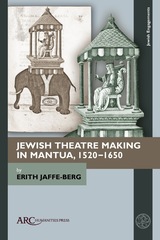 Jewish Theatre Making in Mantua, 1520–1650
Erith Jaffe-Berg
Arc Humanities Press, 2022 This book studies how the Jewish community of Mantua established, normalized, and maintained interrelations with the Christian community for over 130 years, from 1520 to 1650, by means of theatre performance for the Gonzaga Dukes. Performance is shown to have been a mutually beneficial "currency" that both the Dukes and Jews could use to calibrate their relations with one another. Seen in this light, the author demonstrates that performance was not the consequence of cultural exchange between Jews and Christians, but was one of the means by which the complicated nature of cultural communication and exchange took place.
Jewish Theatre Making in Mantua details the performances created by the Jewish community of Mantua and argues that these theatrical events were a crucial component in the ability of Jews to live peacefully within Mantua, which became one of the few refuges left to Jews in the Italian peninsula and Catholic Europe.
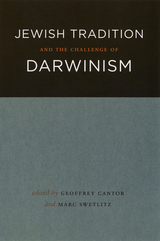 Jewish Tradition and the Challenge of Darwinism
Edited by Geoffrey Cantor and Marc Swetlitz
University of Chicago Press, 2006 Darwin’s theory of evolution transformed the life sciences and made profound claims about human origins and the human condition, topics often viewed as the prerogative of religion. As a result, evolution has provoked a wide variety of religious responses, ranging from angry rejection to enthusiastic acceptance. While Christian responses to evolution have been studied extensively, little scholarly attention has been paid to Jewish reactions. Jewish Tradition and the Challenge of Darwinism is the first extended meditation on the Jewish engagement with this crucial and controversial theory.
The contributors to Jewish Tradition and the Challenge of Darwinism—from several academic disciplines and two branches of the rabbinate—present case studies showing how Jewish discussions of evolution have been shaped by the intersections of faith, science, philosophy, and ideology in specific historical contexts. Furthermore, they examine how evolutionary theory has been deployed when characterizing Jews as a race, both by Zionists and by anti-Semites. Jewish Tradition and the Challenge of Darwinism addresses historical and contemporary, as well as progressive and Orthodox, responses to evolution in America, Europe, and Israel, ultimately extending the history of Darwinism into new religious domains.
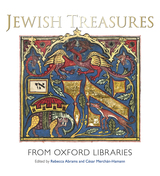 Jewish Treasures from Oxford Libraries
Edited by Rebecca Abrams & César Merchán-Hamann
Bodleian Library Publishing, 2020 Representing four centuries of collecting and a thousand years of Jewish history, this book brings together Hebrew manuscripts and rare books from the Bodleian Library and Oxford colleges. Highlights of the extraordinary collections include a fragment of Maimonides’ autograph draft of the Mishneh Torah, the earliest dated fragment of the Talmud, exquisitely illuminated manuscripts of the Hebrew Bible, stunning festival prayer books, and one of the oldest surviving Jewish seals in England. Lavishly illustrated essays by experts in the field bring these outstanding works to life, exploring the personalities and diverse motivations of their original collectors.
Saved for posterity by religious scholarship, intellectual rivalry, and political ambition, these extraordinary collections also detail the consumption and circulation of knowledge across the centuries, forming a social and cultural history of objects moved across borders from person to person. Together, they offer a fascinating journey through Jewish intellectual and social history.
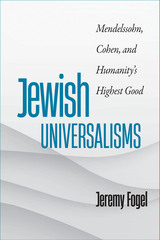 Jewish Universalisms: Mendelssohn, Cohen, and Humanity’s Highest Good
Jeremy Fogel
Brandeis University Press, 2023 An original and comprehensive comparison of the universalisms of two major modern Jewish philosophers.
Any version of universalism relevant to a more attentive, pluralistic, and postcolonial outlook would balance the urgent current need for a universalistic perspective with the desire to maintain the richness of human diversity. The modern Jewish philosophers who sought to partake in the Enlightenment’s universalistic vision while maintaining their distinct identities as members of a religious minority within Europe offer insightful answers.
Jewish Universalisms analyzes how two major figures, Moses Mendelssohn and Hermann Cohen, dealt with the perceived tension between the universal values characteristic of the Enlightenment and aspects of Judaism often depicted as particularistic and parochial. Jeremy Fogel joins this lively debate in modern Jewish philosophy, offering a comparative examination of these thinkers and analyzing their worldviews from an innovative axiological perspective. Fogel writes that to gain a precise understanding of how Mendelssohn and Cohen argued for the concordance of Judaism and universalism, one must first seek out what they delineated as ultimately valuable. Then one can work out how that highest good, and the method of valuation it sustains, are universal.
The Jewish War and The Victory
Henryk Grynberg
Northwestern University Press, 2001 This epic tells the story of a Polish Jewish family struggling against nearly insurmountable odds. In The Jewish War, the family of a young Jewish boy hides throughout the countryside until the father is murdered. To escape, the mother and boy use forged papers and adopt a false life as the Catholic family of an officer captured by the Germans. The Victory picks up the story as the Red Army advances and the boy fights to reclaim his Jewishness amidst the horrors of the past and the choices of an agonizing present.
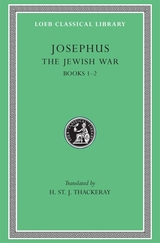 The Jewish War, Volume I: Books 1–2
Josephus
Harvard University Press Greco-Roman antiquity’s premier Jewish historian.
Josephus, soldier, statesman, historian, was a Jew born at Jerusalem about AD 37. A man of high descent, he early became learned in Jewish law and Greek literature and was a Pharisee. After pleading in Rome the cause of some Jewish priests he returned to Jerusalem and in 66 tried to prevent revolt against Rome, managing for the Jews the affairs of Galilee. In the troubles that followed he made his peace with Vespasian. Present at the siege of Jerusalem by Titus, he received favors from these two as emperors and from Domitian, and assumed their family name Flavius. He died after 97.
As a historical source Josephus is invaluable. His major works are: History of the Jewish War, in seven books, from 170 BC to his own time, first written in Aramaic but translated by himself into the Greek we now have; and Jewish Antiquities, in twenty books, from the creation of the world to AD 66. The Loeb Classical Library edition of the works of Josephus, which is in thirteen volumes, also includes the autobiographical Life and his treatise Against Apion.
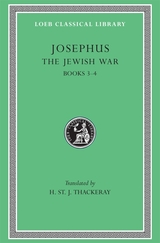 The Jewish War, Volume II: Books 3–4
Josephus
Harvard University Press Greco-Roman antiquity’s premier Jewish historian.
Josephus, soldier, statesman, historian, was a Jew born at Jerusalem about AD 37. A man of high descent, he early became learned in Jewish law and Greek literature and was a Pharisee. After pleading in Rome the cause of some Jewish priests he returned to Jerusalem and in 66 tried to prevent revolt against Rome, managing for the Jews the affairs of Galilee. In the troubles that followed he made his peace with Vespasian. Present at the siege of Jerusalem by Titus, he received favors from these two as emperors and from Domitian, and assumed their family name Flavius. He died after 97.
As a historical source Josephus is invaluable. His major works are: History of the Jewish War, in seven books, from 170 BC to his own time, first written in Aramaic but translated by himself into the Greek we now have; and Jewish Antiquities, in twenty books, from the creation of the world to AD 66. The Loeb Classical Library edition of the works of Josephus, which is in thirteen volumes, also includes the autobiographical Life and his treatise Against Apion.
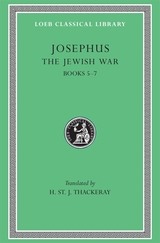 The Jewish War, Volume III: Books 5–7
Josephus
Harvard University Press Greco-Roman antiquity’s premier Jewish historian.
Josephus, soldier, statesman, historian, was a Jew born at Jerusalem about AD 37. A man of high descent, he early became learned in Jewish law and Greek literature and was a Pharisee. After pleading in Rome the cause of some Jewish priests he returned to Jerusalem and in 66 tried to prevent revolt against Rome, managing for the Jews the affairs of Galilee. In the troubles that followed he made his peace with Vespasian. Present at the siege of Jerusalem by Titus, he received favors from these two as emperors and from Domitian, and assumed their family name Flavius. He died after 97.
As a historical source Josephus is invaluable. His major works are: History of the Jewish War, in seven books, from 170 BC to his own time, first written in Aramaic but translated by himself into the Greek we now have; and Jewish Antiquities, in twenty books, from the creation of the world to AD 66. The Loeb Classical Library edition of the works of Josephus, which is in thirteen volumes, also includes the autobiographical Life and his treatise Against Apion.
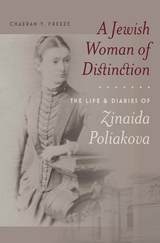 A Jewish Woman of Distinction: The Life and Diaries of Zinaida Poliakova
ChaeRan Y. Freeze
Brandeis University Press, 2019 Zinaida Poliakova (1863–1953) was the eldest daughter of Lazar Solomonovich Poliakov, one of the three brothers known as the Russian Rothschilds. They were moguls who dominated Russian finance and business and built almost a quarter of the railroad lines in Imperial Russia.
For more than seventy-five years, Poliakova kept detailed diaries of her world, giving us a rare look into the exclusive world of Jewish elites in Moscow and St. Petersburg. These rare documents reveal how Jews successfully integrated into Russian aristocratic society through their intimate friendships and patronage of the arts and philanthropy. And they did it all without converting—in fact, while staunchly demonstrating their Jewishness.
Poliakova’s life was marked by her dual identity as a Russian and a Jew. She cultivated aristocratic sensibilities and lived an extraordinarily lifestyle, and yet she was limited by the confessional laws of the empire and religious laws that governed her household. She brought her Russian tastes, habits, and sociability to France following her marriage to Reuben Gubbay (the grandson of Sir Albert Abdullah Sassoon). And she had to face the loss of almost all her family members and friends during the Holocaust.
Women’s voices are often lost in the sweep of history, and so A Jewish Women of Distinction is an exceptional, much-needed collection. These newly discovered primary sources will change the way we understand the full breadth of the Russian Jewish experience.
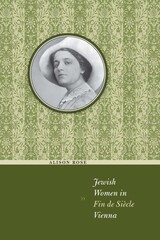 Jewish Women in Fin de Siècle Vienna
By Alison Rose
University of Texas Press, 2008 Despite much study of Viennese culture and Judaism between 1890 and 1914, little research has been done to examine the role of Jewish women in this milieu. Rescuing a lost legacy, Jewish Women in Fin de Siècle Vienna explores the myriad ways in which Jewish women contributed to the development of Viennese culture and participated widely in politics and cultural spheres. Areas of exploration include the education and family lives of Viennese Jewish girls and varying degrees of involvement of Jewish women in philanthropy and prayer, university life, Zionism, psychoanalysis and medicine, literature, and culture. Incorporating general studies of Austrian women during this period, Alison Rose also presents significant findings regarding stereotypes of Jewish gender and sexuality and the politics of anti-Semitism, as well as the impact of German culture, feminist dialogues, and bourgeois self-images. As members of two minority groups, Viennese Jewish women nonetheless used their involvement in various movements to come to terms with their dual identity during this period of profound social turmoil. Breaking new ground in the study of perceptions and realities within a pivotal segment of the Viennese population, Jewish Women in Fin de Siècle Vienna applies the lens of gender in important new ways.
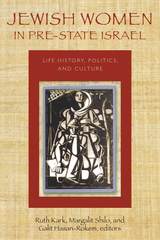 Jewish Women in Pre-State Israel: Life History, Politics, and Culture
Edited by Ruth Kark, Margalit Shilo, and Galit Hasan-Rokem
Brandeis University Press, 2009 This fascinating interdisciplinary collection of essays brings gender issues to the foreground in order to redress a profound imbalance in the historiography of the Yishuv, the Jewish community in Palestine, and in the early years of the State of Israel. Although male discourse still dominates this field, some initial studies have begun to create an authentic and multifaceted Hebrew-Israeli voice by examining the activities and contributions of women. This research has led to a number of basic questions: What was the reality of life for women in Jewish society in Ottoman and Mandatory Palestine (Eretz Israel), and in the early years of the State? What was the contribution of women to the renewal of Israeli society and culture? What is the place of gender perceptions in the study of the new local identity? The original articles in this anthology forge an innovative response to one or more of these questions, and reflecting the state of research in the field.
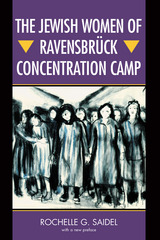 The Jewish Women of Ravensbrück Concentration Camp
Rochelle G. Saidel
University of Wisconsin Press, 2006 Ravensbrück was the only major Nazi concentration camp for women. Located about fifty miles north of Berlin, the camp was the site of murder by slave labor, torture, starvation, shooting, lethal injection, "medical" experimentation, and gassing.
While this camp was designed to hold 5,000 women, the actual figure was six times this number. Between 1939 and 1945, 132,000 women from twenty-three countries were imprisoned in Ravensbrück, including political prisoners, Jehovah's Witnesses, "asocials" (including Gypsies, prostitutes, and lesbians), criminals, and Jewish women (who made up about 20 percent of the population). Only 15,000 survived.
Drawing upon more than sixty narratives and interviews of survivors in the United States, Israel, and Europe as well as unpublished testimonies, documents, and photographs from private archives, Rochelle Saidel provides a vivid collective and individual portrait of Ravensbrück’s Jewish women prisoners. She worked for over twenty years to track down these women whose poignant testimonies deserve to be shared with a wider audience and future generations. Their memoirs provide new perspectives and information about satellite camps (there were about 70 slave labor sub-camps). Here is the story of real daily camp life with the women’s thoughts about food, friendships, fear of rape and sexual abuse, hygiene issues, punishment, work, and resistance. Saidel includes accounts of the women's treatment, their daily struggles to survive, their hopes and fears, their friendships, their survival strategies, and the aftermath.
On April 30, 1945, the Soviet Army liberated Ravensbrück. They found only 3,000 extremely ill women in the camp, because the Nazis had sent other remaining women on a death march. The Jewish Women of Ravensbrück Concentration Camp reclaims the lost voices of the victims and restores the personal accounts of the survivors.
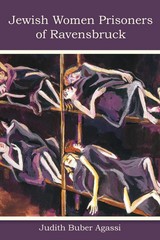 The Jewish Women Prisoners of Ravensbrück: Who Were They?
Judith Buber Agassi
Texas Tech University Press, 2014 Voice to the silent
Ravensbrück was the only major Nazi concentration camp for women. Between 1939 and 1945, it was the site of murder by slave labor, torture, starvation, shooting, lethal injection, medical experimentation, and gassing. In its six-year history, 132,000 women from twenty-seven countries were imprisoned in Ravensbrück. Only about 15,000 in all survived.
Jewish Women Prisoners of Ravensbrück reclaims the lost identities of these victims. Together with a team of researchers, Judith Buber Agassi interviewed 138 survivors of Ravensbrück on four continents. Using the survivor testimonies to corroborate her research from major archives in Germany, Israel, and the United States, as well as from transport and death registration lists and from records that were smuggled out of the camp before liberation, Buber Agassi constructs an image of the women of Ravensbrück: their countries of origin, age distribution, professional roles prior to the war, religious backgrounds, and the types of social interactions and emotional support that existed among and between the various groups of women. To date, Buber Agassi has recovered the identity of over 16,000 Ravensbrück prisoners.
Now in paperback, this study of Ravenbrück, largely overlooked in favor of more notorious killing campus, continues the female approach to understanding the Holocaust.
Jewish Writing and the Deep Places of the Imagination
Mark Krupnick
University of Wisconsin Press, 2005 When he learned he had ALS and roughly two years to live, literary critic Mark Krupnick returned to the writers who had been his lifelong conversation partners and asked with renewed intensity: how do you live as a Jew, when, mostly, you live in your head? The evocative and sinuous essays collected here are the products of this inquiry. In his search for durable principles, Krupnick follows Lionel Trilling, Cynthia Ozick, Geoffrey Hartman, Philip Roth, Saul Bellow, and others into the elemental matters of life and death, sex and gender, power and vulnerability. The editors—Krupnick’s wife, Jean K. Carney, and literary critic Mark Shechner—have also included earlier essays and introductions that link Krupnick’s work with the “deep places” of his own imagination.
Jewish-American Artists and the Holocaust
Baigell, Matthew
Rutgers University Press, 1997 Jewish themes in American art were not very visible until the last two decades, although many famous twentieth-century artists and critics were and are Jewish. Few artists responded openly to the Holocaust until the 1960s, when it finally began to act as a galvanizing force, allowing Jewish-American artists to express their Jewish identity in their work. Baigell describes how artists initially deflected their responses into abstract forms or by invoking biblical and traditional figures and then in more recent decades confronted directly Holocaust imagery and memory. He traces the development of artistic work from the late 1930s to the present in a moving study of a long overlooked topic in the history of American art.
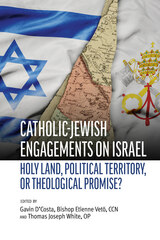 Jewish-Catholic Engagements on Israel: Holy Land, Political Territory, or Theological Promise?
Gavin D'Costa
Catholic University of America Press, 2025 This is the first volume of its kind, bringing together a group of international Jewish and Catholic scholars in creative conversation addressing the question of the status of the land called Israel. Is Israel best viewed as political territory, the ‘Holy Land’, or part of the biblical promise? If committing to one of these options, what are the theological and political consequences?
The book is divided into sections that take the reader through several related questions that bear upon this topic. There is a preface with an overview of how far Catholic Jewish conversations have gone since Nostra Aetate, and how these conversations have now begun to address the land. Then there is an attempt to advance positive theological cases by Catholics and Jews affirming the people in the land as theologically significant, not without difficulties regarding the state itself. The next section deals with the bible/Tanakh as the basis of such claims and addresses the different reading strategies by each community. One of the central questions is then addressed: what of the Palestinian people, do the biblical promise to the Jewish people spell disaster for the Palestinians? Can revelation mean dispossession? The following essays address a stumbling block for both groups: do Jewish and Christian theologies underwrite a nation state? Isn’t this option perilously close to God underwriting nationalism? The book ends with subtle critiques of the entire venture undertaken in this volume.
Essential reading for Catholic Jewish relations and one that addresses one of the most pressing contemporary questions for both religions.
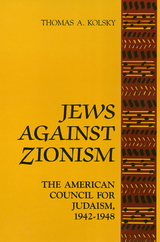 Jews Against Zionism: The American Council for Judaism, 1942-1948
Thomas A. Kolsky
Temple University Press, 1992 This is the first full-scale history of the only organized American Jewish opposition to Zionism during the 1940s. Despite extensive literature on the Zionist movement, the Jewish opposition to Zionism has received only marginal and usually negative attention. In this impartial study, Thomas A. Kolsky examines the neglected phenomenon of Jewish anti-Zionism, its roots, and its results. In 1942, a number of dissident Reform rabbis founded the American Council for Judaism, the first and only Jewish organization created to fight against Zionism and the establishment of a Jewish state. Emphasizing the purely religious nature of Judaism and unequivocally rejecting Jewish nationalism, the Council supported free Jewish immigration and equal rights for Jews throughout the world. For Palestine, specifically, it advocated establishment of a democratic state wherein all citizens, regardless of their religion, would enjoy equal political rights. Summarizing both the history of Zionism and the history of American Jews, Kolsky traces the effects of the Holocaust on the Zionist movement and the personalities that shaped the leadership of the Council. Its position toward Zionism has particular contemporary relevance in understanding the historical relationship between Israel and the Palestinians.
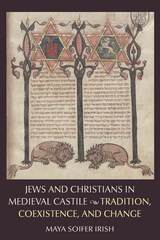 Jews and Christians in Medieval Castile
Maya Soifer Irish
Catholic University of America Press, 2016 Jews and Christians in Medieval Castile examines the changes in Jewish-Christian relations in the Iberian kingdom of Castile during the pivotal period of the reconquest and the hundred years that followed the end of its most active phase (eleventh to mid-fourteenth century). The study's focus on the Christian heartland north of the Duero River, known as Old Castile, allows for a detailed investigation of the Jews' changing relations with the area's main power players - the monarchy, the church, and the towns. In a departure from previous assessments, Soifer Irish shows that the institutional and legal norms of toleration for the Jewish minority were forged not along the military frontier with Islam, but in the north of Castile. She argues that the Jews' relationship with the Castilian monarchy was by far the most significant factor that influenced their situation in the kingdom, but also demonstrates that this relationship was inherently problematic. Although during the early centuries of Christian expansion the Jewish communities benefited from a strong royal power, after about 1250 helping maintain it proved to be costly to the Jewish communities in economic and human terms. Soifer Irish demonstrates that while some Castilian clergymen were vehemently anti-Jewish, the Castilian Church as a whole never developed a coordinated strategy on the Jews, or even showed much interest in the issue. The opposite is true about the townsmen, whose relations with their Jewish neighbors vacillated between cooperation and conflict. In the late thirteenth century, the Crown's heavy-handed tactics in enforcing the collection of outstanding debts to Jewish moneylenders led to the breakdown in the negotiations between the Jewish and Christian communities, creating a fertile ground for the formation of an anti-Jewish discourse in Castilian towns. Soifer Irish also examines the Jews' attitudes toward the various powers in the Christian society and shows that they were active players in the kingdom's politics. Jews and Christians in Medieval Castile breaks new ground in helping us understand more fully the tensions, and commonalities, between groups of different faiths in the late medieval period.
 Jews and Diaspora Nationalism: Writings on Jewish Peoplehood in Europe and the United States
Edited by Simon Rabinovitch
Brandeis University Press, 2012 The question of how to preserve, construct or transform Jewish peoplehood consumed Jewish intellectuals in the late nineteenth and early twentieth centuries. Despite a rich array of writing from Jewish nationalists, liberals, and socialists about the vitality of Jewish existence in the diaspora, the key works have never been collected in a single volume, and few reliable English translations exist. This anthology brings together a variety of thinkers who offered competing visions of peoplehood within the established and developing Jewish diaspora centers of Europe and America. Writing in Russian, Yiddish, Hebrew, French, and English, these Jewish intellectuals sought to recast Jewish existence, whether within multiethnic empires, liberal democracies, or socialist forms of government, in national terms. Volume editor Simon Rabinovitch provides an introductory essay, as well as short introductions and annotations to each document that contextualize and make accessible this wealth of primary sources for scholars and students.
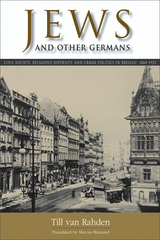 Jews and Other Germans: Civil Society, Religious Diversity, and Urban Politics in Breslau, 1860–1925
Till van Rahden
University of Wisconsin Press, 2008 Jews and Other Germans is the first social and cultural history to probe the parameters of Jewish integration in the half century between the founding of the German Empire in 1871 and the early Weimar Republic. Questioning received wisdom about German-Jewish assimilation and the pervasiveness of anti-Semitism in Imperial Germany, van Rahden’s prize-winning book restores some of the complexity and openness of relations between Protestants, Catholics, and Jews before World War I.
Closely analyzing the political, social, and cultural life in a major German city, van Rahden shows that Jews were a part of a broad urban community that encompassed diversity within unity, at once offering them a large measure of equality while permitting them to remain meaningfully Jewish. Jews and Other Germans also substantially revises the chronology of anti-Semitism in Germany, showing that Jews only began to experience exclusion from Breslau’s social world during World War I.
Yet van Rahden not only illuminates Breslau’s multicultural fabric; he also tells the story of this remarkable city as one of cultural and religious conflict and coexistence. Recounting the experiences of Jews, Protestants, and Catholics within a single narrative, he offers a critical intervention into scholarship on liberalism and civil society in nineteenth- and early twentieth-century Europe.
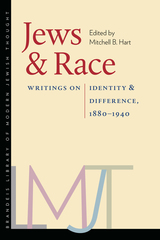 Jews and Race: Writings on Identity and Difference, 1880–1940
Edited by Mitchell B. Hart
Brandeis University Press, 2011 Many people think of Jews as victims of a particular sort of racism, not as active participants in the development of racial thinking in the nineteenth and twentieth centuries. Yet many Jews did take up racial discourse and used it to analyze Judaism, Jewish history, and the contemporary condition of world Jewry. Race discourse generated by Jews was in part apologetic, a response to racial antisemitism; however, it also served other political and ideological needs. Focusing primarily on works written at the height of the racial hygiene and eugenics movements in Europe and North America, this diverse anthology shows how Jewish scholars and popular writers in Europe, North America, and Palestine developed racial interpretations of Judaism and Jewish history, thereby raising fascinating and thorny issues about the nature and history of racial discourse in Europe and America. Designed for class adoption, the volume contains annotations and an introduction by the editor.
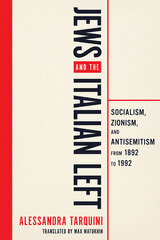 Jews and the Italian Left: Socialism, Zionism, and Antisemitism from 1892 to 1992.
Alessandra Tarquini, Translated by Max Matukhin
University of Wisconsin Press, 2026 Alessandra Tarquini, an expert on Italian Fascism, untangles the complicated relationship between the Italian left and Jews since the late nineteenth century. Due largely to indifference, and sometimes to antisemitism, Italian leftists consistently overlooked Jews in their visions for a collectivist future. Yet, from the birth of the Socialist Party in 1892 until 1992, when the heirs of the Marxist tradition dispersed or set out on a new path, questions continually arose in revolutionary efforts to remake the Italian state: Should Jews be seen as oppressed, and therefore welcome to participate in the struggle that would lead to the advent of a new civilization? Or might they hinder the realization of socialism because of their attachment to a religious identity?
Tarquini’s research fills an important lacuna by analyzing the antisemitism of twentieth-century socialist movements. Crucially, however, Tarquini makes important distinctions between antisemitism on the Italian left and right, and identifies the relationship between leftism and antisemitism as a distinct formation.
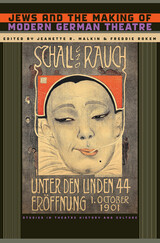 Jews and the Making of Modern German Theatre
Jeanette R. Malkin
University of Iowa Press, 2010 While it is common knowledge that Jews were prominent in literature, music, cinema, and science in pre-1933 Germany, the fascinating story of Jewish co-creation of modern German theatre is less often discussed. Yet for a brief time, during the Second Reich and the Weimar Republic, Jewish artists and intellectuals moved away from a segregated Jewish theatre to work within canonic German theatre and performance venues, claiming the right to be part of the very fabric of German culture. Their involvement, especially in the theatre capital of Berlin, was of a major magnitude both numerically and in terms of power and influence. The essays in this stimulating collection etch onto the conventional view of modern German theatre the history and conflicts of its Jewish participants in the last third of the nineteenth and first third of the twentieth centuries and illuminate the influence of Jewish ethnicity in the creation of the modernist German theatre. The nontraditional forms and themes known as modernism date roughly from German unification in 1871 to the end of the Weimar Republic in 1933. This is also the period when Jews acquired full legal and trade equality, which enabled their ownership and directorship of theatre and performance venues. The extraordinary artistic innovations that Germans and Jews co-created during the relatively short period of this era of creativity reached across the old assumptions, traditions, and prejudices that had separated people as the modern arts sought to reformulate human relations from the foundations to the pinnacles of society. The essayists, writing from a variety of perspectives, carve out historical overviews of the role of theatre in the constitution of Jewish identity in Germany, the position of Jewish theatre artists in the cultural vortex of imperial Berlin, the role played by theatre in German Jewish cultural education, and the impact of Yiddish theatre on German and Austrian Jews and on German theatre. They view German Jewish theatre activity through Jewish philosophical and critical perspectives and examine two important genres within which Jewish artists were particularly prominent: the Cabaret and Expressionist theatre. Finally, they provide close-ups of the Jewish artists Alexander Granach, Shimon Finkel, Max Reinhardt, and Leopold Jessner. By probing the interplay between “Jewish” and “German” cultural and cognitive identities based in the field of theatre and performance and querying the effect of theatre on Jewish self-understanding, they add to the richness of intercultural understanding as well as to the complex history of theatre and performance in Germany.
 Jews and the New American Scene
Seymour M. Lipset and Earl Raab
Harvard University Press, 1995 Will American Jews survive their success? Or will the United States' uniquely hospitable environment lead inexorably to their assimilation and loss of cultural identity? This is the conundrum that Seymour Lipset and Earl Raab explore in their wise and learned book about the American Jewish experience.
Jews, perhaps more than any ethnic or religious minority that has immigrated to these shores, have benefited from the country's openness, egalitarianism, and social heterogeneity. This unusually good fit, the authors argue, has as much to do with the exceptionalism of the Jewish people as with that of America. But acceptance for all ancestral groups has its downside: integration into the mainstream erodes their defining features, diluting the loyalties that sustain their members.
The authors vividly illustrate this paradox as it is experienced by American Jews today--in their high rates of intermarriage, their waning observance of religious rites, their extraordinary academic and professional success, their commitment to liberalism in domestic politics, and their steadfast defense of Israel. Yet Jews view these trends with a sense of foreboding: "We feel very comfortable in America--but anti-Semitism is a serious problem"; "We would be desolate if Israel were lost--but we don't feel as close to that country as we used to"; "More of our youth are seeking some serious form of Jewish affirmation and involvement--but more of them are slipping away from Jewish life." These are the contradictions tormenting American Jews as they struggle anew with the never-dying problem of Jewish continuity.
A graceful and immensely readable work, Jews and the New American Scene provides a remarkable range of scholarship, anecdote, and statistical research--the clearest, most up-to-date account available of the dilemma facing American Jews in their third century of citizenship.
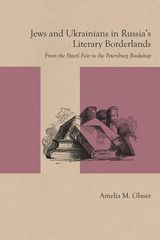 Jews and Ukrainians in Russia's Literary Borderlands: From the Shtetl Fair to the Petersburg Bookshop
Amelia M. Glaser
Northwestern University Press, 2011 Studies of Eastern European literature have largely confined themselves to a single language, culture, or nationality. In this highly original book, Glaser shows how writers working in Russian, Ukrainian, and Yiddish during much of the nineteenth century and the early part of the twentieth century were in intense conversation with one another. The marketplace was both the literal locale at which members of these different societies and cultures interacted with one another and a rich subject for representation in their art. It is commonplace to note the influence of Gogol on Russian literature, but Glaser shows him to have been a profound influence on Ukrainian and Yiddish literature as well. And she shows how Gogol must be understood not only within the context of his adopted city of St. Petersburg but also that of his native Ukraine. As Ukrainian and Yiddish literatures developed over this period, they were shaped by their geographical and cultural position on the margins of the Russian Empire. As distinctive as these writers may seem from one another, they are further illuminated by an appreciation of their common relationship to Russia. Glaser’s book paints a far more complicated portrait than scholars have traditionally allowed of Jewish (particularly Yiddish) literature in the context of Eastern European and Russian culture.
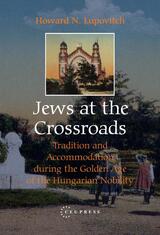 Jews at the Crossroads: Tradition and Accomodation during the Golden Age of the Hungarian Nobility
Howard N. Lupovitch
Central European University Press, 2007 Examines the social and political history of the Jews of Miskolc-the third largest Jewish community in Hungary-and presents the wider transformation of Jewish identity during the eighteenth and nineteenth centuries. It explores the emergence of a moderate, accommodating form of traditional Judaism that combined elements of tradition and innovation, thereby creating an alternative to Orthodox and Neolog Judaism. This form of traditional Judaism reconciled the demands of religious tradition with the expectations of Magyarization and citizenship, thus allowing traditional Jews to be patriotic Magyars. By focusing on Hungary, this book seeks to correct a trend in modern Jewish historiography that views Habsburg Jewish History as an extension of German Jewish History, most notably with regard to emancipation and enlightenment. Rather than trying to fit Hungarian Jewry into a conventional Germano-centric taxonomy, this work places Hungarian Jews in the distinct contexts of the Habsburg Monarchy and the Danube Basin, positing a more seamless nexus between the eighteenth and nineteenth century. This nexus was rooted in a series of political experiments by Habsburg sovereigns and Hungarian noblemen that culminated in civic equality, and in the gradual expansion of traditional Judaism to meet the challenges of the age.
|
|
